Last 5 years IPCB publications
From 2021
: 103 publications on ISI journals
1) Binary and Ternary Nanocomposite Membranes for Gas Separation Incorporating Finely Dispersed Carbon Nanotubes in a Polyether Block Amide Matrix
D.Vuono, G.Clarizia, D.Zampino, P.Bernardo
Polymers
17(3),
314
- 2025
DOI:
https://doi.org/10.3390/polym17030314
This work addressed the fine dispersion of Multiwalled Carbon Nanotubes (MWCNTs) in a polymer matrix to obtain Mixed Matrix Membranes (MMMs) suited for gas separation. Not-purified MWCNTs were effectively loaded within a polyether block amide (Pebax®2533) matrix, up to 24 wt%, using ultrasonication as well as a third component (polysorbate) in the dope solution. The obtained flexible thin films were investigated in terms of morphology, thermal properties, characterized by SEM, FT-IR, DSC, TGA, and gas permeation tests. The response to temperature variations of gas permeation through these nanocomposite specimens was also investigated in the temperature range of 25?55 °C. Defect-free samples were successfully obtained even at a significantly high loading of CNTs (up to 18 wt%), without a pre-treatment of the fillers. A remarkable enhancement of gas permeability upon the nanocarbons loading was reached, with a threshold value at a loading of ca. 7 wt%. The addition of polysorbates in the ternary MMMs further improves the dispersion of the filler, enhancing also the permselectivity of the membrane.
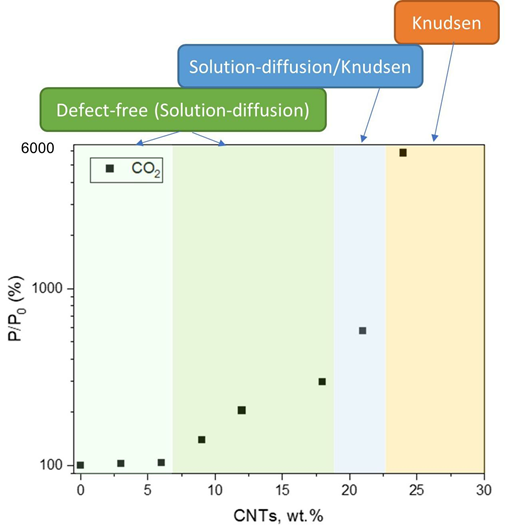
2) Cyclodextrin-based iodophors with high iodine retention in solid state and in dilute solutions
F.Spitaleri, S.Dattilo, D.Aleo, M.G.Saita, A.Patti
Carbohydrate Polymers
349,
122969
- 2025
DOI:
https://doi.org/10.1016/j.carbpol.2024.122969
Iodine is a broad-spectrum antiseptic with the advantage of not inducing bacterial resistance, but its use is limited by volatility. This issue can be overcome by using "iodophors", which are molecular systems able to retain iodine and provide its sustained release. Cyclodextrins have proven effective in stabilizing iodine in solution through the formation of complexes, the preparation of which in solid form could offer additional benefits in terms of handling and storage. A series of cyclodextrins (CD) were tested for their ability to form solid complexes with iodine and it was found that the addition of potassium iodide in the solid-state preparation of the complexes significantly increases both iodine incorporation and long-term stability compared to the solids obtained without added potassium iodide. Dilute aqueous solutions of the obtained complexes were monitored for their iodine content in different conditions and excellent stability was observed in some cases. Furthermore, these cyclodextrin-iodine complexes showed no cytotoxic effects on human corneal epithelial cells (HCE-2) while displayed very high antimicrobial (against
Staphylococcus epidermis) and antiviral (against Human adenovirus 5) activities. These findings highlight the potential of cyclodextrins as a versatile platform for the development of solid iodophors as an alternative to the traditional povidone-iodide formulation.
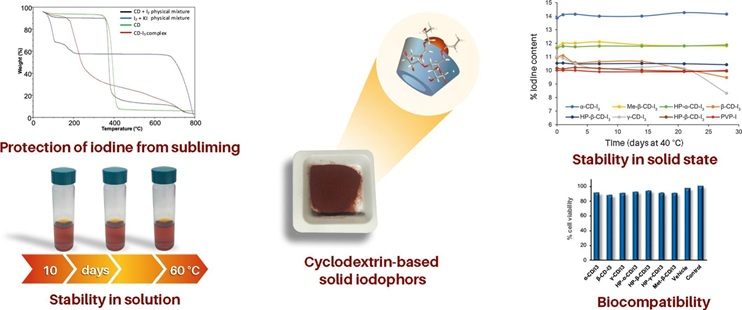
3) Calixarene-based cryopolymers: a versatile smart materials platform suitable for both air and water remediation
V.Giglio, S.Dattilo, G.Gambera, P.Riccobene, F.Cunsolo, T.Mecca
Environmental Research
279,
121736
- 2025
DOI:
https://doi.org/10.1016/j.envres.2025.121736
Environmental pollution caused by the release of hazardous chemicals into air and water poses serious risks to ecosystems, public health, and infrastructure. Addressing these challenges requires innovative materials capable of both detecting and removing diverse pollutants. However, most current materials are designed to target either air or water pollutants, leaving a gap in multifunctional solutions. This study presents a pioneering approach to bridge this gap by introducing two novel calixarene-based cryopolymers, combining the macroporous structure of cryogels with the recognition capabilities of calixarenes. The synthesized materials were found to be valuable tools for detecting and capturing pollutants in both air and water, taking advances from a dual mechanism of absorption: by chelation through the acidic functionality inserted on calixarene scaffold and by a host-guest complex formation with calixarene cavity through cation-p interactions. As an additional advantageous property, they have the ability to detect the presence of NO
2 in the air through an evident color change. These multifunctional materials represent a breakthrough in environmental remediation, offering a single platform for addressing pollutants in air and water, marking a step forward in pollution management technologies.
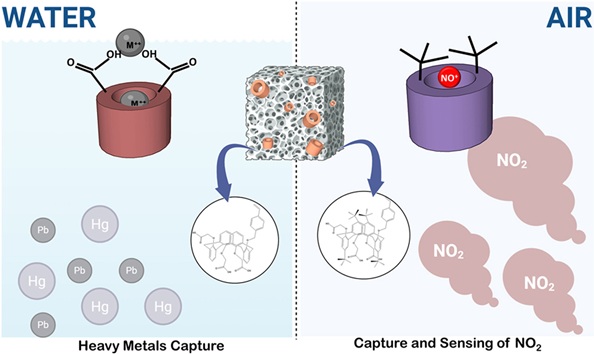
4) From red to green: Smart thiol-porphyrin cryogels combining high mercury efficiency removal and visual material saturation alert
G.Proietto Salanitri, T.Mecca, S.Carroccio, D.Caretti, F.Cunsolo, G.Impellizzeri, S.Dattilo
European Polymer Journal
233,
113982
- 2025
DOI:
https://doi.org/10.1016/j.eurpolymj.2025.113982
A novel and smart methacrylic acid (MAA) based macroporous material functionalized with thiol groups (-SH) was developed to achieve highly efficient and selective removal of toxic Hg(II) ions from water. With the aim of visualizing the saturation of the active sites of the material in real-time, a porphyrin-based co-monomer was synthesized and included (only 0.25 % w/w) as a part of the co-polymeric structure. The porphyrin ring can capture Hg(II) ions, causing a color change from red to green. However, due to the higher affinity of Hg(II) towards thiol groups, the porphyrin will be able to interact with free Hg(II) only when the adjacent thiols are no longer available and, therefore, close to the complete saturation of -SH sites. The color shift alerts that the material is approaching saturation, hence, a regeneration step is necessary for subsequent adsorption cycles. The typical interconnected macroporous (3?23 µm) network of the cryogel allows fast water diffusion and easy access to the -SH and PORPH sites. Such design achieves an exceptional Hg(II) adsorption capacity (Q
max > 1200 mg/g), calculated from the Langmuir isotherm model. The synthesized material shows high selectivity towards Hg(II) (S% > 95%) in a solution with the simultaneous presence of other metal cation species. The kinetics of Hg(II) capture, pH behavior, material dosage, and regeneration cycles were tested, highlighting its potential applicability across a broad pH range and its reusability for at least five cycles. These combined features underscore the superior performance of this advanced material compared to current state-of-the-art competitors.
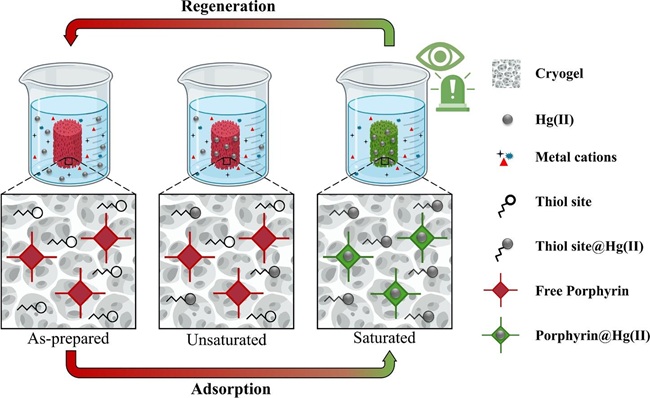
5) Solar-promoted photo-thermal CO2 methanation on SiC/hydrotalcites-derived catalysts
R.Fiorenza, L.Calantropo, E.La Greca, L.F.Liotta, A.Gulino, A.Ferlazzo, M.G.Musumeci, G.Proietto Salanitri, S.Carroccio, G.Dativo, M.T.Armeli Iapichino, S.Scirè, G.Impellizzeri
Catalysis Today
449,
115182
- 2025
DOI:
https://doi.org/10.1016/j.cattod.2024.115182
The photothermo-catalysis is a combined multicatalytic approach that allows to overcome some drawbacks of the respective single catalytic processes as the thermocatalysis and the photocatalysis. In this work, to efficiently exploit the potentiality of the solar photothermo-catalysis, SiC/hydrotalcites-derived catalysts were prepared with a simple hydrothermal method to exploit both the thermocatalytic properties of the formed multifunctional mixed oxides and the photo(thermo)-catalytic features of the silicon carbide. Two different hydrotalcite-derived catalysts were prepared, one with Mg-Co ions and another with Zn-Co ions. This latter sample, after the addition of SiC, showed the best performance in the CO
2 methanation reaction, with a CH
4 selectivity maximum of 71 % in the photothermal conditions at 250 °C, strongly improving the performance of the thermocatalysis (36 % at 350 °C). The presence of SiC permitted to increase the harvesting of the solar light, to modify the basic sites of the hydrotalcite-derived catalysts, allowing an efficient CO
2 activation, and to generate self-heating effects that enhanced the photo-driven thermocatalysis. Moreover, the formation of photocatalytic active species as the ZnO and the ZnAl
2O
4 after the calcination of the corresponding hydrotalcite precursor, led to exploit additional photocatalytic contributions to further increase the catalytic activity in the photo-promoted thermocatalytic CO
2 conversion into methane. The high versatility and the several synergisms generated by the application of this hybrid catalysis with these peculiar SiC/hydrotalcite-derived catalysts can be a sustainable strategy to efficiently valorise the carbon dioxide.
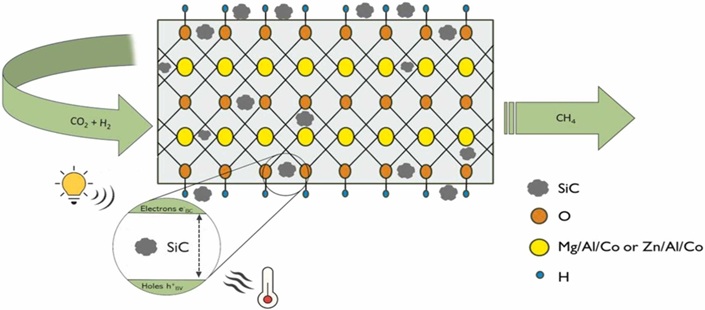
6) Advanced cyclodextrin-based multiloaded hydrogels for targeted drug delivery in the fight against vaginal fungal infections
E.G.Tomarchio, C.Zagni, S.Dattilo, L.Vitiello, V.Fuochi, S.Furnari, P.M.Furneri, G.Granata, S.Carroccio, A.Rescifina
Carbohydrate Polymers
356,
123412
- 2025
DOI:
https://doi.org/10.1016/j.carbpol.2025.123412
Vulvovaginal candidiasis (VVC) affects a significant proportion of women during reproductive years, with recurrent infections posing a considerable therapeutic challenge. Conventional treatments, such as clotrimazole (Clo) administration, often require frequent application due to low aqueous solubility and rapid clearance.
To address these issues, a novel hydrogel-based drug delivery system (DDS) was developed, combining β-cyclodextrins (β-CD) for Clo encapsulation and halloysite nanotubes (HNT) for curcumin (Cur) delivery. A novel hydrogel-based drug delivery system (DDS) was developed to address these limitations to enhance drug solubility, retention, and localized release. β-CD enhanced Clo’s solubility and prolonged antifungal effects, while HNT ensured sustained Cur release for up to 5 days, offering anti-inflammatory, antioxidant, and antimicrobial benefits. The hydrogel matrix improved drug retention and stability, with HNT reinforcing its mechanical properties for durability under moderate strain. Microbiological tests demonstrated potent antifungal activity, with inhibition zones of 39.2 ± 0.2 mm, 39.1 ± 0.2 mm, and 42.1 ± 0.2 mm against
C. krusei,
C. albicans 10231, and
C. parapsilosis 22019, respectively. Drug release studies revealed a rapid burst release of Clo within the first 30 min, followed by prolonged Cur release. This dual-action hydrogel targets fungal infections, oxidative stress, and inflammation, providing enhanced therapeutic outcomes and improved patient adherence.
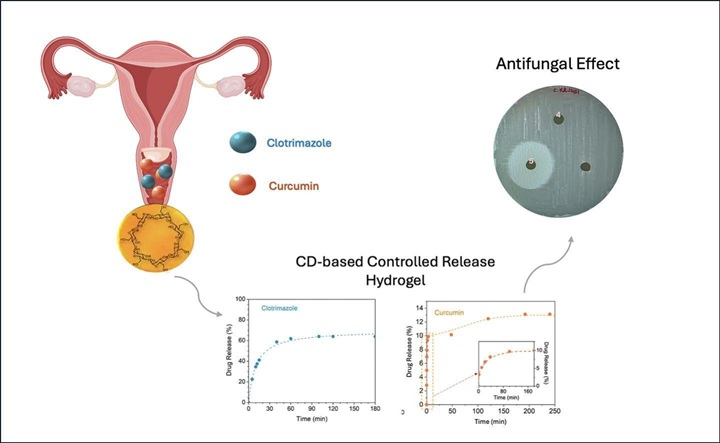
7) Preservation mechanisms of jute fibers derived cellulose nanofibril composite films for banana storage: effects of chemical composition and particle size
W.Yu, L.Luo, Z. Tang, P.Rizzarelli, G.Santagata, Z.Tan
Cellulose
32,
3877-3897
- 2025
DOI:
https://doi.org/10.1007/s10570-025-06481-3
Nanocellulose is emerging as a biodegradable alternative to synthetic plastics in food packaging, but the preservation mechanisms of nanocellulose composite films have not yet been understood clearly enough. In this study, the preservation mechanism of jute fibers derived cellulose nanofibril (CNF) coatings for banana storage was explored in terms of both chemical composition and particle size. In terms of chemical composition, the CNF coating prepared from raw jute fibers was most suited for use in banana storage, mainly due to its higher antioxidant and UV protection properties. In terms of particle size, the CNF coating homogenized for 5 passes achieved the best performance in preserving the freshness of bananas, mainly owing to its better oxygen barrier properties. The possible preservation mechanism of jute fibers derived CNF composite films for banana storage is related to the formation of a highly dense structure attributed to the strong hydrogen bonding between cellulose molecules and the plugging effect of noncellulosic components, offering excellent antioxidant, UV resistance, and oxygen barrier properties. This paper provides scientific guidance for the design of nanocellulose composite films for food packaging.
8) Glycosylation Pathways Targeted by Deregulated miRNAs in Autism Spectrum Disorder
F.Mirabella, M.Randazzo, A.Rinaldi, F.Pettinato, R.Rizzo, L.Sturiale, R.Barone
International Journal of Molecular Sciences
26(2),
783
- 2025
DOI:
https://doi.org/10.3390/ijms26020783
Autism Spectrum Disorder (ASD) is a complex condition with a multifactorial aetiology including both genetic and epigenetic factors. MicroRNAs (miRNAs) play a role in ASD and may influence metabolic pathways. Glycosylation (the glycoconjugate synthesis pathway) is a necessary process for the optimal development of the central nervous system (CNS). Congenital Disorders of Glycosylation (CDGs) (CDGs) are linked to over 180 genes and are predominantly associated with neurodevelopmental disorders (NDDs) including ASD. From a literature search, we considered 64 miRNAs consistently deregulated in ASD patients (ASD-miRNAs). Computational tools, including DIANA-miRPath v3.0 and TarBase v8, were employed to investigate the potential involvement of ASD-miRNAs in glycosylation pathways. A regulatory network constructed through miRNet 2.0 revealed the involvement of these miRNAs in targeting genes linked to glycosylation. Protein functions were further validated through the Human Protein Atlas. A total of twenty-five ASD-miRNAs were identified, including nine miRNAs that were differentially expressed in cells or brain tissue in ASD patients and associated with glycosylation pathways, specifically protein N- and O-glycosylation and glycosaminoglycan biosynthesis (heparan sulfate). A number of CDG genes and/or ASD-risk genes, including DOLK, GALNT2, and EXT1, were identified as targets, along with validated interactions involving four key miRNAs (hsa-miR-423-5p, hsa-miR-30c-5p, hsa-miR-195-5p, and hsa-miR-132-5p). B4GALT1, an ASD susceptibility gene, emerged as a central regulatory hub, reinforcing the link between glycosylation and ASD. In sum, the evidence presented here supports the hypothesis that ASD-miRNAs mediate the epigenetic regulation of glycosylation, thus unveiling possible novel patho-mechanisms underlying ASD.
9) Chemical Recycling of Bio-Based Epoxy Matrices Based on Precursors Derived from Waste Flour: Recycled Polymers Characterization
L.Saitta, S.Dattilo, G.Rizzo, C.Tosto, I.Blanco, F.Ferrari, G.A.Carallo, F.Cafaro, A.Greco, G.Cicala
Polymers
17(3),
335
- 2025
DOI:
https://doi.org/10.3390/polym17030335
This study aims to investigate the chemical recycling of two different fully recyclable bio-based epoxy matrices based on epoxidized precursors derived from waste flour. The key for their recyclability relies on the use of a cleavable hardener. In fact, the latter contains a ketal group in its chemical structure, which is cleavable in mild acetic conditions, so allowing for the breakage of the cured network. The recyclability was successfully assessed for both the two investigated formulations, with a recycling process yield ranging from 80 up to 85%. The recycled polymers presented a Tg up to 69.0 ± 0.4 °C, determined by mean of DMA and DSC analysis. Next, the TGA revealed that the thermal decomposition of the specimens primarily occurred around 320 °C and attributed to the breaking of C-O and C-N bonds in cross-linked networks. In the end, the chemical characterizations were carried out by mean of Py-GC/MS, MALDI-TOF-MS and FT-IR ATR. In fact, these analyses allowed for investigating how the recycled polymer’s structure changed, starting from the initial epoxy systems. These insights on their chemical structure could further allow for identifying re-use strategies in accordance with a circular economy approach.
10) Designing a monolithic photo-Fenton catalyst using a fungal hydroxypyrone metabolic derivative
E.G.Tomarchio, V.Giglio, C.Zagni, S.Carroccio, V.Paratore, G.G.Condorelli, G.Floresta, S.Dattilo, A.Rescifina
Materials Today Chemistry
44,
102539
- 2025
DOI:
https://doi.org/10.1016/j.mtchem.2025.102539
In response to the growing demand for eco-friendly materials, derived from natural compounds for environmental applications, we developed an innovative catalyst based on kojic acid, a bio-derived metabolite produced by Aspergillus species. This work involved functionalizing the hydroxypyrone scaffold with an acrylic group, yielding a porous organic polymer (C-HPO) to remove hazardous metal. The resulting C-HPO exhibited exceptional chelating capacity for heavy metal ions, including mercury (Hg), copper (Cu), and iron (Fe), highlighting its potential for environmental remediation and resource recovery. Furthermore, by complexing C-HPO with iron ions, we created a photo-Fenton-like system (C-HPO/Fe), enabling its use in advanced oxidation processes. UV?Vis absorption analyses revealed that the C-HPO/Fe system efficiently degrades various emerging contaminants, including lomefloxacin (LOM), doxycycline (DOX), desethyl atrazine (DEA), and methylene blue (MB). Remarkably, as little as 1 g/L of the C-HPO/Fe catalyst achieved complete degradation of these pollutants, highlighting its high catalytic efficiency and promise for sustainable contaminant treatment.
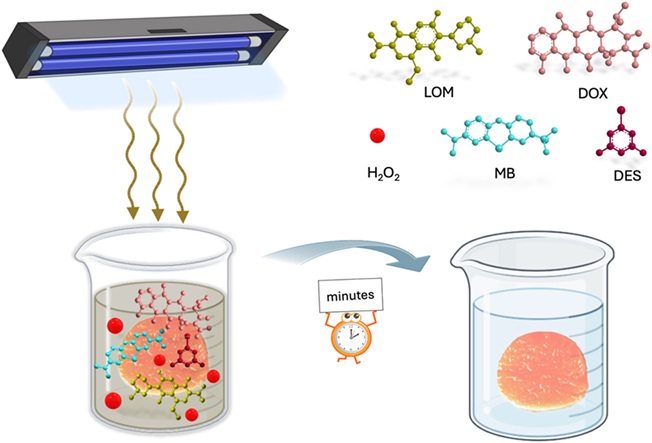
11) Sustainable biocomposites based on Mater-Bi and grape pomace for a circular economy: Performance evaluation and degradation in soil
V.Titone, M.Rapisarda, L.Pulvirenti, E.Napoli, G.Impallomeni, L.Botta, M.C.Mistretta, P.Rizzarelli
Polymer Degradation and Stability
231,
111091
- 2025
DOI:
https://doi.org/10.1016/j.polymdegradstab.2024.111091
Biodegradable polymers often exhibit inferior properties and higher cost compared to their fossil-derived counterparts. The addition of plant waste and by-products can improve their performances, providing in the meantime functional activity and reducing their cost. In this work, we summarize the preparation of different biocomposites (BioCs) incorporating two diverse amounts (10 % and 20 %) of grape pomace (GP) in a Mater-Bi (MB) sample. GP, MB as well as BioCs were fully characterized. The influence of addition of GP on the properties and degradation in soil of the biocomposites was evaluated in comparison with the neat MB. However, natural antioxidants and other active compounds from GP could be sensitive to temperature. Thus, GP and MB underwent heat treatment at 180 °C to simulate and induce possible degradation during BioCs processing. GP analysis (particle size 50 μm) showed only a slight decrease of antioxidant potency, despite the heat treatment simulating the BioCs processing.
1H NMR of the MB soluble fraction in CDCl
3 displayed the presence of two polymeric components: polylactide (PLA) and poly(butylene adipate-
co-butylene terephthalate) (PBAT). Introduction of GP in the polymer matrix induced a proportional increase of antioxidant property in the BioCs as well as in complex viscosity at low frequencies. Moreover, a slight increase in the elastic modulus was observed with increasing the crystallinity of the samples. Degradation rate in soil, monitored by weight loss, increased with filler content and time. Moreover, NMR showed that, in the recovered sample after 45 days, the composition of PBAT changed, with the terephthalic percentage increased
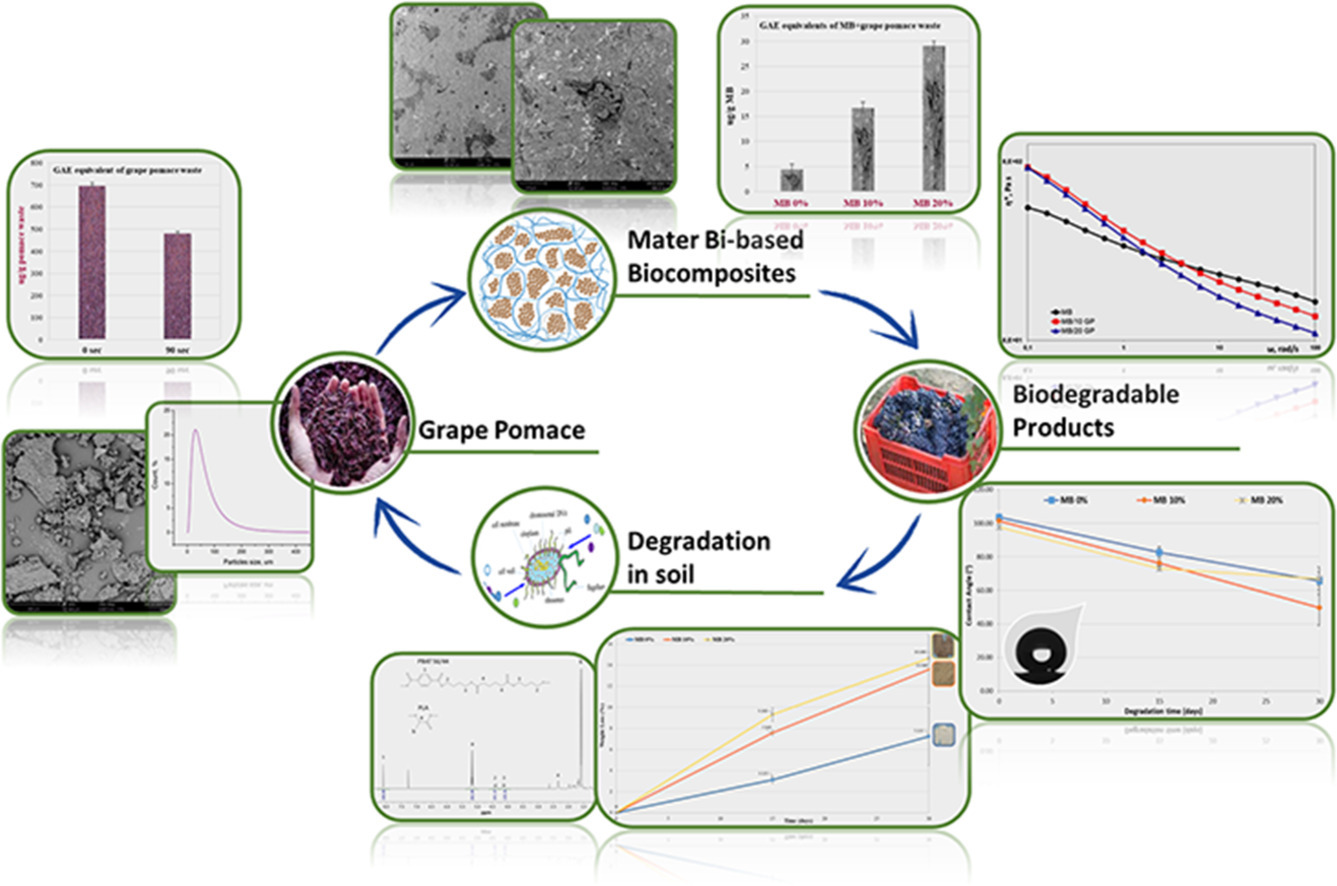
12) Enhancing mechanical properties of recycled sheet molding compound composites through catalytic and ozone activation
G.Rizzo, S.Dattilo, L.Saitta, C.Tosto, E.Pergolizzi, A.Latteri, G.Cicala
Polymer Composites
- 2024
DOI:
https://doi.org/10.1002/pc.29411
scraps or end-of-life product (EoL) of glass fiber reinforced polymer composites, such as sheet molding compound (SMC), without gravely impact on energy and costs. However, the resulting material is characterized by a discontinuous bulk, limiting its application to low-value products. In this study, a comprehensive characterization of composites made by fresh unsaturated polyester resin (UPR) and recycled SMC with a content from 10% up to 40% by weight (wt), was carried out. To enhance the chemical interactions between the inert recycled SMC and the fresh UPR, and as consequence their mechanical properties, two different transesterification catalysts, aluminum (III) sec-butoxide and titanium (IV) butoxide at 1.0 wt%, were utilized. To further investigate the interaction between SMC and fresh UPR, an ozone treatment was carried out on SMC before blending and all the composites compared with no-treated reference systems. Among the formulated composites, the one made by 40 wt% of SMC and titanium (IV) butoxide results to be the most performant system with a Tg around 137°C, a modulus of 3.7 GPa and strain at break around 1.42%. These results could innovate the manufacturing of recycled composites with superior mechanical properties, potentially used for applications such as cabinet, panels, or external cladding.
13) Bio-based palladium catalyst in cryogel for cross-coupling reactions
E.G.Tomarchio, C.Zagni, V.Paratore, G.G.Condorelli, S.Carroccio, A.Rescifina
Materials Chemistry Frontiers
8(21),
3558-3568
- 2024
DOI:
https://doi.org/10.1039/D4QM00800F
Biobased catalysts play a crucial role in sustainable chemistry, using natural resources to support eco-friendly processes. While palladium catalysts are essential for various industrial applications, they often pose environmental challenges due to their non-reusability and tendency to degrade. To address these issues, we developed an innovative phenylalanine-based catalyst containing palladium (C-PhebPd) designed for the Suzuki?Miyaura reaction. The natural amino acids, used as monomers, chelate palladium, preventing leaching, unlike other heterogeneous catalysts that use palladium nanoparticles, which can be released over time, leading to catalyst degradation. Such catalyst exhibits outstanding performance in aqueous media at moderate temperatures, facilitating cross-coupling reactions between various aryl halides and arylboronic acids with high yields of up to 99%. The affordable synthetic procedure and C-PhebPd’s stability make it potentially scalable for industrial applications. The robustness of this catalyst was also proved by recyclability tests up to seven cycles. Further investigation into its capabilities could unlock additional insights for various catalytic transformations.
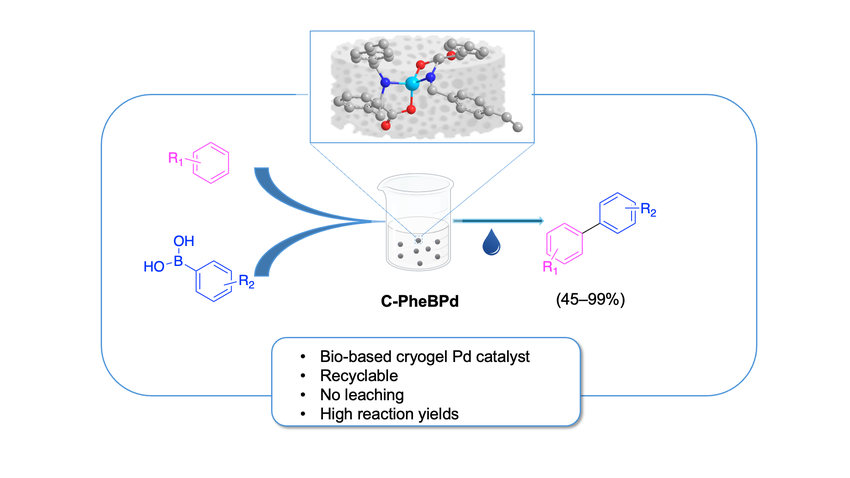
14) Polyvinylimidazole-Based Cryogel as an Efficient Tool for the Capture and Release of Oleuropein in Aqueous Media
V.Giglio, C.Zagni, E.Spina, F.Cunsolo, S.Carroccio
Polymers
16(16),
2339
- 2024
DOI:
https://doi.org/10.3390/polym16162339
A polyvinylimidazole-based cryogel is presented as a pioneering solution for efficient extraction and release of partially water-soluble polyphenols from olive byproducts. Specifically, oleuropein was used as model molecule to evaluate its recovery from water. The material merges the properties of interconnected cryogel structure in adsorbing molecules via fast diffusion flux, with the strong electrostatic interactions acted by imidazole moiety. Such cryogel achieves effective oleuropein binding likely through hydrogen bonding and π-π interactions. Comprehensive assessments of static adsorption kinetics, isotherms, and desorption kinetics underscore the cryogel’s efficacy in oleuropein extraction and release, highlighting its pivotal role in valorizing olive wastewater through sustainable biotechnological applications.
15) Efficient green solvent-free CO2/epoxide cycloaddition catalyzed by a β-cyclodextrin-imidazolium-based ionic liquid
E.G.Tomarchio, C.Zagni, R.Turnaturi, S.Dattilo, V.Patamia, G.Floresta, S.Carroccio, T.Mecca, A.Rescifina
Journal of Industrial and Engineering Chemistry
- 2024
DOI:
https://doi.org/10.1016/j.jiec.2024.08.024
The rising atmospheric carbon dioxide (CO
2) levels significantly contribute to climate change. Converting CO
2 into valuable products offers an attractive strategy to mitigate its environmental impact. Here, we present a highly efficient, solvent-free method for CO
2 fixation into cyclic carbonates using a novel green catalyst, β-cyclodextrin, linked to an imidazolium-based ionic liquid (β-CD-Im
+Br
-). This catalyst facilitates the conversion of various terminal and internal epoxides into cyclic carbonates with exceptional performance. Notably, β-CD-Im
+Br
- achieves up to 98% conversion of styrene oxide to its corresponding carbonate within 24h at 120°C, demonstrating significant activity without needing a co-catalyst. Operating under solvent-free conditions, this method avoids environmentally harmful synthetic pathways by utilizing the hydroxyl groups of cyclodextrins as hydrogen bond donors and employing the bromine counterion to facilitate epoxide ring opening. Mechanistic studies reveal that β-CD-Im
+Br
- enhances catalytic performance by lowering the activation energy of the rate-limiting step through its hydrogen bond acceptor properties. Importantly, the catalyst is both recyclable and reusable, highlighting its cost-effectiveness and environmental benefits. This approach represents a significant advancement in sustainable chemistry, offering a green alternative for CO
2 fixation.
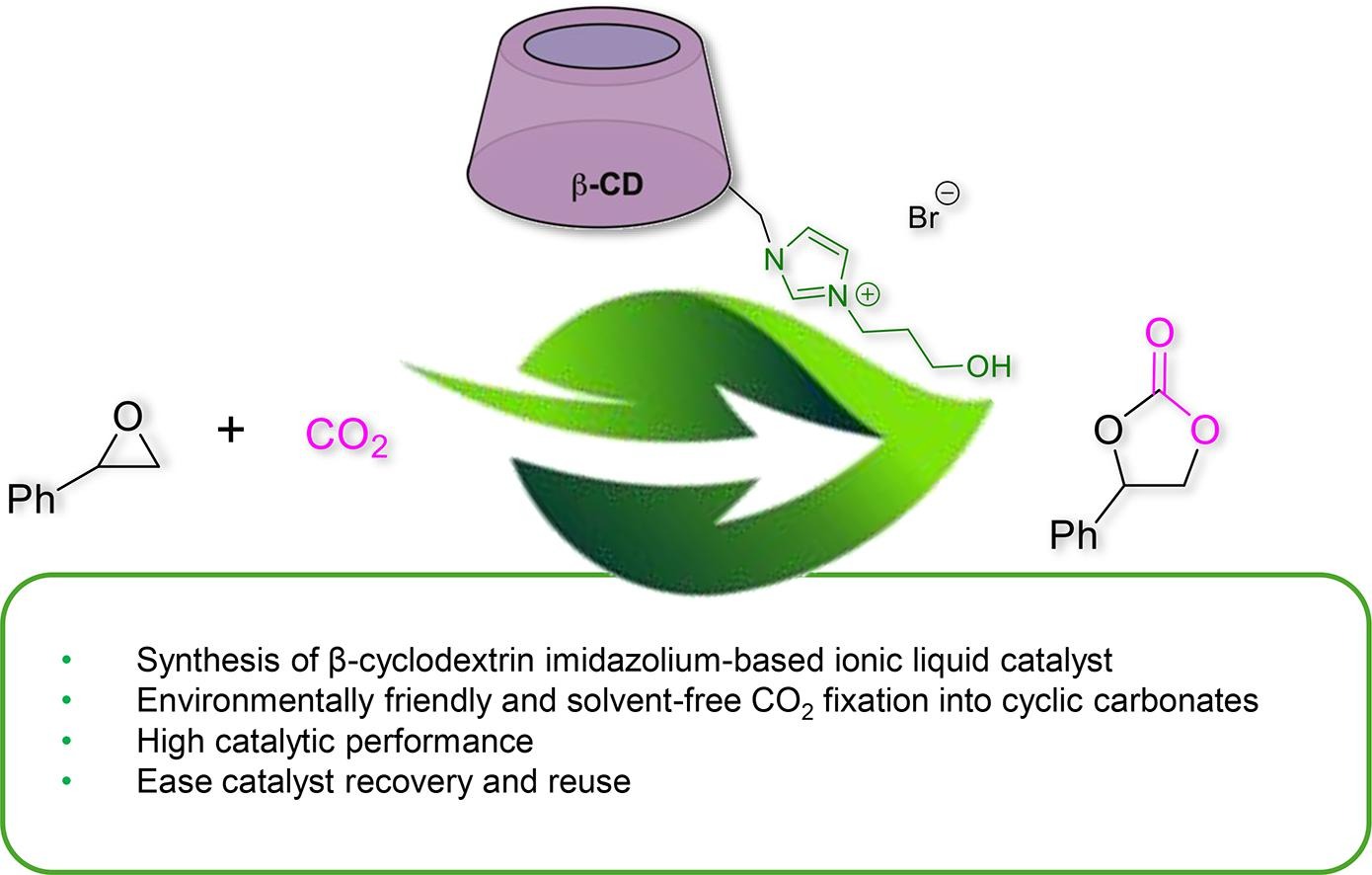
16) Cyclodextrin-based iodophors with high iodine retention in solid state and in dilute solutions
F.Spitaleri, S.Dattilo, D.Aleo, M.G.Saita, A.Patti
Carbohydrate Polymers
- 2024
DOI:
https://doi.org/10.1016/j.carbpol.2024.122969
Iodine is a broad-spectrum antiseptic with the advantage of not inducing bacterial resistance, but its use is limited by volatility. This issue can be overcome by using "iodophors", which are molecular systems able to retain iodine and provide its sustained release. Cyclodextrins have proven effective in stabilizing iodine in solution through the formation of complexes, the preparation of which in solid form could offer additional benefits in terms of handling and storage. A series of cyclodextrins (CD) were tested for their ability to form solid complexes with iodine and it was found that the addition of potassium iodide in the solid-state preparation of the complexes significantly increases both iodine incorporation and long-term stability compared to the solids obtained without added potassium iodide. Dilute aqueous solutions of the obtained complexes were monitored for their iodine content in different conditions and excellent stability was observed in some cases. Furthermore, these cyclodextrin-iodine complexes showed no cytotoxic effects on human corneal epithelial cells (HCE-2) while displayed very high antimicrobial (against
Staphylococcus epidermis) and antiviral (against Human adenovirus 5) activities. These findings highlight the potential of cyclodextrins as a versatile platform for the development of solid iodophors as an alternative to the traditional povidone-iodide formulation.
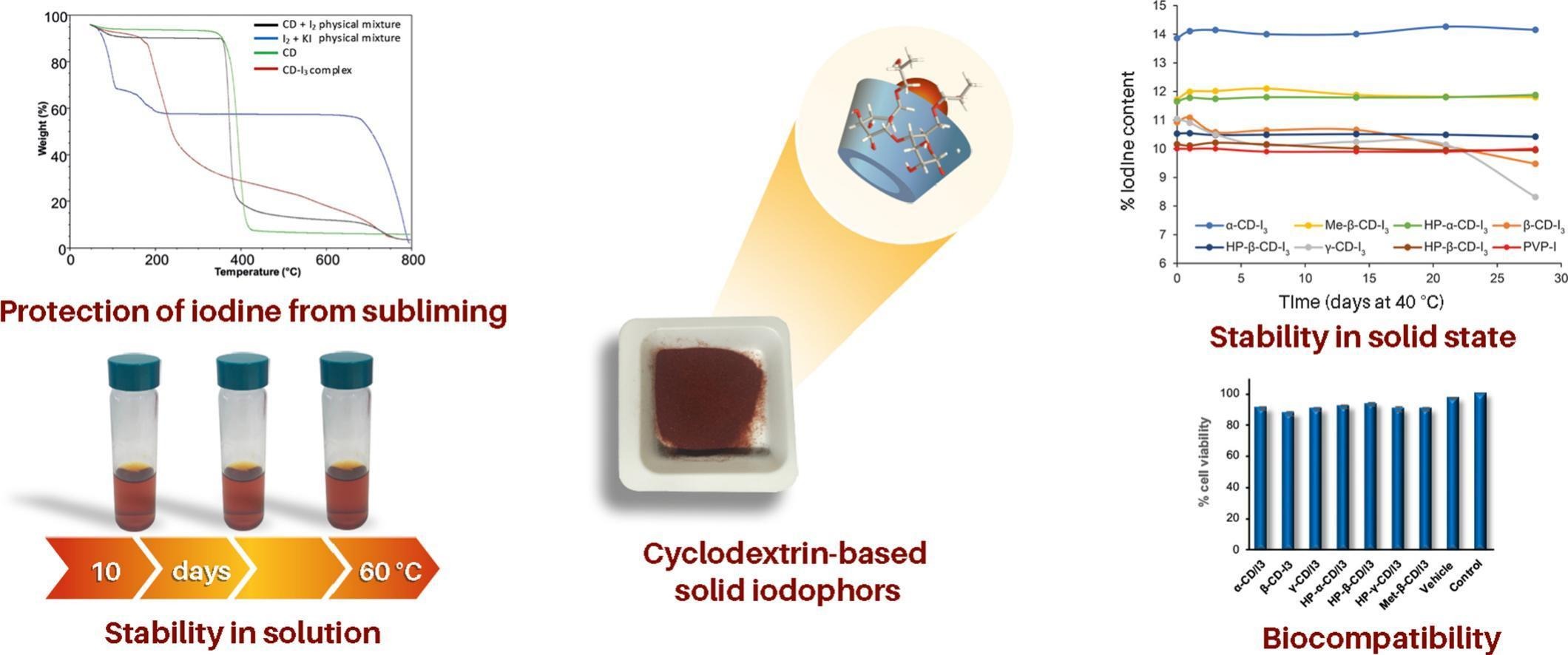
17) Biodegradation of Polystyrene by Plastic-Eating Tenebrionidae Larvae
E.A.Di Liberto, G.Battaglia, R.Pellerito, G.Curcuruto, N.Tz.Dintcheva
Polymers
16(10),
1404
- 2024
DOI:
https://doi.org/10.3390/polym16101404
Polystyrene (PS) is an extremely stable polymer with a relatively high molecular weight and a strong hydrophobic character that makes it highly resistant to biodegradation. In this study, PS was subjected to biodegradation tests by
Tenebrio Molitor (T. Molitor) and
Zophobas Morio (Z. Morio) larvae. Specifically, six different experimental diets were compared: (i)
T. Molitor fed with bran; (ii)
T. Molitor fed only PS; (iii)
T. Molitor fed only PS treated with H
2O
2; (iv)
Z. Morio fed with bran; (v)
Z. Morio fed only PS; and (vi)
Z. Morio fed only PS treated with H
2O
2. Therefore, the mass change of the larvae and the survival rate were measured periodically, while the frass collected after 15 and 30 days was analyzed by different analyses, such as spectroscopy (FTIR), spectrometry (molecular weight and polydispersity), thermal analysis (TGA) and microscopy (scanning electron microscopy observations). The obtained results suggest that in the case of
T. Molitor larvae, larvae feeding on bran showed the highest survival rate of ∼94% at 30 days, while in the case of the
Z. Morio larvae, the highest survival rate was exhibited by larvae eating PS-H
2O
2. Although not strongly pronounced, the M
w and M
n of PS in the frass of both
T. Molitor and
Z. Morio larvae decreased over 30 days, suggesting PS biodegradation. Finally, the morphological analysis shows that PS samples isolated from the frass of
T. Molitor and
Z. Morio larvae showed completely different, rough and irregularly carved surface structures, in comparison to PS before biodegradation.
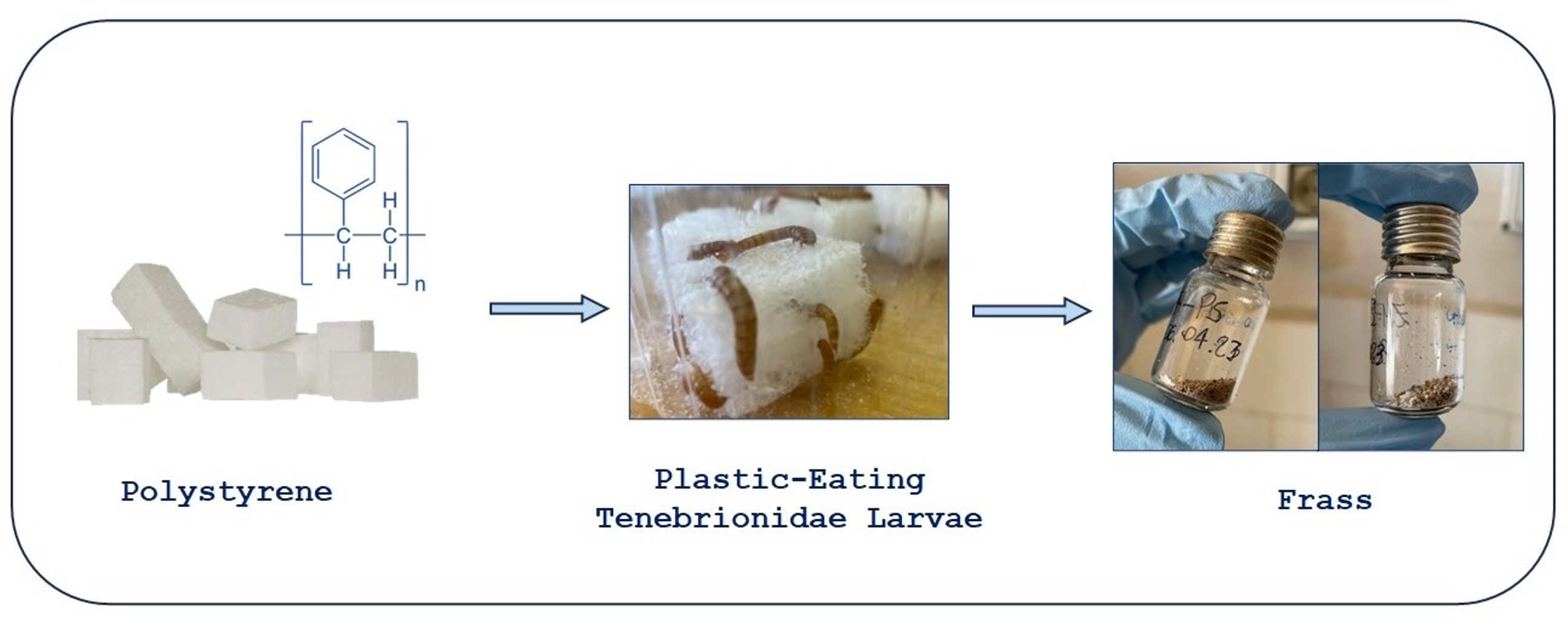
18) A simple rheological method for the experimental assessment of the fiber percolation threshold in short fiber biocomposites
L.Vitiello, M.Salzano de Luna, V.Ambrogi, G.Filippone
Composites Science and Technology
245,
110345
- 2024
DOI:
https://doi.org/10.1016/j.compscitech.2023.110345
The identification of the percolation threshold (Φc) in short fiber composites is a challenging problem in Composite Science. Above Φc the fibers form a continuous network that causes substantial changes in mechanical and transport properties. Besides, percolation of natural fibers in biodegradable polymer matrices allows water and other pro-degradative species to access the inner parts of the material from the external environment, accelerating biodegradation. Whether such a speeding up is desired or not, assessing Φc in composites is of utmost importance. Unfortunately, natural fibers are not conductive and exhibit highly variable shape and physical properties. This prevents the use of many experimental and theoretical approaches for the estimate of Φc. Here we propose an original rheological approach borrowed from the viscoelastic modelling of polymer nanocomposites. The method was applied to two systems made of poly(lactic acid) filled with hemp or kenaf fibers (average length <500μm, average length-to-diameter ratio <5). The estimate of Φc (∼10.1 and 19.5 vol% for the hemp- and kenaf-based composite, respectively) required a single set of simple linear viscoelastic measurements, and the computed values were in good agreement with those obtained through time-consuming (measurement times >3 weeks) dielectric spectroscopy analyses (∼10.1 and 18.5 vol%).
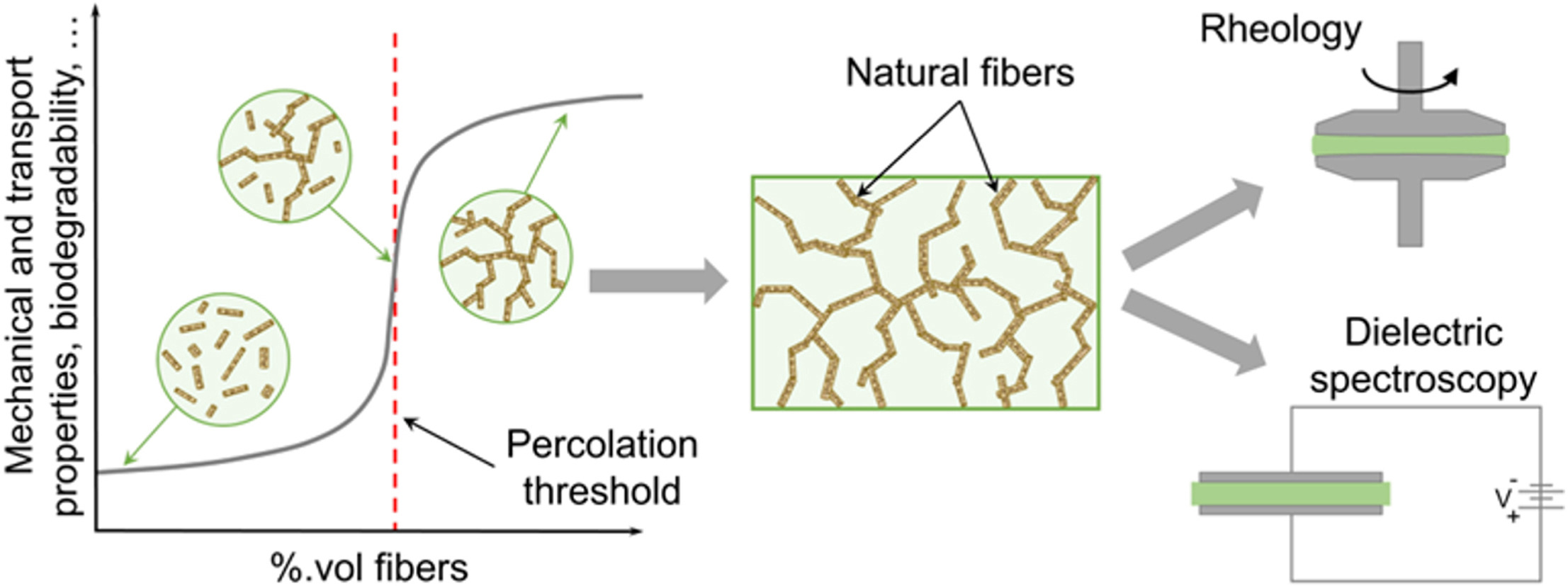
19) Understanding the Effects of Adding Metal Oxides to Polylactic Acid and Polylactic Acid Blends on Mechanical and Rheological Behaviour, Wettability, and Photo-Oxidation Resistance
E.Morici, G.Pecoraro, S.Carroccio, E.Bruno, P.Scarfato, G.Filippone, N.Tz Dintcheva
Polymers
16(7),
922
- 2024
DOI:
https://doi.org/10.3390/polym16070922
Biopolymers are of growing interest, but to improve some of their poor properties and performance, the formulation of bio-based blends and/or adding of nanoparticles is required. For this purpose, in this work, two different metal oxides, namely zinc oxide (ZnO) and titanium dioxide (TiO2), at different concentrations (0.5, 1, and 2%wt.) were added in polylactic acid (PLA) and polylactic acid/polyamide 11 (PLA/PA11) blends to establish their effects on solid-state properties, morphology, melt behaviour, and photo-oxidation resistance. It seems that the addition of ZnO in PLA leads to a significant reduction in its rigidity, probably due to an inefficient dispersion in the melt state, while the addition of TiO2 does not penalize PLA rigidity. Interestingly, the addition of both ZnO and TiO2 in the PLA/PA11 blend has a positive effect on the rigidity because of blend morphology refinement and leads to a slight increase in film hydrophobicity. The photo-oxidation resistance of the neat PLA and PLA/PA11 blend is significantly reduced due to the presence of both metal oxides, and this must be considered when designing potential applications. The last results suggest that both metal oxides could be considered photo-sensitive degradant agents for biopolymer and biopolymer blends.
20) TiO2-MoS2-PMMA Nanocomposites for an Efficient Water Remediation
V.Spanò, M.Cantarella, M.Zimbone, F.Giuffrida, G.Sfuncia, G.Nicotra, A.Alberti, S.Scalese, L.Vitiello, S.Carroccio, G.Impellizzeri
Polymers
16(9),
1200
- 2024
DOI:
https://doi.org/10.3390/polym16091200
An improvement of water supply and sanitation and better management of water resources, especially in terms of water reuse, is one of the priorities of the European Green Deal. In this context, it is crucial to find new strategies to recycle wastewater efficiently in a low-cost and eco-friendly manner. The immobilization of inorganic nanomaterials on polymeric matrices has been drawing a lot of attention in recent years due to the extraordinary properties characterizing the as-obtained nanocomposites. The hybrid materials, indeed, combine the properties of the polymers, such as flexibility, low cost, mechanical stability, high durability, and ease of availability, with the properties of the inorganic counterpart. In particular, if the inorganic fillers are nanostructured photocatalysts, the materials will be able to utilize the energy delivered by light to catalyze chemical reactions for efficient wastewater treatment. Additionally, with the anchoring of the nanomaterials to the polymers, the dispersion of the nanomaterials in the environment is prevented, thus overcoming one of the main limits that impede the application of nanostructured photocatalysts on a large scale. In this work, we will present nanocomposites made of polymers, i.e., polymethyl methacrylate (PMMA), and photocatalytic semiconductors, i.e., TiO
2 nanoparticles (Evonik). MoS
2 nanoflakes were also added as co-catalysts to improve the photocatalytic performance of the TiO
2. The hybrid materials were prepared using the sonication and solution casting method. The nanocomposites were deeply characterized, and their remarkable photocatalytic abilities were evaluated by the degradation of two common water pollutants: methyl orange and diclofenac. The relevance of the obtained results will be discussed, opening the route for the application of these materials in photocatalysis and especially for novel wastewater remediation.
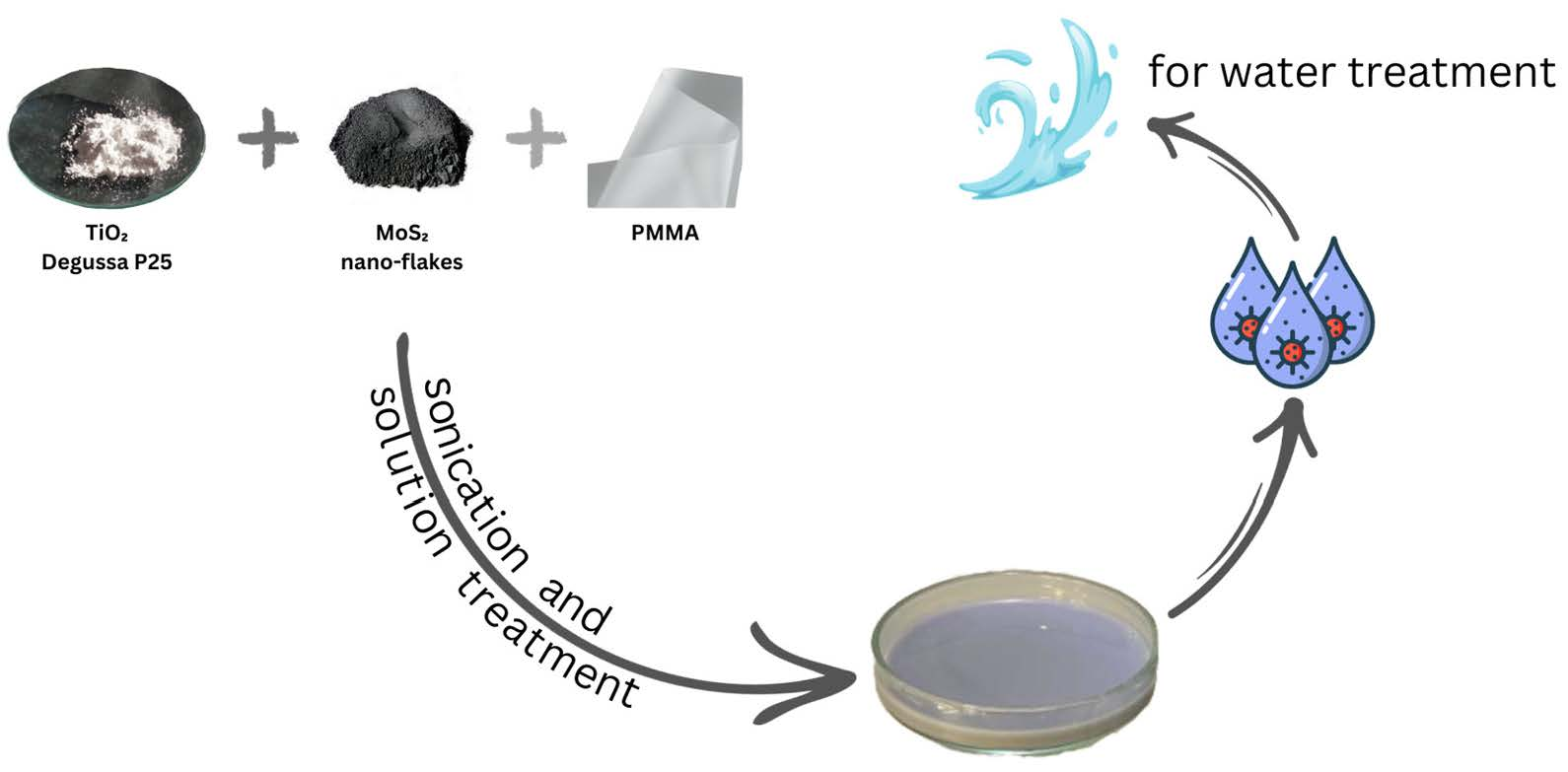
21) Photoaging of polystyrene-based microplastics amplifies inflammatory response in macrophages
N.Aloi, A.Calarco, G.Curcuruto, M.Di Natale, G.Augello, S.Carroccio, P.Cerruti, M.Cervello, A.Cuttitta, P.Colombo, V.Longo
Chemosphere
364,
143131
- 2024
DOI:
https://doi.org/10.1016/j.chemosphere.2024.143131
The continuous release of municipal and industrial products into the environment poses a growing concern for public health. Among environmental pollutants, polystyrene (PS) stands out as a primary constituent of environmental plastic waste, given its widespread use and high production rates owing to its durability and user-friendly properties. The detection of polystyrene microparticles (PS-MPs) in various living organisms has been well-documented, posing a serious threat due to their potential passage into the human ecosystem. In this manuscript, we aimed to study the toxicological effects of low concentrations of pristine and photoaged PS-MPs in a murine macrophage cell line. To this purpose, PS-MPs were photoaged by indoor exposure to visible light to simulate environmental weathering due to solar irradiation (PS-MPs
3h). Physical characterization revealed that the irradiation treatment results in particle degradation and the possible release of nanoparticles. Monocultures of the RAW264.7 cell line were then exposed to PS-MPs and PS-MPs
3h at concentrations comparable to experimental measurements from biological samples, to assess cytotoxicity, intracellular oxidative stress, primary genotoxicity, and inflammatory effects. Significant toxicity-related outcomes were observed in cells treated with both pristine PS-MPs and PS-MPs
3h even at low concentrations (0,10 μg/ml and 1 μg/ml). PS-MPs
3h exhibited greater adverse effects compared to PS-MPs, including reduced cell viability, increased ROS production, elevated DNA damage, and upregulation of IL-6 and NOS2 gene expression. Therefore, we can conclude that changes induced by environmental aging in the physicochemical composition of PS microplastics play a crucial role in the adverse health outcomes associated with microplastic exposure.
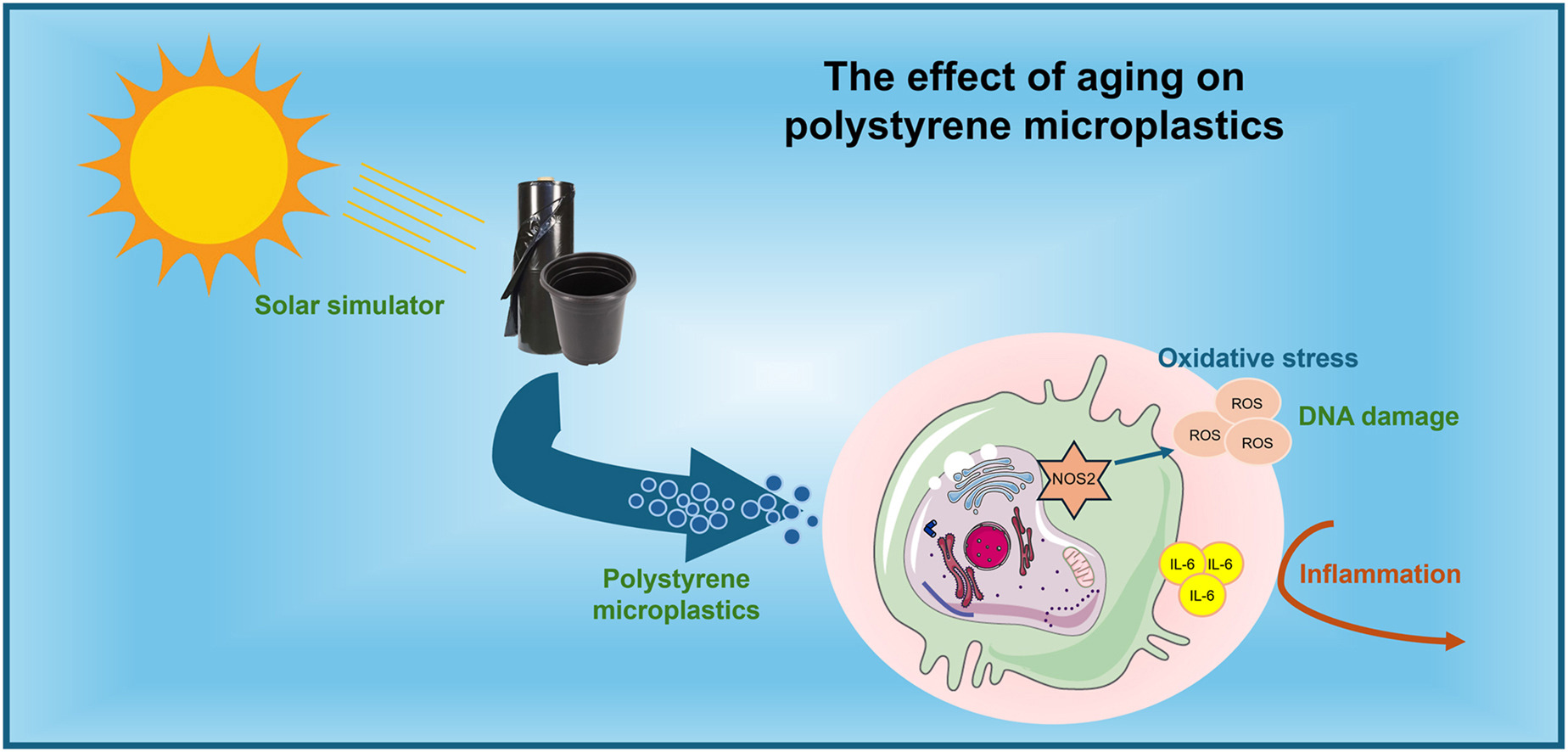
22) Degradation kinetics of PLA/hemp biocomposites: Tradeoff between nucleating action and pro-hydrolytic effect of natural fibers
L.Vitiello, S.Carroccio, V.Ambrogi, E.Podda, G.Filippone, M.Salzano de Luna
Composites Science and Technology
257,
110806
- 2024
DOI:
https://doi.org/10.1016/j.compscitech.2024.110806
Natural fibers are not only a sustainable alternative to synthetic reinforcement materials, but can also be used to produce truly sustainable biocomposites with fast degradation kinetics. Indeed, due to their hygroscopicity, lignocellulosic fibers allow water and/or degrading organisms from the external environment to penetrate inside the host matrix and trigger its hydrolysis. The latter is the rate-limiting step for the degradation of bio-polyesters, which exhibit unacceptably slow degradation kinetics at ambient temperature and humidity. However, fibers also promote crystallization of the host matrix and thus slow down its degradation kinetics. To better understand and potentially control the degradation kinetics of biocomposites, here we investigate the ability of hemp shives, a hygroscopic by-product of hemp fiber production, to accelerate the hydrolysis of poly (lactic acid) (PLA). The degradation kinetics and degree of crystallinity of PLA are monitored in water and mature compost as a function of fiber content, which was varied across the percolation threshold (Φc) to study the effect of fiber interconnectivity. Above Φc, the fibers accelerate PLA hydrolysis in water despite their nucleating effect. Conversely, in compost the shielding effect of fiber-induced crystallinity prevails, and the fibers eventually slow down the degradation kinetics of PLA.
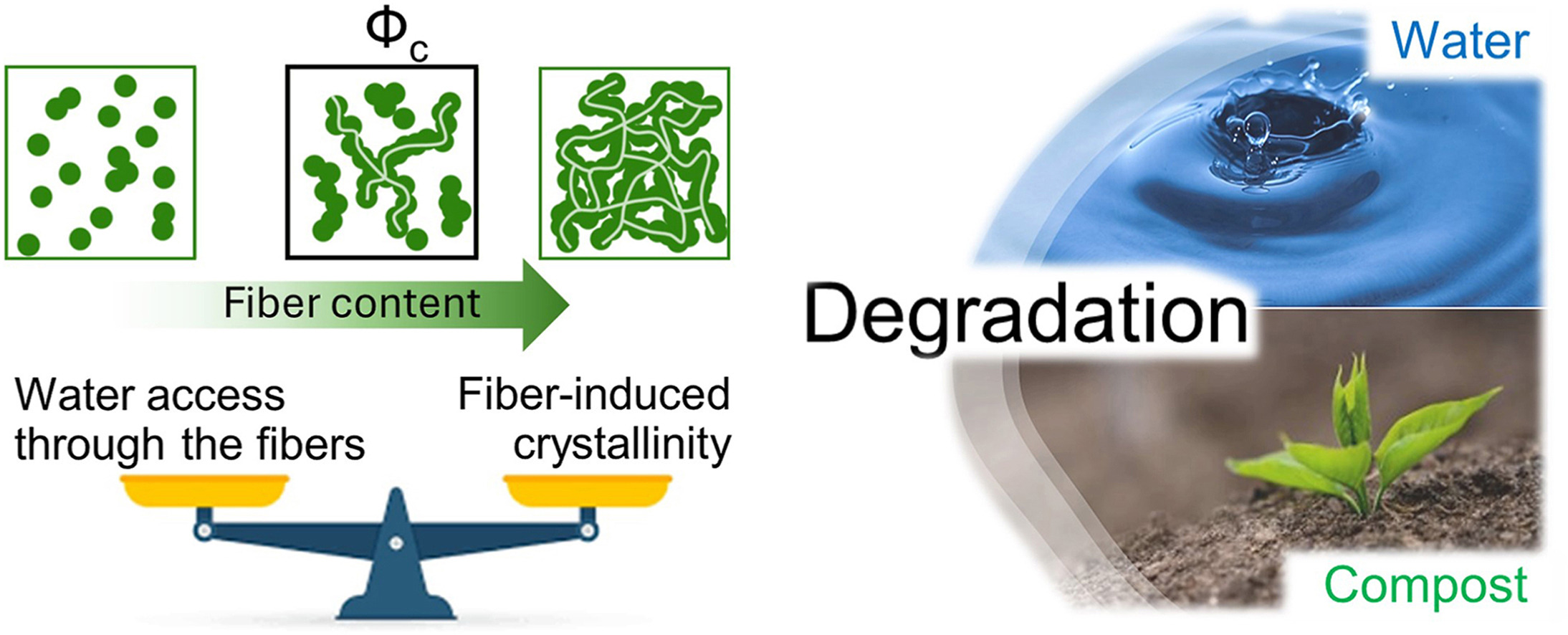
23) Early onset epileptic and developmental encephalopathy and MOGS variants: a new diagnosis in the whole exome sequencing (WES) ERA : Report of a new patient and review of the literature
F.Teutonico, C.Volpe, A.Proto, I.Costi, U.Cavallari, P.Doneda, M.Iascone, L.Sturiale, R.Barone, S.Martinelli, A.Vignoli
Neurogenetics
25(3),
281-286
- 2024
DOI:
https://doi.org/10.1007/s10048-024-00754-y
Mannosyl-oligosaccharide glucosidase - congenital disorder of glycosylation (MOGS-CDG) is determined by biallelic mutations in the mannosyl-oligosaccharide glucosidase (glucosidase I) gene. MOGS-CDG is a rare disorder affecting the processing of N-Glycans (CDG type II) and is characterized by prominent neurological involvement including hypotonia, developmental delay, seizures and movement disorders. To the best of our knowledge, 30 patients with MOGS-CDG have been published so far. We described a child who is compound heterozygous for two novel variants in the MOGS gene. He presented Early Infantile Developmental and Epileptic Encephalopathy (EI-DEE) in the absence of other specific systemic involvement and unrevealing first-line biochemical findings. In addition to the previously described features, the patient presented a Hirschprung disease, never reported before in individuals with MOGS-CDG.
24) Design of High-Performance Molecular Imprinted Magnetic Nanoparticles-Loaded Hydrogels for Adsorption and Photodegradation of Antibiotics from Wastewater
G.Curcuruto, A.Scamporrino, R.Puglisi, G.Nicotra, G.Sfuncia, G.Impellizzeri, S.Dattilo, A.Kahru, M.Sihtmae, V.Aruoja, I.Blinova, S.Carroccio
Polymers
16(15),
2096
- 2024
DOI:
https://doi.org/10.3390/polym16152096
A hydrogel formulation of 2-hydroxy ethyl methacrylate (HEMA) containing covalently linked magnetite nanoparticles was developed to actively facilitate the selective removal and photocatalytic degradation of antibiotics. To this purpose, the hybrid materials were molecularly imprinted with Lomefloxacin (Lome) or Ciprofloxacin (Cipro), achieving a selectivity of 60% and 45%, respectively, starting from a solution of XX concentration. After the adsorption, the embedded magnetite was used with the double function of (i) magnetically removing the material from water and (ii) triggering photo-Fenton (PF) reactions assisted by UVA light and H
2O
2 to oxidize the captured antibiotic. The success of the material design was confirmed by a comprehensive characterization of the system from chemical-physical and morphological perspectives. Adsorption and degradation tests demonstrated the material?s ability to efficiently degrade Lome until its complete disappearance from the electrospray ionization (ESI) mass spectra. Regeneration tests showed the possibility of reusing the material for up to three cycles. Ecotoxicological tests using algae
Rapidocelis subcapitata, crustaceans
Daphnia magna, and bacteria
Vibrio fischeri were performed to evaluate the ecosafety of our synthesized materials.
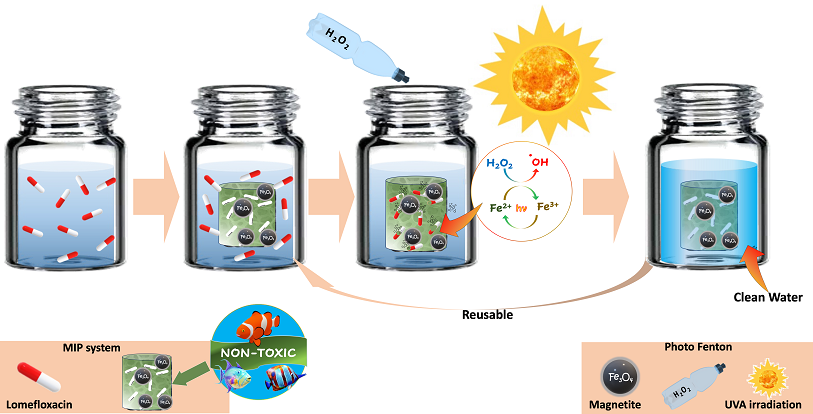
25) The fate of post-use biodegradable PBAT-based mulch films buried in agricultural soil
F.Convertino, S.Carroccio, M.C.Cocca, S.Dattilo, A.Ch.Dell'Acqua, L.Gargiulo, L.Nizzetto, P.Riccobene, E.Schettini, G.Vox, D.Zannini, P.Cerruti
Science of The Total Environment
948,
174697
- 2024
DOI:
https://doi.org/10.1016/j.scitotenv.2024.174697
The fate of black biodegradable mulch film (MF) based on starch and poly(butylene-adipate-
co-terephthalate) (PBAT) in agricultural soil is investigated herein. Pristine (BIO-0) and UV-aged film samples (BIO-A192) were buried for 16 months at an experimental field in southern Italy. Visual, physical, chemical, morphological, and mechanical analyses were carried out before and after samples burial. Film residues in the form of macro- and microplastics in soil were analyzed at the end of the trial.
Progressive deterioration of both pristine and UV-aged samples, with surface loss and alterations in mechanical properties, occurred from 42 days of burial. After 478 days, the apparent surface of BIO-0 and BIO-A192 films decreased by 57 % and 66 %, respectively. Burial determined a rapid depletion of starch from the polymeric blend, especially for the BIO-A192, while the degradation of the polyester phase was slower. Upon burial, an enrichment of aromatic moieties of PBAT in the film residues was observed, as well as microplastics release to soil. The analysis of the MF degradation products extracted from soil (0.006?0.008 % by mass in the soil samples) revealed the predominant presence of adipate moieties. After 478 days of burial, about 23 % and 17 % of the initial amount of BIO-0 and BIO-A192, respectively, were extracted from the soil. This comprehensive study underscores the complexity of biodegradation phenomena that involve the new generation of mulch films in the field. The different biodegradability of the polymeric components, the climate, and the soil conditions that did not strictly meet the parameters required for the standard test method devised for MFs, have significantly influenced their degradation rate. This finding further emphasizes the importance of implementing field experiments to accurately assess the real effects of biodegradable MFs on soil health and overall agroecosystem sustainability.
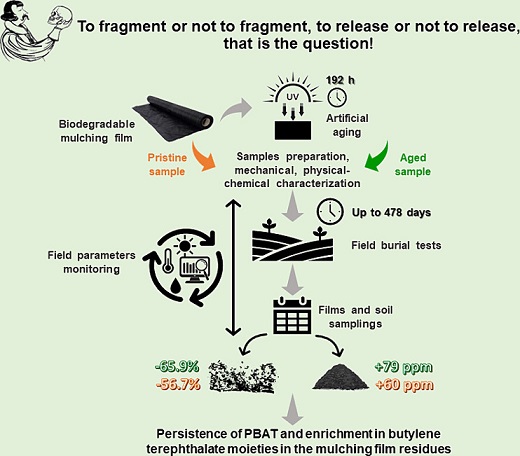
26) Production and characterisation of environmentally relevant microplastic test materials derived from agricultural plastics
R.Hurley, G.Binda, D.Briassoulis, S.Carroccio, P.Cerruti, F.Convertino, D.Dvoráková, S.Kernchen, C.Laforsch, M.G.L.Löder, J.Pulkrabova, E.Schettini, D.Spanu, A.S.Tsagkaris, G.Vox, L.Nizzetto
Science of The Total Environment
946,
174325
- 2024
DOI:
https://doi.org/10.1016/j.scitotenv.2024.174325
Soil environments across the globe, particularly in agricultural settings, have now been shown to be contaminated with microplastics. Agricultural plastics ? such as mulching films ? are used in close or direct contact with soils and there is growing evidence demonstrating that they represent a potential source of microplastics. There is a demand to undertake fate and effects studies to understand the behaviour and potential long-term ecological risks of this contamination. Yet, there is a lack of test materials available for this purpose. This study describes the manufacture and characterisation of five large (1?40 kg) batches of microplastic test materials derived from agricultural mulching films. Batches were produced from either polyethylene-based conventional mulching films or starch-polybutadiene adipate terephthalate blend mulching films that are certified biodegradable in soil. Challenges encountered and overcome during the micronisation process provide valuable insights into the future of microplastic test material generation from these material types. This includes difficulties in micronising virgin polyethylene film materials. All five batches were subjected to a thorough physical and chemical characterisation - both of the original virgin films and the subsequent microplastic particles generated - including a screening for the presence of chemical additives. This is a critical step to provide essential information for interpreting particle fate or effects in scientific testing. Trade-offs between obtaining preferred particle typologies and time and cost constraints are elucidated. Several recommendations emerging from the experiences gained in this study are put forward to advance the research field towards greater harmonisation and utilisation of environmentally relevant test materials.
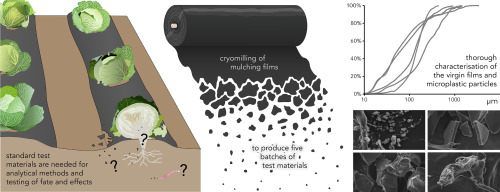
27) Synthesis, Characterisation, and In Vitro Evaluation of Biocompatibility, Antibacterial and Antitumor Activity of Imidazolium Ionic Liquids
E.Novello, G.Scalzo, G.D'Agata, M.G.Raucci, L.Ambrosio, A.Soriente, B.Tomasello, C.Restuccia, L.Parafati, G.M.L.Consoli, L.Ferreri, A.Rescifina, C.Zagni, D.Zampino
Pharmaceutics
16(5),
642
- 2024
DOI:
https://doi.org/10.3390/pharmaceutics16050642
In recent decades, ionic liquids (ILs) have garnered research interest for their noteworthy properties, such as thermal stability, low or no flammability, and negligible vapour pressure. Moreover, their tunability offers limitless opportunities to design ILs with properties suitable for applications in many industrial fields. This study aims to synthetise two series of methylimidazolium ILs bearing long alkyl chain in their cations (C9, C10, C12, C14, C16, C18, C20) and with tetrafluoroborate (BF4) and the 1,3-dimethyl-5-sulfoisophthalate (DMSIP) as counter ions. The ILs were characterised using 1H-NMR and MALDI-TOF, and their thermal behaviour was investigated through DSC and TGA. Additionally, the antimicrobial, anticancer, and cytotoxic activities of the ILs were analysed. Moreover, the most promising ILs were incorporated at different concentrations (0.5, 1, 5 wt%) into polyvinyl chloride (PVC) by solvent casting to obtain antimicrobial blend films. The thermal properties and stability of the resulting PVC/IL films, along with their hydrophobicity/hydrophilicity, IL surface distribution, and release, were studied using DSC and TGA, contact angle (CA), SEM, and UV-vis spectrometry, respectively. Furthermore, the antimicrobial and cytotoxic properties of blends were analysed. The in vitro results demonstrated that the antimicrobial and antitumor activities of pure ILs against t Listeria monocytogenes, Escherichia coli, Pseudomonas fluorescens strains, and the breast cancer cell line (MCF7), respectively, were mainly dependent on their structure. These activities were higher in the series containing the BF4 anion and increased with the increase in the methylimidazolium cation alkyl chain length. However, the elongation of the alkyl chain beyond C16 induced a decrease in antimicrobial activity, indicating a cut-off effect. A similar trend was also observed in terms of in vitro biocompatibility. The loading of both the series of ILs into the PVC matrix did not affect the thermal stability of PVC blend films. However, their Tonset decreased with increased IL concentration and alkyl chain length. Similarly, both the series of PVC/IL films became more hydrophilic with increasing IL concentration and alkyl chain. The loading of ILs at 5% concentration led to considerable IL accumulation on the blend film surfaces (as observed in SEM images) and, subsequently, their higher release. The biocompatibility assessment with healthy human dermal fibroblast (HDF) cells and the investigation of antitumoral properties unveiled promising pharmacological characteristics. These findings provide strong support for the potential utilisation of ILs in biomedical applications, especially in the context of cancer therapy and as antibacterial agents to address the challenge of antibiotic resistance. Furthermore, the unique properties of the PVC/IL films make them versatile materials for advancing healthcare technologies, from drug delivery to tissue engineering and antimicrobial coatings to diagnostic devices.
28) Enhancing Sustainability in Unsaturated Polyester Resin: A Way to Use Biobased Curing Agents for Reduced Styrene Content and Improved Recyclability Properties
G.Rizzo, S.Dattilo, V.Prasad, M.Yasar, A.Ivankovic, A.Latteri, G.Cicala
ACS applied polymer materials
- 2024
DOI:
https://doi.org/10.1021/acsapm.4c00388
Unsaturated polyester resin (UPR) is a commercially thermosetting material renowned for its favorable thermomechanical properties and exceptional chemical resistance. These characteristics are typically attributed to the use of styrene as a curing agent. However, the undiscussed toxicity and potential carcinogenicity of styrene have inspired research and industry to investigate more sustainable and environmentally friendly alternatives, such as vegetable oils, polyphenols, and carbohydrates. In this study, unsaturated polyester (UP) was synthesized and cured with a blend of acrylated epoxidized soybean oil (AESO), 2-hydroxyethyl methacrylate (HEMA), and styrene in low content. Notably, styrene was reduced from 40% to 26%. Zinc(II) acetyl acetonate was introduced into the blend to promote transesterification processes, potentially enhancing both dissolution and recycling capabilities. Following comprehensive characterization, the resulting resins were employed in composite manufacturing, with subsequent comparison to available counterparts made of commercial UP with a content of styrene at 40%. Remarkably, the mechanical properties, glass transition temperature, and thermal stability of the polyester were effectively preserved, despite the incorporation of biobased curing agents.
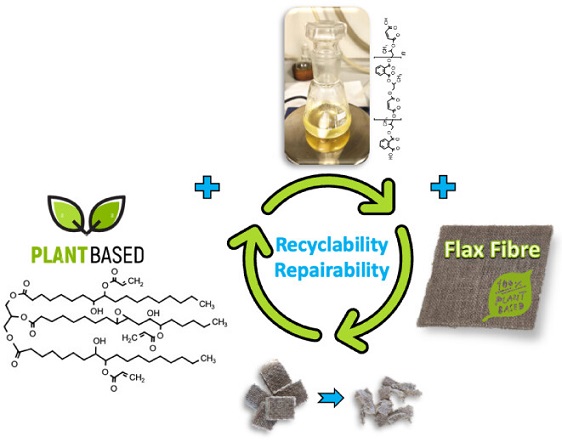
29) Secondary deficiency of neuraminidase 1 contributes to CNS pathology in neurological mucopolysaccharidoses via hypersialylation of brain glycoproteins
T.Xu, R.Héon-Roberts, T.Moore, P.Dubot, X.Pan, T.Guo, C.W.Cairo, R.Holley, B.Bigger, T.Durcan, T.Levade, J.Ausseil, B.Amilhon, A.Gorelik, B.Nagar, L.Sturiale, A.Palmigiano, I.Roeckle, H.Thiesler, H.Hildebrandt, D.Garozzo, A.V.Pshezhetsky
bioRxiv
04,
26.587.986
- 2024
DOI:
https://doi.org/10.1101/2024.04.26.587986
Mucopolysaccharidoses (MPS) are lysosomal storage diseases caused by defects in catabolism of glycosaminoglycans. MPS I, II, III and VII are associated with lysosomal accumulation of heparan sulphate and manifest with neurological deterioration. Most of these neurological MPS currently lack effective treatments. Here, we report that, compared to controls, neuraminidase 1 (NEU1) activity is drastically reduced in brain tissues of neurological MPS patients and in mouse models of MPS I, II, IIIA, IIIB and IIIC, but not of other neurological lysosomal disorders not presenting with heparan sulphate storage. We further show that accumulated heparan sulphate disrupts the lysosomal multienzyme complex of NEU1 with cathepsin A (CTSA), β-galactosidase (GLB1) and glucosamine-6-sulfate sulfatase (GALNS) necessary to maintain enzyme activity, and that NEU1 deficiency is linked to partial deficiencies of GLB1 and GALNS in cortical tissues and iPSC-derived cortical neurons of neurological MPS patients. Increased sialylation of N-linked glycans in brain samples of human MPS III patients and MPS IIIC mice implicated insufficient processing of brain N-linked sialylated glycans, except for polysialic acid, which was reduced in the brains of MPS IIIC mice. Correction of NEU1 activity in MPS IIIC mice by lentiviral gene transfer ameliorated previously identified hallmarks of the disease, including memory impairment, behavioural traits, and reduced levels of the excitatory synapse markers VGLUT1 and PSD95. Overexpression of NEU1 also restored levels of VGLUT1-/PSD95-positive puncta in cortical neurons derived from iPSC of an MPS IIIA patient
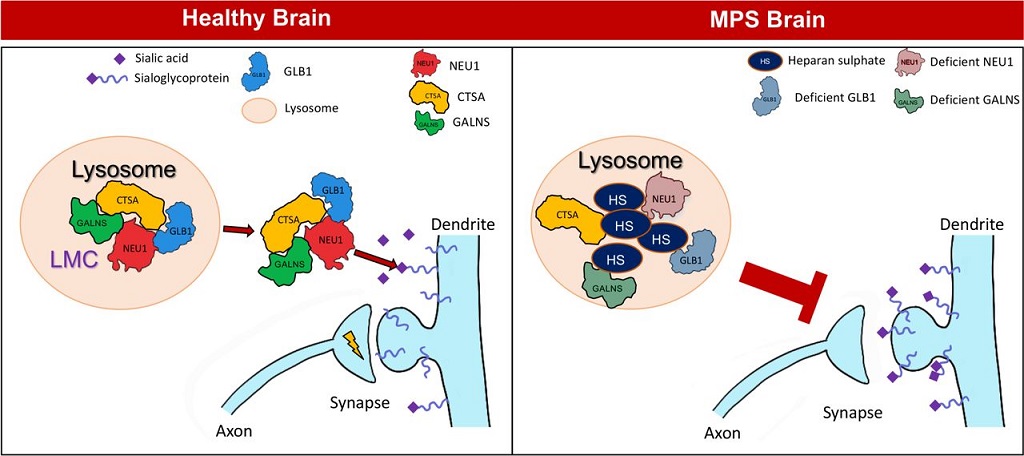
30) Solvent-free conversion of CO2 in carbonates through a sustainable macroporous catalyst
S.Dattilo, C.Zagni, T.Mecca, V.Patamia, G.Floresta, P.Nicotra, S.Carroccio, A.Rescifina
Giant
18,
100258
- 2024
DOI:
https://doi.org/10.1016/j.giant.2024.100258
The novelty of this work consists of synthesizing and exploiting a heterogeneous catalyst containing ammonium chloride as part of the polymeric sponge sites for CO
2 capture. To this aim, the polymerization of 2-acryloyl(oxyethyl)trimethylammonium chloride was performed in cryo-condition, in the presence of a crosslinking agent, obtaining a lightweight macroporous freestanding material. Its efficiency in converting aromatic and aliphatic epoxides to the corresponding carbonates was successfully proved by using proton Nuclear Magnetic Resonance (
1H NMR). Remarkably, the conversion of styrene oxide (SO) to styrene carbonate (SC) reached a yield of 99 % after 24 h of reaction. The calculated yield versus the aliphatic cyclohexene oxide is 71 %. Similar results were obtained by substituting the resin counter anion with Br
-, although the conversion kinetic was slower than the chloride. It is worth noticing that reactions took place in the mixture without adding the tetrabutylammonium bromide (TBAB), typically used as a co-catalyst to convert epoxides into carbonates. The recyclability of the as-prepared catalyst was evaluated for four reaction cycles, evidencing stable properties without significant depletion of CO
2 capture efficiency. Most importantly, the post-cleaning of the catalytic sponge is not required to be reused. Finally, the green chemistry metrics applied to the process demonstrated that our approach significantly mitigates risks and reduces environmental impact, thus elevating the overall cleanliness of our proof of concept.
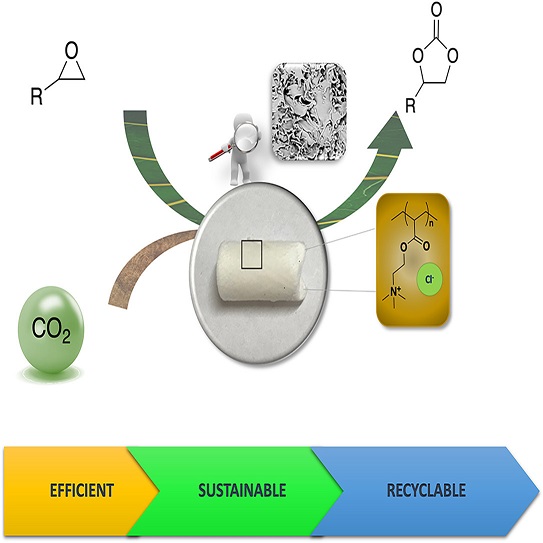
31) Supramolecular biomaterials as drug nanocontainers with iron depletion properties for antimicrobial applications
C.Zagni, V.Patamia, S.Dattilo, V.Fuochi, S.Furnari, P.M.Furneri, S.Carroccio, G.Floresta, A.Rescifina
Materials Advances
9
- 2024
DOI:
https://doi.org/10.1039/D3MA00918A
This work reports the design of a new bacteria-killer based on maltol derivatives and β-cyclodextrin cryogels. The maltol covalently linked to the 3D polymer network chelates the iron ions efficiently, subtracting them from the bacterial environment, thus impeding microbial survival. At the same time, the hydrophobic cavities of β-cyclodextrin can work as nanocontainers to release pharmaceuticals on the infected tissue, reinforcing the bactericidal action. This non-conventional dual-acting system was successfully tested with and without the complexation of lomefloxacin by β-cyclodextrin. The material's remarkable activity was proven on Gram-positive and Gram-negative bacteria. As it turns out, such material is bactericidal owing to maltol chelating features; moreover, the material is able to improve the bactericidal activity when it releases lomefloxacin after its complexation inside β-cyclodextrin. Indeed, the presence of β-cyclodextrin nanocontainers holds the promise of compliance with various drugs, opening up exciting possibilities for diverse therapeutic applications. These innovations could potentially bring a new vista to wound dressing.
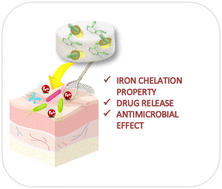
32) Compatibilized polylactide/poly(pentamethylene furanoate) blends for fully bioderived packaging films with enhanced fracture toughness and UV- and O2-barrier properties
G.Fredi, D.Perin, C.Zardo, M.Rapisarda, P.Rizzarelli, M.Soccio, N.Lotti, A.Dorigato
Giant
18,
100267
- 2024
DOI:
https://doi.org/10.1016/j.giant.2024.100267
Polylactide (PLA) is a promising biopolymer from renewable resources but its brittleness and poor gas barrier properties limit flexible packaging applications. Therefore, in this work PLA was blended with a biobased rubbery poly(pentamethylene furanoate) (PPeF), acting as a toughening agent, and a commercial epoxy-functionalized compatibilizer (i.e., Joncryl® ADR-4468) was added to improve the interfacial interaction. The effect of PPeF loading (1?30 wt %) on phase morphology, mechanical properties, oxygen permeability, and degradability in compost was characterized. All blends displayed a sea-island morphology with refined PPeF domains upon compatibilization. Incorporating PPeF induced major tensile ductility enhancements from 5 % strain at break for neat PLA up to 200 % for the blend with 30 wt % PPeF, accompanied by progressive stiffness and strength declines. Through the application of the essential work of fracture (EWF) approach on the prepared films, the specific essential work of fracture (w
e) was seen climbing from 6.2 to 40.0 kJ/m
2 with rising PPeF content, confirming its effectiveness as a toughness enhancer. PPeF contributed to increase the UV- and gas barrier properties of PLA. For example, the oxygen permeability dropped by 37 % for the blend with 30 wt % PPeF. Moreover, compost burial tests also revealed 26 % weight loss of PPeF after 60 days, proving its biodegradability. Hence, finely dispersed PPeF domains induced synergistic property improvements, making PLA/PPeF blends a promising sustainable option for flexible and biodegradable packaging.
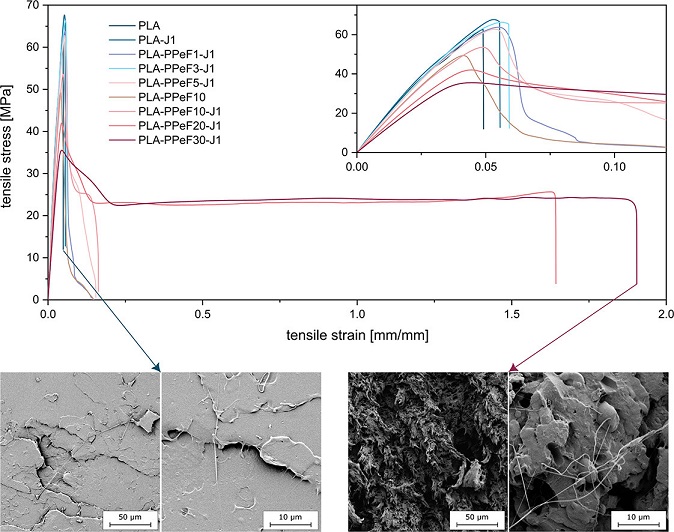
33) pH-dependent catalytic activity of Au and Pd-based hybrid cryogels by investigating the acid/base nature of the polymeric phase
S.Scurti, G.Proietto Salanitri, T.Mecca, E.Rodríguez-Aguado, J.A.Cecilia, G.Curcuruto, S.Carroccio, D.Caretti, N.Dimitratos
Materials Today Chemistry
38,
102046
- 2024
DOI:
https://doi.org/10.1016/j.mtchem.2024.102046
Over the last decade, cryogels have proven to be effective catalytic supports in various hybrid systems for the conversion of 4-nitrophenol (4-NP) to 4-aminophenol (4-NP). A critical determinant influencing the conversion of nitroaromatic compounds in the presence of sodium borohydride is the solution pH as suggested from Grzeschik's model. This study aims to investigate the catalytic mechanism and the role of pH in reactions mediated by hybrid catalysts. In particular, polymeric cryogels with different acid/base properties were prepared and used as supports for the in-situ preparation of Au and Pd nanocatalysts. Notably, catalytic tests showed the significant influence of the polymeric support's acidity on 4-NP reduction, with poly(acrylic acid)-based catalysts emerging as the most effective systems. To further probe the reaction mechanism, a series of catalytic tests were carried out, and the results demonstrated the effect of pH on the reaction process, allowing to propose a novel mechanism based on an extension of Grzeschik's model. Moreover, data emphasized the pivotal role of the polymer in the catalytic mechanism, showcasing its capacity to tune catalytic activity by altering the acid/base properties of the matrix substrates.
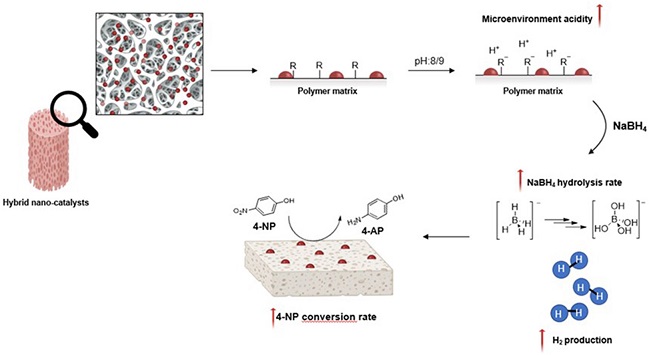
34) Wood flour and hazelnut shells polylactide-based biocomposites for packaging applications: Characterization, photo-oxidation, and compost burial degradation
M.Baiamonte, M.Rapisarda, M.Ch.Mistretta, G.Impallomeni, F.P.La Mantia, P.Rizzarelli
Polymer Composites
- 2024
DOI:
https://doi.org/10.1002/pc.28439
In this work, polylactide (PLA) was loaded with wood flour (WF) or hazelnut shells (HSs) (10% and 20% of fillers). The matrix and biocomposites were fully characterized from a mechanical and rheological point of view to test their processability and mechanical performance. Compost burial degradation test (30 days), with or without a prior photo-oxidation step, assessed their biodegradability after an outdoor application, and was monitored by weight loss (WL). The viscosity of the biocomposites was lower than that of the matrix and this unusual result can be attributed to a limited adhesion between the PLA and fillers. Both fillers increased the elastic modulus but decreased the tensile strength and elongation at break. As for the weathering, the degradation of PLA was mostly due to hydrolytic chain scission due to the presence of humidity. Resistance of PLA to UV irradiation improved in presence of both the two fillers. Their lignocellulosic nature was responsible for this behavior. Both fillers induced a high resistance and lower degradation in compost: WL percentages of virgin PLA was about 26%, biocomposites with 20% of WF or HS showed WL of about 10% and 14%, respectively. Photo-oxidation (36 h with condensation cycle) increased the compost degradation rate of both biocomposites and WL of PLA with 20% of WF or HS were about 15% and 21%, respectively, after 30 days.
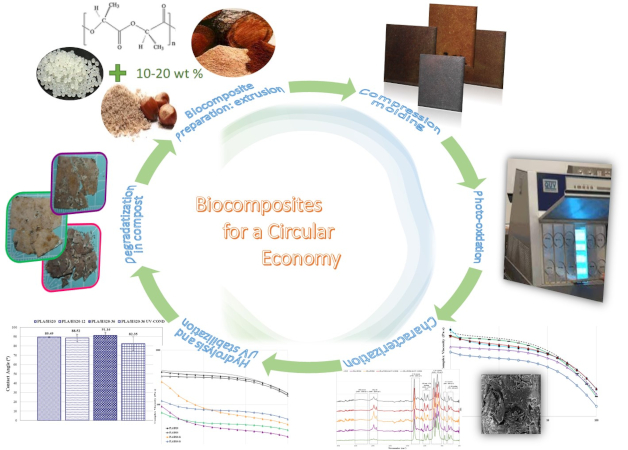
35) How the Crosslinker Amount Influences the Final Properties of Hydroxyethyl Methacrylate Cryogels
G.Proietto Salanitri, E.Luzzi, D.Caretti, T.Mecca, S.Carroccio, A.Scamporrino
Gels
10(3),
163
- 2024
DOI:
https://doi.org/10.3390/gels10030163
The investigation of the mechanical, thermal, and adsorption properties of hydroxyethyl methacrylate (HEMA) cryogels as a function of a reactant ratio is herein reported to better address materials for specific applications. To this aim, cryogels have been synthesized using different monomer/crosslinker (N,N'-methylene-bisacrylamide?MBAA) ratios. The study of SEM images made it possible to identify the trend in the material’s macroporosity. As would be expected, the average measured pore width decreased as the amount of MBAA increased while the number of pores grew. Swelling capacity ranges from 8.7 gW/g
gel (grams of water per gram of gel) to 9.3 gW/g
gel. These values are strictly connected with the pore’s size and distribution, revealing that the water uptake for the most crosslinked sample is inferior to other samples. The equilibrium-adsorption capacity (Qe) towards the methylene violet (MV) was also assessed, revealing no remarkable differences after 24 h of a batch test. As expected, thermogravimetric analysis (TGA) also showed no significant changes in stability that ranged from a maximum weight loss temperature (T Max) of 420 °C to 425 °C, which increased as a function of crosslinker content. Conversely, compression strength measurements showed a notable difference of about 50% in modulus (Ec), moving from the higher to the lower HEMA/MBAA ratio. These new comparative results indicate how slight variations in the reactant’s ratio can steadily improve the mechanical properties of the HEMA cryogel without affecting its adsorption efficiency. This can be helpful in the design of materials for water and energy purposes. Since swelling properties are needed in the case of biomedical applications, the HEMA/MBAA ratio should be tuned versus high values.
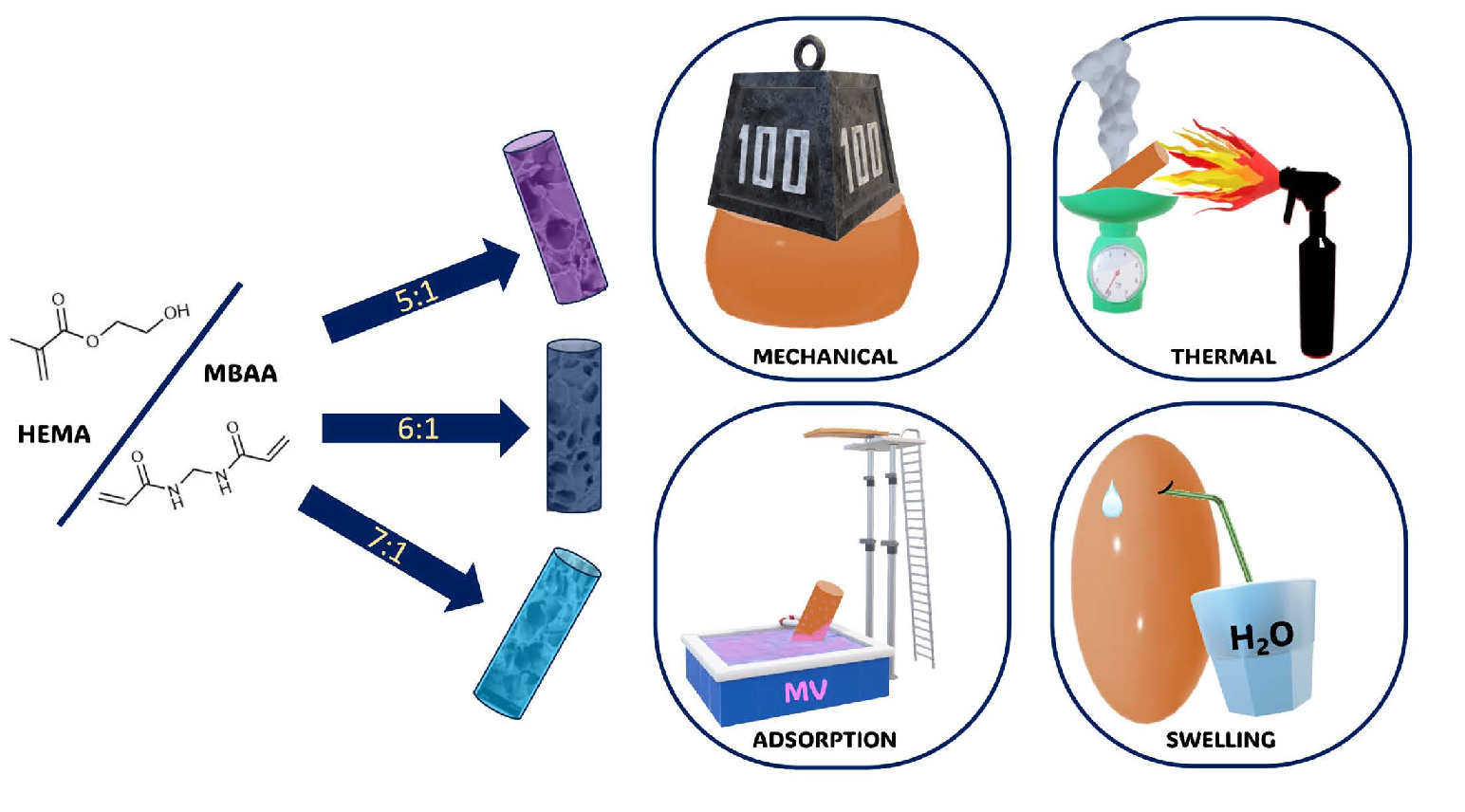
36) Molecularly Mixed Composite Membranes for Gas Separation Based on Macrocycles Embedded in a Polyimide
D.Vuono, G.Clarizia, L.Ferreri, G.M.L.Consoli, D.Zampino, G.Scalzo, S.Petralia, P.Bernardo
Polymers
16(4),
460
- 2024
DOI:
https://doi.org/10.3390/polym16040460
Polyimides are a polymer class that has been extensively investigated as a membrane material for gas separation owing to its interesting permselective properties in a wide range of operation temperatures and pressures. In order to improve their properties, the addition of different filler types is currently studied. p-tert-Butylcalix[n]arene macrocycles (PTBCs) with different cavity sizes (PTBC4, PTBC6, PTBC8) were used as fillers in a commercial thermoplastic polyimide, with a concentration in the range 1-9 wt%, to develop nanocomposite membranes for gas separation. The selected macrocycles are attractive organic compounds owing to their porous structure and affinity with organic polymers. The nanocomposite membranes were prepared in the form of films in which the polymeric matrix is a continuous phase incorporating the dispersed additives. The preparation was carried out according to a pre-mixing approach in a mutual solvent, and the solution casting was followed by a controlled solvent evaporation. The films were characterized by investigating their miscibility, morphology, thermal and spectral properties. The gas transport through these films was examined as a function of the temperature and also time. The results evidenced that the incorporation of the chosen nanoporous fillers can be exploited to enhance molecular transport, offering additional pathways and promoting rearrangements of the polymeric chains.
37) Green3: A green extraction of green additives for green plastics
V.Muccilli, A.E.Maccarronello, C.Rasoanandrasana, N.Cardullo, M.S.de Luna, M.G.G.Pittalà, P.M.Riccobene, S.Carroccio, A.Scamporrino
Heliyon
10(2),
e24469
- 2024
DOI:
https://doi.org/10.1016/j.heliyon.2024.e24469
PLA/PBAT bioplastic is a commercial biodegradable plastic employed for packaging and several food and agriculture applications. In this regard, properties such as the antioxidant ability to extend food shelf life and light resistance, are of great interest in the production of packaging and mulching films, respectively. These features are obtained by developing blends with pure chemicals and/or natural products as additives. In the present work blend formulations of PLA/PBAT with a walnut shell extract rich in antioxidants were developed and evaluated for their properties in comparison with classic PLA/PBAT. Specifically, natural additives, and most importantly the production process were purposely selected to i) be green and cost-effective; ii)
confer antioxidant properties; and iii) improve material performance To this aim, a walnut shell extract (EWS) with high antioxidant activity was obtained thanks to a novel green and cost-effective microwave-assisted extraction (MAE) procedure. A response surface methodology was utilized to explore how the total phenolic content (TPC) and antioxidant activity are influenced by varying aqueous ethanol concentration, extraction time, and microwave power. The highest predicted TPC and antioxidant activity were achieved when employing the ideal conditions for Microwave-Assisted Extraction (MAE): using a mixture of 30 % ethanol in water, an irradiation time of 120 s, and a microwave power of 670 W. The optimized EWS was characterized by HPLC-MS determining qualitative and quantitative data with the identification of flavonoids, fatty acids, and anacardic acids among the main components, responsible for antioxidant activity. The resulting EWS powder was melt-mixed at 140C° and 20 RPM with the bio-based PLA/PBAT bioplastic at two different concentrations (0.5 and 1.5 w/w) by forming film specimens. All EWS-based bioplastic films showed increased antioxidant features determined by the DPPH bleaching test, TEAC, and ORAC assays. The films keep the antioxidant capacity even after 7 days of UV-accelerated aging. Remarkably, adding 1.5 % EWS boosted the bioplastic UV light resistance, reducing the abatement of molecular masses by more than 60 % without affecting mechanical properties.
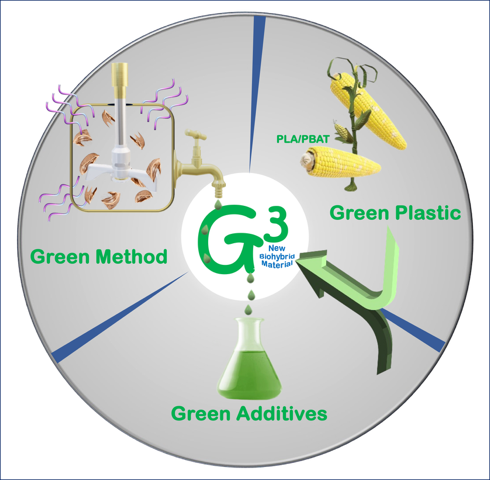
38) Band Engineering versus Catalysis: Enhancing the Self-Propulsion of Light-Powered MXene-Derived Metal-TiO2 Micromotors To Degrade Polymer Chains
M.Urso, L.Bruno, S.Dattilo, S.Carroccio, S.Mirabella
ACS Applied Materials & Interfaces
16,
1293-1307
- 2024
DOI:
https://doi.org/10.1021/acsami.3c13470
Light-powered micro- and nanomotors based on photocatalytic semiconductors convert light into mechanical energy, allowing self-propulsion and various functions. Despite recent progress, the ongoing quest to enhance their speed remains crucial, as it holds the potential for further accelerating mass transfer-limited chemical reactions and physical processes. This study focuses on multilayered MXene-derived metal-TiO
2 micromotors with different metal materials to investigate the impact of electronic properties of the metal-semiconductor junction, such as energy band bending and built-in electric field, on self-propulsion. By asymmetrically depositing Au or Ag layers on thermally annealed Ti
3C
2T
x MXene microparticles using sputtering, Janus structures are formed with Schottky junctions at the metal?semiconductor interface. Under UV light irradiation, Au-TiO
2 micromotors show higher self-propulsion velocities due to the stronger built-in electric field, enabling efficient photogenerated charge carrier separation within the semiconductor and higher hole accumulation beneath the Au layer. On the contrary, in 0.1 wt % H
2O
2, Ag-TiO
2 micromotors reach higher velocities both in the presence and absence of UV light irradiation, owing to the superior catalytic properties of Ag in H
2O
2 decomposition. Due to the widespread use of plastics and polymers, and the consequent occurrence of nano/microplastics and polymeric waste in water, Au-TiO
2 micromotors were applied in water remediation to break down polyethylene glycol (PEG) chains, which were used as a model for polymeric pollutants in water. These findings reveal the interplay between electronic properties and catalytic activity in metal-semiconductor junctions, offering insights into the future design of powerful light-driven micro- and nanomotors with promising implications for water treatment and photocatalysis applications.
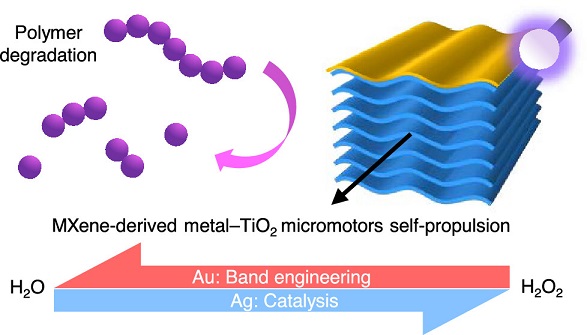
39) Editorial: Chemistry and the circular economy
P.Rizzarelli, A.Zuliani, N.Reddy
Frontiers in Chemistry
11
- 2023
DOI:
https://doi.org/10.3389/fchem.2023.1350994
Chemistry stands as the cornerstone for life’s sustenance and progress on our planet, offering solutions to humanity’s challenges throughout history. In the modern era, Chemistry is an integral part of daily life, influencing science and technology. While its foundations lie in natural elements, synthetic chemistry advancements have excelled in cost, manufacturing ease, scalability, and consistency. Yet, concerns about health and environmental effects urge a reevaluation of the exploitation and applications of natural sources. Since 2000, global concerns like climate change and resource depletion have fueled extensive exploration for alternative solutions to using natural resources, especially amid environmental disasters, pandemics, and geopolitical struggles. One of the major approaches being considered to meet and overcome these challenges is by maximizing the use of natural resources and minimizing the generation of waste (Tseng et al., 2020). In this context, the concept of circular economy, where the waste and coproducts generated by one process are considered as inputs for another one and converted into value added products through clean and green approaches, is being aggressively pursued and adopted (Velenturf and Purnell, 2021).
Based on current statistics, the global agriculture market is expected to cross US$ 5 trillion by 2028. Consequently, the generation of byproducts and coproducts during agricultural production and processing is also set to increase steeply (Kircher, 2019; Díaz-Bonilla, 2023). Stems, leaves and husks generated during agricultural production and several byproducts, including proteins and carbohydrates, supplied as coproducts during agricultural processing are available in large quantities at low cost. These byproducts and coproducts have the essential constituents to be converted into monomers, polymers, compounds and further into any desired substance through specific chemical transformations, ranging from carbonyl reductions to carboxyl decarboxylations, hydroxyl oxidations, glycosylation, and transglycosylation (Li et al., 2014; Donner et al., 2021). For instance, corn-based biorefineries utilizing starch, corn husks, corn cobs, distillers dried grains and other coproducts have generated biofuels (ethanol, methane), biopolymers (polylactide), amino acids, animal feed and enzymes. Similarly, sugarcane based biorefineries have excelled in the production of biofuels, paper, fertilizers, animal feed, chemicals such as acetic acid, cosmetics and perfumes (Gerrior et al., 2022). Not only regular food crops but also non-food products such as poultry feathers have been considered for production of composite, plastics, biofuels, etc. Based on these approaches, it is evident that there is unlimited scope for extending the biorefinery and circular economy concepts to almost all agricultural byproducts and coproducts.
To achieve successful utilization and exploitation of renewable resources, the development of innovative and efficient conversion processes is essential. The purpose of the present Research Topic, "Chemistry and The Circular Economy", aligns with this goal. It displays the continuous progress and the potential of chemistry in addressing global challenges by bringing together research articles that explore advancements in energy storage, hydrogen production, polymer synthesis, and biochar utilization.
In the realm of energy storage, researchers have dedicated over 2 decades to refining biomass through rapid pyrolysis technology. However, challenges emerge as the primary product, biomass pyrolysis oil, grapples with low energy density and poor thermal stability. The intrigue deepens as exploration leads towards catalytic reforming as a transformative avenue, offering a potential solution for the subsequent utilization of bio-oil in hydrogen production. In a captivating mini review, Zhang focuses on the innovative technique of CO2 adsorption-enhanced catalytic reforming, presenting itself as a beacon of hope for efficient and sustainable hydrogen generation. The review briefly introduces recent progress in biomass catalytic reforming hydrogen production technology, covering mechanisms, catalyst selection, new processes, and technology developments. It also addresses current challenges in this field, providing potential ideas and directions for future development.
Shifting the focus to the captivating world of bio-derived polymers, the synthesis of poly-γ-glutamic acid (γ-PGA) comes into play. This water-soluble marvel holds promise as a game-changer in various applications. Its potential spans from the realms of drug delivery and cosmetics to bioremediation and wastewater treatment, weaving a tale of sustainability and versatility. Parati et al. explores the synthesis of γ-PGA from scalable macroalgal biomass assessing the influence of pre-treatment type, macroalgal species, and collection time on brown seaweed cultivated under controlled conditions in Scotland. Laminaria digitata, Saccharina latissima, and Alaria esculenta, three brown seaweed species native to the United Kingdom, are analyzed for their variation in carbon, antioxidant, protein, and ash content. The research evaluated the effect of different algal species on the yields and chemical composition of γ-PGA produced by Bacillus subtilis natto, also investigating the variations during the specific cultivation period.
Li et al. present a review delving into the promising realm of biochar, an environmentally friendly material drawing attention for its potential use as a potassium ion anode in batteries. The manuscript explores the transformative possibilities of biochar through modifications, particularly highlighting atomic doping to enhance electrochemical performance. This type of materials exhibits not only efficient energy conduction but also increased potassium storage capacity. The review covers the application of atomically doped biomass carbon materials (BCMs) and recent advancements in pure BCMs, emphasizing considerations for simpler production, reduced costs, and environmental protection. Key challenges in developing BCMs, such as irreversible potassium buildup and electrolyte breakdown, are discussed and potential solutions have also been proposed.
Supporting the circular economy model, a beacon of hope for combating the environmental impact of poly(ethylene terephthalate) (PET), a commonly produced and consumed polymer, comes from (Gabrielli et al.). Their proposed approach involves a microwave-assisted recycling process, focused on aminolysis of PET waste to create polyurethane acrylate (PUA) derived coatings. The process utilizes substituted ß-hydroxy amines for chemical depolymerization of PET waste, employing a sodium acetate catalyst. The first step achieves efficient depolymerization of PET within a short time, resulting in the formation of terephthalimide diols. This environmentally friendly method enables the synthesis of a diverse range of diol monomers with customizable organic structures suitable for PUA UV-curable coatings.
In this tapestry of research, each article of the present Research Topic not only unravels scientific complexities but also paints a vivid picture of innovation, sustainability, and the transformative power of human ingenuity in the pursuit of a brighter, greener future.
40) Chemical Recycling of Fully Recyclable Bio-Epoxy Matrices and Reuse Strategies: A Cradle-to-Cradle Approach
L.Saitta, G.Rizzo, C.Tosto, G.Cicala, I.Blanco, E.Pergolizzi, R.Ciobanu, G.Recca
Polymers
15(13),
2809
- 2023
DOI:
https://doi.org/10.3390/polym15132809
Currently, the epoxy resin market is expressing concerns about epoxy resins’ non-recyclability, which can hinder their widespread use. Moreover, epoxy monomers are synthesized via petroleum-based raw materials, which also limits their use. So, it is crucial to find more environmentally friendly alternative solution for their formulation. Within this context, the aim of this paper is to exploit a Cradle-to-Cradle approach, which consists of remodeling and reshaping the productive cycle of consumer products to make sure that they can be infinitely reused rather than just being recycled with a downgrading of their properties or uses, according to the principle of the complete circular economy. Indeed, after starting with a fully-recyclable bio-based epoxy formulation and assessing its recyclability as having a process yield of 99%, we obtained a recycled polymer that could be reused, mixing with the same bio-based epoxy formulation with percentages varying from 15 wt% to 27 wt%. The formulation obtained was thoroughly characterized by a dynamic-mechanical analysis, differential scanning calorimetry, and flexural tests. This approach had two advantages: (1) it represented a sustainable disposal route for the epoxy resin, with nearly all the epoxy resin recovered, and (2) the obtained recycled polymer could be used as a green component of the primary bio-based epoxy matrix. In the end, by using replicated general factorial designs (as statistical tools) combined with a proper optimization process, after carrying out a complete thermo-mechanical characterization of the developed epoxy formulations, the right percentage of recycled polymer content was selected with the aim of identifying the most performing epoxy matrix formulation in terms of its thermo-mechanical properties.
41) Investigations into the characterization, degradation, and applications of biodegradable polymers by mass spectrometry
P.Rizzarelli, M.Leanza, M.Rapisarda
Mass Spectrometry Reviews
- 2023
DOI:
https://doi.org/10.1002/mas.21869
Biodegradable polymers have been getting more and more attention because of their contribution to the plastic pollution environmental issues and to move towards a circular economy. Nevertheless, biodegradable materials still exhibit various disadvantages restraining a widespread use in the market. Therefore, additional research efforts are required to improve their performance. Mass spectrometry (MS) affords a relevant contribution to optimize biodegradable polymer synthesis, to confirm macromolecular structures, to examine along the time the progress of degradation processes and highlight advantages and drawbacks in the extensive applications. This review aims to provide an overview of the MS investigations carried out to support the synthesis of biodegradable polymers, with helpful information on undesirable products or polymerization mechanism, to understand deterioration pathways by the structure of degradation products and to follow drug release and pharmacokinetic. Additionally, it summarizes MS studies addressed on environmental and health issues related to the extensive use of plastic materials, that is, potential migration of additives or microplastics identification and quantification. The paper is focused on the most significant studies relating to synthetic and microbial biodegradable polymers published in the last 15 years, not including agro-polymers such as proteins and polysaccharides.
42) Severe kidney dysfunction in sialidosis mice reveals an essential role for neuraminidase 1 in reabsorption
I.Kho, E.P.Demina, X.Pan, I.Londono, C.W.Cairo, L.Sturiale, A.Palmigiano, A.Messina, D.Garozzo, R.Ung, F.Mac-Way, E.Bonneil, P.Thibault, M.Lemaire, C.R.Morales, A.V.Pshezhetsky
JCI Insight
8(20),
166470
- 2023
DOI:
https://doi.org/10.1172/jci.insight.166470
Sialidosis is an ultra-rare multisystemic lysosomal disease caused by mutations in the neuraminidase 1 (NEU1) gene. The severe type II form of the disease manifests with a prenatal/infantile or juvenile onset, bone abnormalities, severe neuropathology, and visceromegaly. A subset of these patients present with nephrosialidosis, characterized by abrupt onset of fulminant glomerular nephropathy. We studied the pathophysiological mechanism of the disease in 2 NEU1-deficient mouse models, a constitutive Neu1-knockout, Neu1ΔEx3, and a conditional phagocyte-specific knockout, Neu1Cx3cr1ΔEx3. Mice of both strains exhibited terminal urinary retention and severe kidney damage with elevated urinary albumin levels, loss of nephrons, renal fibrosis, presence of storage vacuoles, and dysmorphic mitochondria in the intraglomerular and tubular cells. Glycoprotein sialylation in glomeruli, proximal distal tubules, and distal tubules was drastically increased, including that of an endocytic reabsorption receptor megalin. The pool of megalin bearing O-linked glycans with terminal galactose residues, essential for protein targeting and activity, was reduced to below detection levels. Megalin levels were severely reduced, and the protein was directed to lysosomes instead of the apical membrane. Together, our results demonstrated that desialylation by NEU1 plays a crucial role in processing and cellular trafficking of megalin and that NEU1 deficiency in sialidosis impairs megalin-mediated protein reabsorption.
43) HEMA-based macro and microporous materials for CO2 capture
C.Zagni, A.Coco, S.Dattilo, V.Patamia, G.Floresta, R.Fiorenza, G.Curcuruto, T.Mecca, A.Rescifina
Materials Today Chemistry
33,
101715
- 2023
DOI:
https://doi.org/10.1016/j.mtchem.2023.101715
New polymeric macroporous materials based on poly 2-hydroxyethyl methacrylate (pHEMA) were synthesized and tested to adsorb CO
2. To this purpose, bio and affordable amine-based molecules such as lysine (LYS) and histidine (HIS) were selected as CO
2 active sites and used to functionalize HEMA monomer before its crosslinking polymerization. The as-prepared monomers and polymers were characterized by using Nuclear Magnetic Resonance (NMR), Fourier Infrared Spectroscopy (FT-IR), Thermal gravimetric analysis (TGA), and Scanning Electron Microscopy (SEM) equipped with Energy Dispersive X-ray (EDX). Compared to materials reported in the recent literature, all produced ones provide exceptional adsorption capacity in the 162-193 ppm range. In particular, H-HEMA-LYS exhibits the best adsorption grade, well-fitting the Linear Driving Force (LFD) model. H-HEMA-LYS reusability was also tested for up to 5 cycles without significant loss in capture performance. Finally, to get insight into the role of morphology in CO
2 adsorption, two diverse macroporous structures were synthesized (hydrogels and cryogels) for both HIS and LYS-based materials. As it turns out, hydrogel formulations of an average area ranging from 15.5 to 230μm
2 adsorb 12% more than cryogels with higher values (266-605 μm
2).
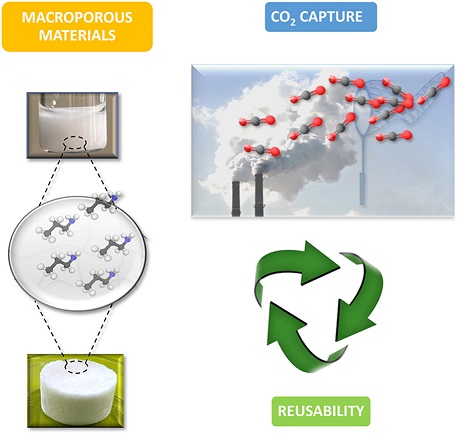
44) Thermomechanical Characterization of an Unsaturated Polyester Vitrimer Synthesized Using a Titanium Transesterification Catalyst
G.Rizzo, L.Saitta, S.Dattilo, C.Tosto, E.Pergolizzi, A.Ivankovic, G.Cicala
ACS Applied Polymer Materials
- 2023
DOI:
https://doi.org/10.1021/acsapm.3c01489
Unsaturated polyester resins (UPRs) are widely applied thermosets characterized by good thermo-mechanical properties and excellent chemical resistivity. However, the non-reprocessability of UPRs once cured, together with the increasing amount of their waste, has recently urged research and industries to develop more sustainable substituents. In this work, an unsaturated polyester vitrimer was synthesized and characterized by exploiting titanium (IV) butoxide as the transesterification catalyst. This simple approach demonstrated how the design of a covalent adaptable network could solve the issues related to reprocessability, self-healing, and the recyclability of unsaturated polyester thermosets. Here, an intramolecular transesterification exchange was exploited to confer reparability, reshaping, and thermoforming abilities to commercial polyester. Furthermore, the mechanical properties, the glass transition, and the chemical stability of the polyester resin were preserved despite the conversion of the thermoset matrix into a vitrimeric network.
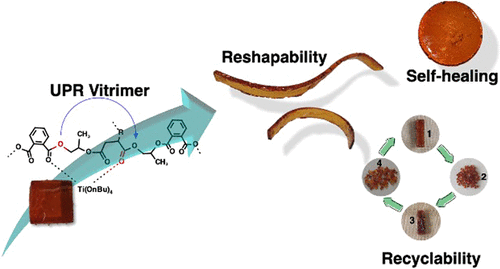
45) Sulfonated Polyether Ketone Membranes Embedded with Nalidixic Acid - An Emerging Controlled Drug Releaser
H.Padinjarathil, V.Vilasini, R.Balasubramanian, C.Drago, S.Dattilo, P.Ramani
Polymers
15(17),
3631
- 2023
DOI:
https://doi.org/10.3390/polym15173631
The effective administration of medication has advanced over decades, but the medical community still faces significant demand. Burst release and inadequate assimilation are major drawbacks that affect wound healing efficiency, leading to therapy failure. The widespread application of polymers in biomedical research is significant. The polyether ether ketone (PEEK) family is known for its biocompatibility, inertness, and semi-crystalline thermoplastic properties. In our present studies, we have chosen a member of this family, polyether ketone (PEK), to explore its role as a drug carrier. The PEK backbone was subjected to sulfonation to increase its hydrophilicity. The response surface methodology (RSM) was used to optimize the sulfonation process based on the time, degree of sulfonation, and temperature. The PEK polymer was sulfonated using sulfuric acid at 150 °C for 6 h; back titration was performed to quantify the degree of sulfonation, with 69% representing the maximum sulfonation. SPEK and nalidixic sodium salt were dissolved in dichloroacetic acid to create a thin membrane. The physiological and morphological properties were assessed for the SPEK membrane. The studies on drug release in distilled water and a simulated body fluid over the course of 24 h revealed a controlled, gradual increase in the release rate, correlating with a mathematical model and demonstrating the zero-order nature of the drug release. Hemolysis on the SPEK membrane revealed lower toxicity. The SPEK membrane’s biocompatibility was established using in vitro cytotoxicity tests on the Vero (IC50: 137.85 g/mL) cell lines. These results confirm that the SPEK membranes are suitable for sustained drug release.
46) Packaging effects on highly nutritional value beverage obtained by a mix of typical sicilian fruits in accelerated storage
V.Rizzo, S.Dattilo, S.Barbagallo, C.Puglisi, G.Muratore
Food Packaging and Shelf Life
38,
101138
- 2023
DOI:
https://doi.org/10.1016/j.fpsl.2023.101138
Consumers' knowledge has been improved and now they are aware of the importance of consuming healthy food. They know how food and beverages are linked with the proper functioning of their body, so are always more drawn towards consuming healthy products with high nutritional value. The new challenge for soft drink producers is the increasing interest in high nutritive quality products. Therefore such high-quality fruit juice is required to meet consumer needs, but also to ensure safety aspects in order to prolong shelf life. The aim of this research was to understand the most suitable packaging through experimental research to preserve over time the chemical-physical characteristics of a beverage with a high nutritional value obtained by mixing blood orange, pomegranate, and prickly pear juices. The three types of stand-up pouches tested were respectively transparent packaging (PT) (PET/OPA/PE), metalized packaging (PM) (PET/ALU/PET/PE), and totally recyclable packaging (PR) (OPP/OPP/PP). On stand-up pouches, weight loss (%), color intensity, browning index (BI), anthocyanin content (mg/L), total phenols, antioxidant activity (%), and flavonoids were monitored during storage at +45 °C, 65 % RH for accelerated ageing. Results have shown that PR performances were good, it kept high qualitative characteristics among the packaging tested it is the advisable best packaging solution because it certainly offers a valid alternative in terms of performance and a lower environmental impact compared to PM or to traditional packaging (glass), thus representing a more sustainable, effective and innovative choice.
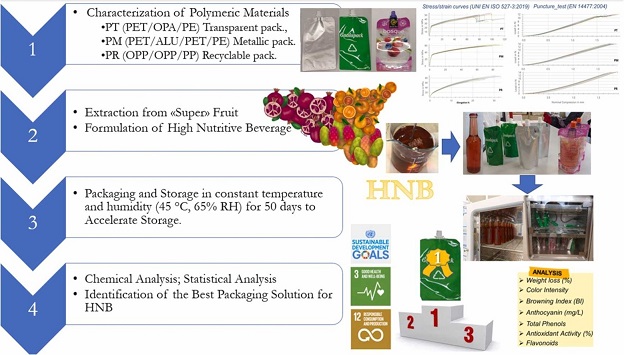
47) Total Bio-Based Material for Drug Delivery and Iron Chelation to Fight Cancer through Antimicrobial Activity
V.Patamia, C.Zagni, R.Fiorenza, V.Fuochi, S.Dattilo, P.M.Riccobene, P.M.Furneri, G.Floresta, A.Rescifina
Nanomaterials
13(14),
2036
- 2023
DOI:
https://doi.org/10.3390/nano13142036
Bacterial involvement in cancer’s development, along with their impact on therapeutic interventions, has been increasingly recognized. This has prompted the development of novel strategies to disrupt essential biological processes in microbial cells. Among these approaches, metal-chelating agents have gained attention for their ability to hinder microbial metal metabolism and impede critical reactions. Nanotechnology has also contributed to the antibacterial field by offering various nanomaterials, including antimicrobial nanoparticles with potential therapeutic and drug-delivery applications. Halloysite nanotubes (HNTs) are naturally occurring tubular clay nanomaterials composed of aluminosilicate kaolin sheets rolled multiple times. The aluminum and siloxane groups on the surface of HNTs enable hydrogen bonding with biomaterials, making them versatile in various domains, such as environmental sciences, wastewater treatment, nanoelectronics, catalytic studies, and cosmetics. This study aimed to create an antibacterial material by combining the unique properties of halloysite nanotubes with the iron-chelating capability of kojic acid. A nucleophilic substitution reaction involving the hydroxyl groups on the nanotubes? surface was employed to functionalize the material using kojic acid. The resulting material was characterized using infrared spectroscopy (IR), thermogravimetric analysis (TGA), energy-dispersive X-ray spectroscopy (EDX), and scanning electron microscopy (SEM), and its iron-chelating ability was assessed. Furthermore, the potential for drug loading - specifically, with resveratrol and curcumin - was evaluated through ultraviolet (UV) analysis. The antibacterial assay was evaluated following CLSI guidelines. The results suggested that the HNTs-kojic acid formulation had great antibacterial activity against all tested pathogens. The outcome of this work yielded a novel bio-based material with dual functionality as a drug carrier and an antimicrobial agent. This innovative approach holds promise for addressing challenges related to bacterial infections, antibiotic resistance, and the development of advanced therapeutic interventions.
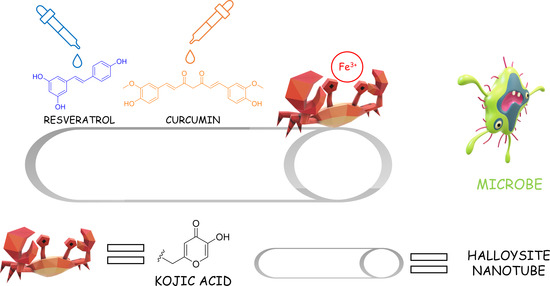
48) N-acetylneuraminate pyruvate lyase controls sialylation of muscle glycoproteins essential for muscle regeneration and function
A.Da Silva, J.Dort, Z.Orfi, X.Pan, S.Huang, I.Kho, E.Heckel, G.Muscarnera, P.Piet van Vliet, L.Sturiale, A.Messina, D.Romeo, C.D.M.van Karnebeek, X.Wen, A.Hinek, T.Molina, G.Andelfinger, B.Ellezam, Y.Yamanaka, H.J.Olivos, C.R.Morales, J.Joyal, D.J.Lefeber, D.Garozzo, N.A.Dumont, A.V.Pshezhetsky
Science Advances
9(26)
- 2023
DOI:
https://doi.org/10.1126/sciadv.ade6308
Deleterious variants in N-acetylneuraminate pyruvate lyase (NPL) cause skeletal myopathy and cardiac edema in humans and zebrafish, but its physiological role remains unknown. We report generation of mouse models of the disease: NplR63C, carrying the human p.Arg63Cys variant, and Npldel116 with a 116-bp exonic deletion. In both strains, NPL deficiency causes drastic increase in free sialic acid levels, reduction of skeletal muscle force and endurance, slower healing and smaller size of newly formed myofibers after cardiotoxin-induced muscle injury, increased glycolysis, partially impaired mitochondrial function, and aberrant sialylation of dystroglycan and mitochondrial LRP130 protein. NPL-catalyzed degradation of sialic acid in the muscle increases after fasting and injury and in human patient and mouse models with genetic muscle dystrophy, demonstrating that NPL is essential for muscle function and regeneration and serves as a general marker of muscle damage. Oral administration of N-acetylmannosamine rescues skeletal myopathy, as well as mitochondrial and structural abnormalities in NplR63C mice, suggesting a potential treatment for human patients.
49) Matrix-Assisted Laser Desorption and Electrospray Ionization Tandem Mass Spectrometry of Microbial and Synthetic Biodegradable Polymers
P.Rizzarelli, M.Rapisarda
Polymers
15(10),
2356
- 2023
DOI:
https://doi.org/10.3390/polym15102356
The in-depth structural and compositional investigation of biodegradable polymeric materials, neat or partly degraded, is crucial for their successful applications. Obviously, an exhaustive structural analysis of all synthetic macromolecules is essential in polymer chemistry to confirm the accomplishment of a preparation procedure, identify degradation products originating from side reactions, and monitor chemical-physical properties. Advanced mass spectrometry (MS) techniques have been increasingly applied in biodegradable polymer studies with a relevant role in their further development, valuation, and extension of application fields. However, single-stage MS is not always sufficient to identify unambiguously the polymer structure. Thus, tandem mass spectrometry (MS/MS) has more recently been employed for detailed structure characterization and in degradation and drug release monitoring of polymeric samples, among which are biodegradable polymers. This review aims to run through the investigations carried out by the soft ionization technique matrix-assisted laser desorption/ionization mass spectrometry (MALDI-MS) and electrospray ionization mass spectrometry (ESI-MS) MS/MS in biodegradable polymers and present the resulting information.
50) Preventing lead leakage in perovskite solar cells with a sustainable titanium dioxide sponge
S.Valastro, E.Smecca, G.Mannino, C.Bongiorno, G.Fisicaro, S.Goedecker, V.Arena, C.Spampinato, I.Deretzis, S.Dattilo, A.Scamporrino, S.Carroccio, E.Fazio, F.Neri, F.Bisconti, A.Rizzo, C.Spinella, A.La Magna, A.Alberti
Nature Sustainability
- 2023
DOI:
https://doi.org/10.1038/s41893-023-01120-w
As the market uptake of perovskite solar cells (PSCs) is projected to grow rapidly, this clean energy technology will play an increasingly important role in reducing the global carbon footprint. However, one of the major barriers to its full commercialization is the presence of toxic lead (Pb), which enables the current record in photoconversion efficiency but risks being released into the environment when subjected to water or rain. Here we show that Pb leakage can be prevented by applying a transparent titanium dioxide (TiO2) sponge that allows for an efficient Pb sequestration of 58 ng cm-2 nm-1. Already an essential material for PSCs, the additional use of TiO2 through a scalable and solvent-free sputtering process promises extra cost benefits and higher sustainability. Further demonstration of the sponge application with desired thickness on ready-to-use devices, glass and polymeric foils enforces the practical value of the current approach. Our study provides a sustainable solution to one of the environmental and health risks of PSCs and would accelerate their practical applications.
51) Sponge-like macroporous cyclodextrin-based cryogels for controlled drug delivery
C.Zagni, A.Coco, T.Mecca, G.Curcuruto, V.Patamia, K.Mangano, A.Rescifina, S.Carroccio
Materials Chemistry Frontiers
- 2023
DOI:
https://doi.org/10.1039/D3QM00139C
New drug delivery systems for wound healing applications based on α
/β/γ-cyclodextrin (α/β/γ-CD) acrylic (A) and styrenic (S) monomers have been synthesized and co-polymerized with 2-hydroxyethyl methacrylate (HEMA)
via a cryo-polymerization technique. The 3D macroporous cryogels containing hydrophobic cavities were loaded with lomefloxacin (LOM), piroxicam (PIR), and fluconazole (FLU) with a drug loading efficiency (DLE) of up to 78%. Depending on the formulated systems, the release of drugs under different stimuli was achieved, with efficiencies ranging from 23 to 95%. It was demonstrated that the presence of CDs within cryogels determines benefits both in loading capacity and drug delivery. CD derivatives were simultaneously loaded with LOM and PIR and tested for multi-drug release. This non-conventional approach was successfully designed as a proof of concept responding to the need to preserve a sterile target area, facilitating skin repair in wound healing applications. For this purpose, the biocompatibility of CD formulations was ascertained against human fibroblasts.

52) Lead Detection in a Gig-Lox TiO2 Sponge by X-ray Reflectivity
V.Arena, E.Smecca, S.Valastro, C.Bongiorno, G.Fisicaro, I.Deretzis, C.Spampinato, G.Mannino, S.Dattilo, A.Scamporrino, S.Carroccio, A.La Magna, A.Alberti
Nanomaterials
13(8),
1397
- 2023
DOI:
https://doi.org/10.3390/nano13081397
The importance of lead analysis in environmental matrices becomes increasingly relevant due to the anthropogenic spread of toxic species in nature. Alongside the existing analytical methods to detect lead in a liquid environment, we propose a new dry approach for lead detection and measurement based on its capture from a liquid solution by a solid sponge and subsequent quantification based on X-ray analyses. The detection method exploits the relationship between the electronic density of the solid sponge, which depends on the captured lead, and the critical angle for total reflection of the X-rays. For this purpose, gig-lox TiO2 layers, grown by modified sputtering physical deposition, were implemented for their branched multi-porosity spongy structure that is ideal for capturing lead atoms or other metallic ionic species in a liquid environment. The gig-lox TiO2 layers grown on glass substrates were soaked into aqueous solutions containing different concentrations of Pb, dried after soaking, and finally probed through X-ray reflectivity analyses. It has been found that lead atoms are chemisorbed onto the many available surfaces within the gig-lox TiO2 sponge by establishing stable oxygen bonding. The infiltration of lead into the structure causes an increase in the overall electronic density of the layer and, thus, an increment of its critical angle. Based on the established linear relationship between the amount of lead adsorbed and the augmented critical angle, a standardized quantitative procedure to detect Pb is proposed. The method can be, in principle, applied to other capturing spongy oxides and toxic species.
53) Photo- and Water-Degradation Phenomena of ZnO Bio-Blend Based on Poly(lactic acid) and Polyamide 11
R.Puglisi, A.Scamporrino, N.T.Dintcheva, G.Filippone, E.Bruno, P.Scarfato, P.Cerruti, S.Carroccio
Polymers
15(6),
1434
- 2023
DOI:
https://doi.org/10.3390/polym15061434
The goal of this work was to investigate the morphological and chemical?physical changes induced by adding ZnO nanoparticles to bio-based polymeric materials based on polylactic acid (PLA) and polyamide 11 (PA11). Precisely, the photo- and water-degradation phenomena of nanocomposite materials were monitored. For this purpose, the formulation and characterization of novel bio-nanocomposite blends based on PLA and PA11 at a ratio of 70/30 wt.% filled with zinc oxide (ZnO) nanostructures at different percentages were performed. The effect of ZnO nanoparticles (≤2 wt.%) within the blends was thoroughly explored by employing thermogravimetry (TGA), size exclusion chromatography (SEC), matrix-assisted laser desorption ionization-time-of-flight mass spectrometry (MALDI-TOF MS) and scanning and transmission electron microscopy (SEM and TEM). Adding up to 1% wt. of ZnO resulted in a higher thermal stability of the PA11/PLA blends, with a decrement lower than 8% in terms of molar masses (MMs) values being obtained during blend processing at 200 °C. ZnO promoted trans-ester-amide reactions between the two polymers, leading to the formation of PLA/PA11 copolymers. These species could work as compatibilisers at the polymer interface, improving thermal and mechanical properties. However, the addition of higher quantities of ZnO affected such properties, influencing the photo-oxidative behaviour and thus thwarting the material’s application for packaging use. The PLA and blend formulations were subjected to natural aging in seawater for two weeks under natural light exposure. The 0.5% wt. ZnO sample induced polymer degradation with a decrease of 34% in the MMs compared to the neat samples.
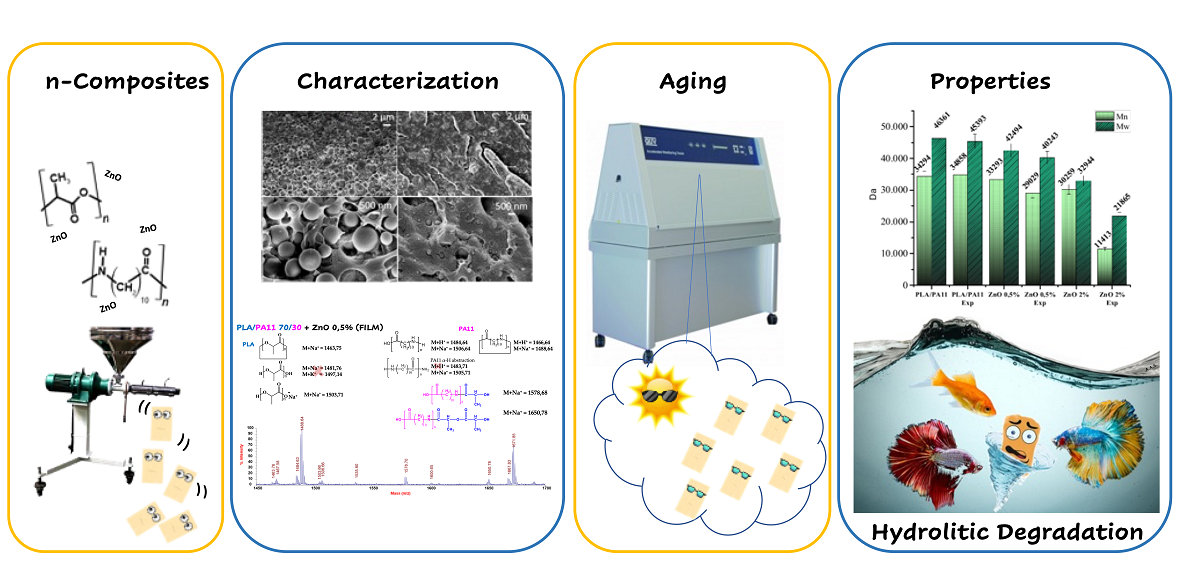
54) Soluble peptidoglycan fragments produced by Limosilactobacillus fermentum with antiproliferative activity are suitable for potential therapeutic development: A preliminary report
V.Fuochi, M.Spampinato, A.Distefano, A.Palmigiano, D.Garozzo, C.Zagni, A.Rescifina, G.Li Volti, P.M.Furneri
Frontiers in Molecular Biosciences
10,
1082526
- 2023
DOI:
https://doi.org/10.3389/fmolb.2023.1082526
Currently, the use of probiotic strains and their products represents a promising innovative approach as an antagonist treatment against many human diseases. Previous studies showed that a strain of Limosilactobacillus fermentum (LAC92), previously defined as Lactobacillus fermentum, exhibited a suitable amensalistic property. The present study aimed to purify the active components from LAC92 to evaluate the biological properties of soluble peptidoglycan fragments (SPFs). The cell-free supernatant (CFS) and bacterial cells were separated after 48 h of growth in MRS medium broth and treated for isolation of SPFs. Antimicrobial activity and proliferation analysis on the human cell line HTC116 were performed using technologies such as xCELLigence, count and viability, and clonogenic analysis. MALDI-MS investigation and docking analysis were performed to determine the molecular structure and hypothetical mode of action, respectively. Our results showed that the antimicrobial activity was mainly due to SPFs. Moreover, the results obtained when investigating the SPF effect on the cell line HCT116 showed substantial preliminary evidence, suggesting their significant cytostatic and quite antiproliferative properties. Although MALDI was unable to identify the molecular structure, it was subsequently revealed by analysis of the bacterial genome. The amino acid structure is called peptide 92. Furthermore, we confirmed by molecular docking studies the interaction of peptide 92 with MDM2 protein, the negative regulator of p53. This study showed that SPFs from the LAC92 strain exerted anticancer effects on the human colon cancer HCT116 cell line via antiproliferation and inducing apoptosis. These findings indicated that this probiotic strain might be a potential candidate for applications in functional products in the future. Further examination is needed to understand the specific advantages of this probiotic strain and improve its functional features to confirm these data. Moreover, deeper research on peptide 92 could increase our knowledge and help us understand if it will be possible to apply to specific diseases such as CRC.
55) Solid-State Preparation and Characterization of 2-Hydroxypropylcyclodextrins-Iodine Complexes as Stable Iodophors
S.Dattilo, F.Spitaleri, D.Aleo, M.G.Saita, A.Patti
Biomolecules
13(3),
474
- 2023
DOI:
https://doi.org/10.3390/biom13030474
The use of iodine as antiseptic poses some issues related to its low water solubility and high volatility. Stable solid iodine-containing formulations are highly advisable and currently limited to the povidone-iodine complex. In this study, complexes of molecular iodine with 2-hydroxypropyl α-, β- and γ-cyclodextrins were considered water-soluble iodophors and prepared in a solid state by using three different methods (liquid-assisted grinding, co-evaporation and sealed heating). The obtained solids were evaluated for their iodine content and stability over time in different conditions using a fully validated UV method. The assessment of the actual formation of an inclusion complex in a solid state was carried out by thermal analysis, and the presence of iodine was further confirmed by SEM/EDX and XPS analyses. High levels of iodine content (8.3-10.8%) were obtained with all the tested cyclodextrins, and some influence was exerted by the employed preparation method. Potential use as solid iodophors can be envisaged for these iodine complexes, among which those with 2-hydroxypropyl-α-cyclodextrin were found the most stable, regardless of the preparation technique. The three prepared cyclodextrin?iodine complexes proved effective as bactericides against
S. epidermidis.
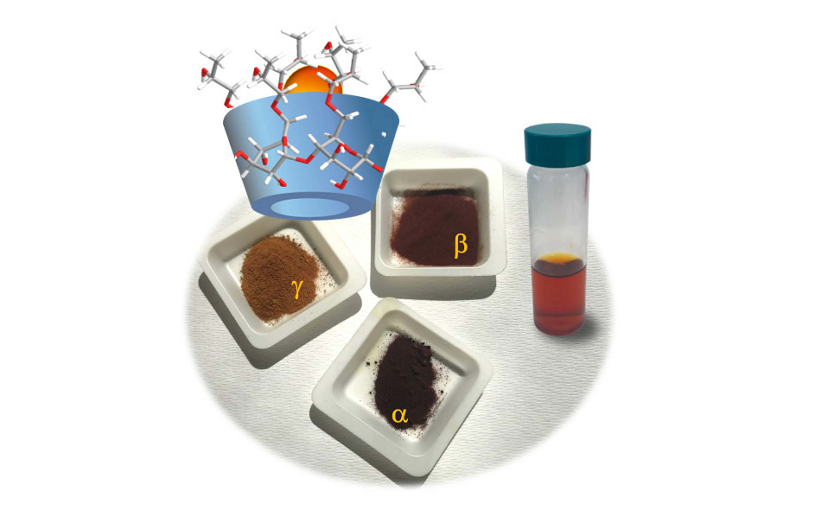
56) Spontaneous polymerization of benzofulvene monomers bearing a 4-Pyridylacetylene substituent in different positions of the benzofulvene scaffold
M.Paolino, M.Saletti, A.Reale, V.Razzano, G.Giuliani, A.Donati, C.Bonechi, G.Giorgi, G.Mercorillo, F.Samperi, W.Mroz, C.Botta, A.Cappelli
European Polymer Journal
189,
111957
- 2023
DOI:
https://doi.org/10.1016/j.eurpolymj.2023.111957
Two benzofulvene derivatives bearing a 4-pyridylacetylene substituent in different positions (i. e. 2 and 6) of the benzofulvene scaffold are designed and synthesized to evaluate the effects on the spontaneous solid-state polymerization of the presence of the same substituent in two different key positions of the 3-phenylbenzofulvene moiety. Both the benzofulvene derivatives showed the tendency to polymerize spontaneously in the consequence of solvent removal under reduced pressure without the addition of catalysts or initiators. The macromolecular structure of the stemming polymeric materials was investigated by NMR spectroscopy and MALDI-TOF mass spectrometry. Both NMR and MALDI-TOF studies confirmed the polymeric nature of the materials and suggested for the polybenzofulvene derivative bearing the 4-pyridylacetylene substituent in positions 6 a higher structural homogeneity with respect to the one bearing the same substituent in position 2. The photophysical characterization of the most homogeneous polybenzofulvene derivative led to the discovery of its outstanding hole mobility value, which was found to be around one order of magnitude higher than that previously measured for two oligothiophene-based polybenzofulvene derivatives and almost two orders of magnitude higher than that of poly(vinylcarbazole), commonly used as hole-transporter matrix. This result places the new polybenzofulvene derivative in an outstanding position as a promising material for field-effect transistor (FET) device applications.
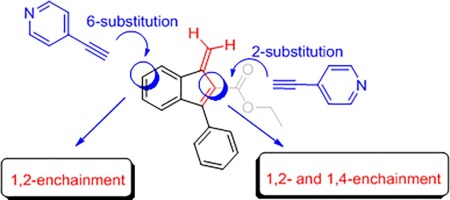
57) Temperature Responsive Copolymers Films of Polyether and Bio-Based Polyamide Loaded with Imidazolium Ionic Liquids for Smart Packaging Applications
D.Zampino, G.Clarizia, P.Bernardo
Polymers
15(5),
1147
- 2023
DOI:
https://doi.org/10.3390/polym15051147
Temperature-responsive materials are highly interesting for temperature-triggered applications such as drug delivery and smart packaging. Imidazolium Ionic Liquids (ILs), with a long side chain on the cation and a melting temperature of around 50 °C, were synthetized and loaded at moderate amounts (up to 20 wt%) within copolymers of polyether and a bio-based polyamide via solution casting. The resulting films were analyzed to assess their structural and thermal properties, and the gas permeation changes due to their temperature-responsive behavior. The splitting of FT-IR signals is evident, and, in the thermal analysis, a shift in the glass transition temperature (Tg) for the soft block in the host matrix towards higher values upon the addition of both ILs is also observed. The composite films show a temperature-dependent permeation with a step change corresponding to the solid-liquid phase change in the ILs. Thus, the prepared polymer gel/ILs composite membranes provide the possibility of modulating the transport properties of the polymer matrix simply by playing with temperature. The permeation of all the investigated gases obeys an Arrhenius-type law. A specific permeation behavior, depending on the heating-cooling cycle sequence, can be observed for carbon dioxide. The obtained results indicate the potential interest of the developed nanocomposites as CO2 valves for smart packaging applications.
58) Polymer Blends Based on 1-Hexadecyl-3-methyl Imidazolium 1,3-Dimethyl 5-Sulfoisophthalate Ionic Liquid: Thermo-Mechanical, Surface Morphology and Antibacterial Properties
D.Zampino, F.Samperi, M.Mancuso, T.Ferreri, L.Ferreri, S.Dattilo, E.F.Mirabella, D.C.Carbone, G.Recca, A.Scamporrino, E.Novello, C.Puglisi
Polymers
15(4),
970
- 2023
DOI:
https://doi.org/10.3390/polym15040970
In this study, antibacterial polymer blends based on Polyvinyl Chloride (PVC) and Polystyrene-Ethylene-Butylene-Styrene (SEBS), loaded with the ionic liquid (IL) 1-hexadecyl-3-methyl imidazolium 1,3-dimethyl 5-sulfoisophthalate (HdmimDMSIP) at three different concentrations (1%, 5%, and 10%), were produced. The IL/blends were characterized by their thermo-mechanical properties, surface morphology, and wettability. IL release from the blends was also evaluated. The agar diffusion method was used to test the antibacterial activity of the blends against Staphylococcus epidermidis and Escherichia coli. Results from thermal analyses showed compatibility between the IL and the PVC matrix, while phase separation in the SEBS/IL blends was observed. These results were confirmed using PY-GC MS data. SEM analyses highlighted abundant IL deposition on PVC blend film surfaces containing the IL at 5-10% concentrations, whereas the SEBS blend film surfaces showed irregular structures similar to islands of different sizes. Data on water contact angle proved that the loading of the IL into both polymer matrices induced higher wettability of the blends’ surfaces, mostly in the SEBS films. The mechanical analyses evidenced a lowering of Young’s Modulus, Tensile Stress, and Strain at Break in the SEBS blends, according to IL concentration. The PVC/IL blends showed a similar trend, but with an increase in the Strain at Break as IL concentration in the blends increased. Both PVC/IL and SEBS/IL blends displayed the best performance against Staphylococcus epidermidis, being active at low concentration (1%), whereas the antimicrobial activity against Escherichia coli was lower than that of S. epidermidis. Release data highlighted an IL dose-dependent release. These results are promising for a versatile use of these antimicrobial polymers in a variety of fields.
59) Higher frequency of TMEM199-CDG in the southern mediterranean area is associated with c.92G>C (p.Arg31Pro) mutation
A.Fiumara, A.Sapuppo, L.Ferri, A.Arena, A.Prato, D.Garozzo, L.Sturiale, A.Morrone, R.Barone
European Journal of Medical Genetics
66(3),
104709
- 2023
DOI:
https://doi.org/10.1016/j.ejmg.2023.104709
Congenital disorders of glycosylation (CDG) are genetic multisystem diseases, characterized by defective glycoconjugate synthesis. A small number of CDG with isolated liver damage have been described, such as TMEM199-CDG, a non-encephalopathic liver disorder with Wilson disease-like phenotype. Only eight patients with TMEM199-CDG have been described including seven Europeans (originating from Greece and Italy) and one Chinese. Three patients from southern Italy (Campania) shared the same known missense mutation pathogenetic variant NM_152464.3:c. 92G > C (p.Arg31Pro), also found in a Greek patient.
Here we report a new patient from southern Italy (Sicily), with a homozygous c.92G > C p.(Arg31Pro) variant in TMEM199. The patient’s phenotype is characterized by mild non-progressive hepatopathy with a normal hepatic echo structure. A persistent increase in serum transaminases, total and low-density lipoprotein cholesterol and low serum ceruloplasmin and copper levels and normal urinary copper excretion were observed. Matrix-assisted laser desorption/ionization mass spectrometry analyses showed abnormal N- and O- protein glycosylation, indicative of a Golgi processing defect and supporting the function of TMEM199 in maintaining Golgi homeostasis. TMEM199-CDG is an ultra-rare CDG relatively frequent in the southern Mediterranean area (7 in 9 patients, 77%). It is mainly associated with the c.92G > C (p.Arg31Pro) pathogenetic allele globally reported in 4 out of 7 families (57%), including one from Greece and three unrelated families from southern Italy. The almost uniform clinical phenotype described in patients with TMEM199-CDG appears to reflect a higher prevalence of the same variant in patients from the southern Mediterranean area.
60) Calix[4]arene Derivative for Iodine Capture and Effect on Leaching of Iodine through Packaging
L.Ferreri, M.Rapisarda, M.Leanza, C.Munzone, N.D’Antona, G.M.L.Consoli, P.Rizzarelli, E.Spina
Molecules
28(4),
1869
- 2023
DOI:
https://doi.org/10.3390/molecules28041869
A hydrophobic calix[4]arene derivative was investigated for its iodine (I
2) capture efficiency from gaseous and liquid phase. The iodine uptake was followed by UV-vis spectroscopy. Additionally, the influence of the calix[4]arene derivative-polyolefin system on the leaching of iodine through packaging from a povidone-iodine-based (PVP-I) formulation was evaluated. In fact, iodine is a low-cost, multi-target, and broad-spectrum antiseptic. However, it is volatile, and the extended storage of I
2-based formulations is challenging in plastic packaging. Here, we investigated the possibility of reducing the loss of I
2 from an iodophor formulation by incorporating 4-tert-butylcalix [4]arene-tetraacetic acid tetraethyl ester (CX) and its iodine complex in high-density polyethylene (HDPE) or polypropylene (PP) via a swelling procedure. Surface and bulk changes were monitored by contact angle, thermogravimetric analysis (TGA), and UV-vis diffuse reflectance spectra. The barrier effect of the different polymeric systems (embedded with CX, iodine-CX complex, or I2) was evaluated by monitoring the I2 retention in a buffered PVP-I solution by UV-vis spectroscopy. Overall, experimental data showed the capability of the calix[4]arene derivative to complex iodine in solution and the solid state and a significant reduction in the iodine leaching by the PP-CX systems.
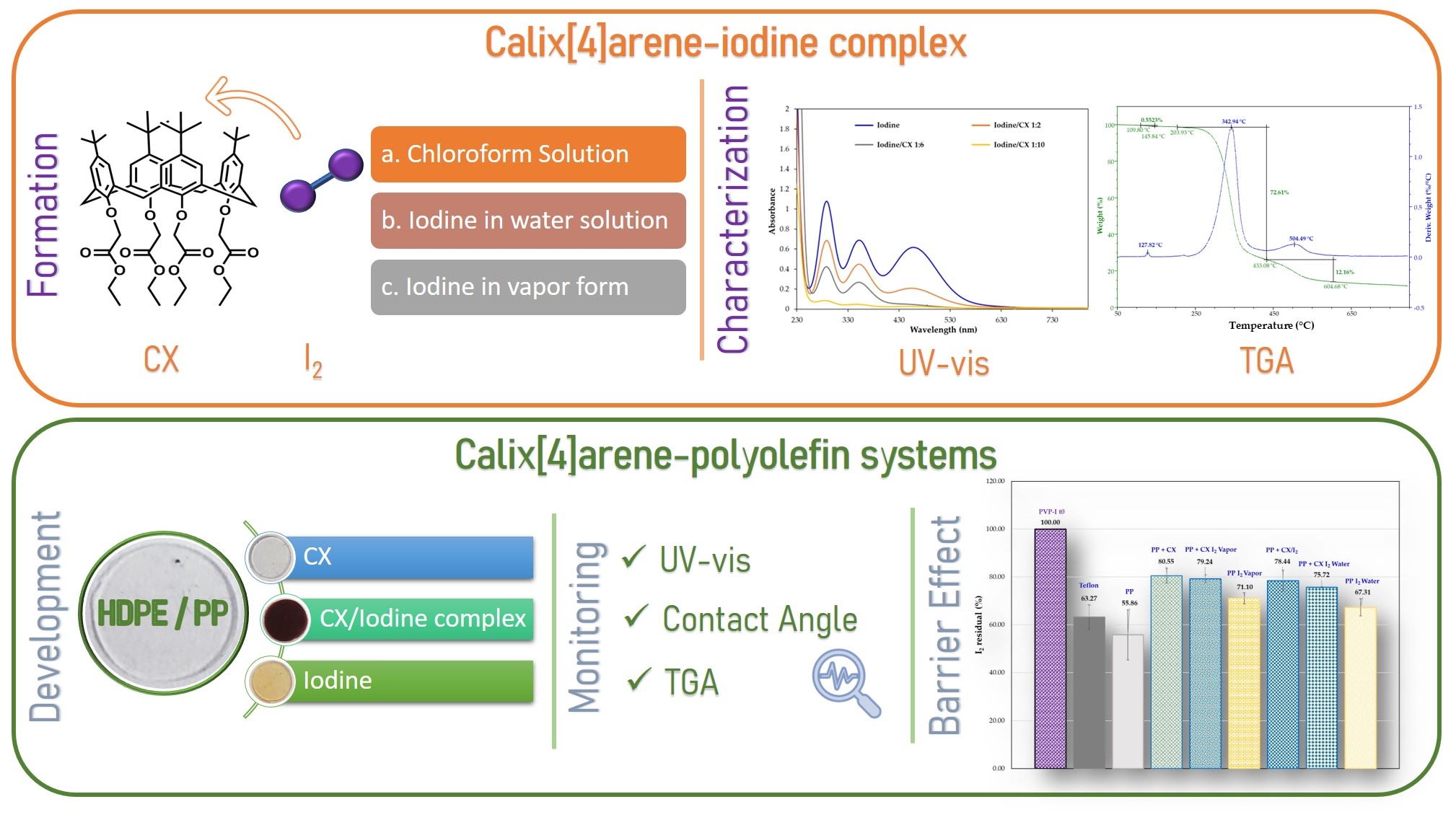
61) Design of an Antibiotic-Releasing Polymer: Physicochemical Characterization and Drug Release Patterns
H.Padinjarathil, S.Mudradi, R.Balasubramanian, C.Drago, S.Dattilo, N.K.Kothurkar, P.Ramani
Membranes
13(1),
102
- 2023
DOI:
https://doi.org/10.3390/membranes13010102
Conventional drug delivery has its share of shortcomings, especially its rapid drug release with a relatively short duration of therapeutic drug concentrations, even in topical applications. Prolonged drug release can be effectively achieved by modifying the carrier in a drug delivery system. Among the several candidates for carriers studied over the years, poly (ether ether ketone), a biocompatible thermoplastic, was chosen as a suitable carrier. Its inherent hydrophobicity was overcome by controlled sulfonation, which introduced polar sulfonate groups onto the polymer backbone. Optimization of the sulfonation process was completed by the variation of the duration, temperature of the sulfonation, and concentration of sulfuric acid. The sulfonation was confirmed by EDS and the degree of sulfonation was determined by an NMR analysis (61.6% and 98.9%). Various physical properties such as morphology, mechanical strength, and thermal stability were studied using scanning electron microscopy, tensile testing, and thermogravimetric analysis. Cytotoxicity tests were performed on the SPEEK samples to study the variation in biocompatibility against a Vero cell line. The drug release kinetics of ciprofloxacin (CP) and nalidixic acid sodium salt (NA)-loaded membranes were studied in deionized water as well as SBF and compared against the absorbance of standardized solutions of the drug. The data were then used to determine the diffusion, distribution, and permeability coefficients. Various mathematical models were used to fit the obtained data to establish the order and mechanism of drug release. Studies revealed that drug release occurs by diffusion and follows zero-order kinetics.
62) A novel material based on an antibacterial choline-calixarene nanoassembly embedded in thin films
L.Ferreri, G.M.L.Consoli, G.Clarizia, D.Zampino, A.Nostro, G.Granata, G.Ginestra, M.L. Giuffrida, S.Zimbone, P.Bernardo
Journal of Materials Science
57,
20685-20701
- 2022
DOI:
https://doi.org/10.1007/s10853-022-07868-4
Supramolecular chemistry is one of the current strategies for producing advanced materials. With the aim to develop new Thin-Films with antibacterial activity, we embedded an amphiphilic choline-calix[4]arene possessing antibacterial properties in polymeric Thin-Films based on polyether-co-amide matrix (Pebax®2533). The loading of the calix[4]arene derivative in the film was performed by solution casting. The amount of calixarene additive in the films was in the range of 0.5-5 wt%. The self-supported Thin-Films were characterized by investigating phase miscibility, morphology, spectral properties, and gas transport. The release of the calixarene derivative from the films was studied in a biomimetic medium as PBS (10 mM, pH 7.4). The presence of the additive did not affect the thermal stability of the copolymer, whereas it induced an increase in crystallinity, wettability, and gas permeability of the blend films according to its concentration. The antibacterial activity of the films was evaluated in vitro against
Escherichia coli and
Staphylococcus aureus strains, representative of Gram-negative and Gram-positive bacteria. The developed films displayed antibacterial activity against both strains. In particular, Pebax
® - 5 wt% Chol-Calix caused within 10 h a reduction in
E. coli and
S. aureus of 2.57 and 2 log CFU/mL, respectively. The potential toxicity of the films was also tested on mouse embryonic fibroblasts NIH/3T3. Pebax
®2533/calixarene derivative combination appears a promising approach for the development of novel flexible antibacterial materials.
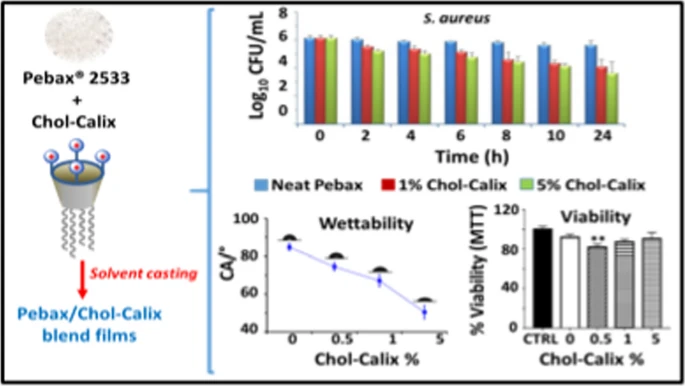
63) Synthesis, Characterization, and Soil Burial Degradation of Biobased Polyurethanes
A.Zuliani, M.Rapisarda, D.Chelazzi, P.Baglioni, P.Rizzarelli
Polymers
14(22),
4948
- 2022
DOI:
https://doi.org/10.3390/polym14224948
There is an urgent need for developing degradable polymeric systems based on bio-derived and sustainable materials. In recent years, polyurethanes derived from castor oil have emerged due to the large availability and sustainable characteristics of castor oil. However, these polymers are normally prepared through tedious and/or energy-intensive procedures or using high volatile and/or toxic reagents such as volatile isocyanates or epoxides. Furthermore, poor investigation has been carried out to design castor oil derived polyurethanes with degradable characteristics or thorough specifically sustainable synthetic procedures. Herein, castor oil-derived polyurethane with more than 90% biomass-derived carbon content and enhanced degradable features was prepared through a simple, eco-friendly (E-factor: 0.2), and scalable procedure, employing a recently developed commercially available biomass-derived (61% bio-based carbon content) low-volatile polymeric isocyanate. The novel material was compared with a castor oil derived-polyurethane prepared with a commercially available fossil-based isocyanate counterpart. The different castor oil-derived polyurethanes were investigated by means of water uptake, soil burial degradation, and disintegration tests in compost. Characterization analyses, including thermogravimetric analysis (TGA), differential scanning calorimetry (DSC), attenuated total reflection Fourier transform infrared spectroscopy (ATR-FTIR) and scanning electron microscopy (SEM), were carried out both prior to and after degradation tests. The results suggest potential applications of the degradable castor oil-derived polyurethane in different fields, such as mulch films for agricultural purposes.
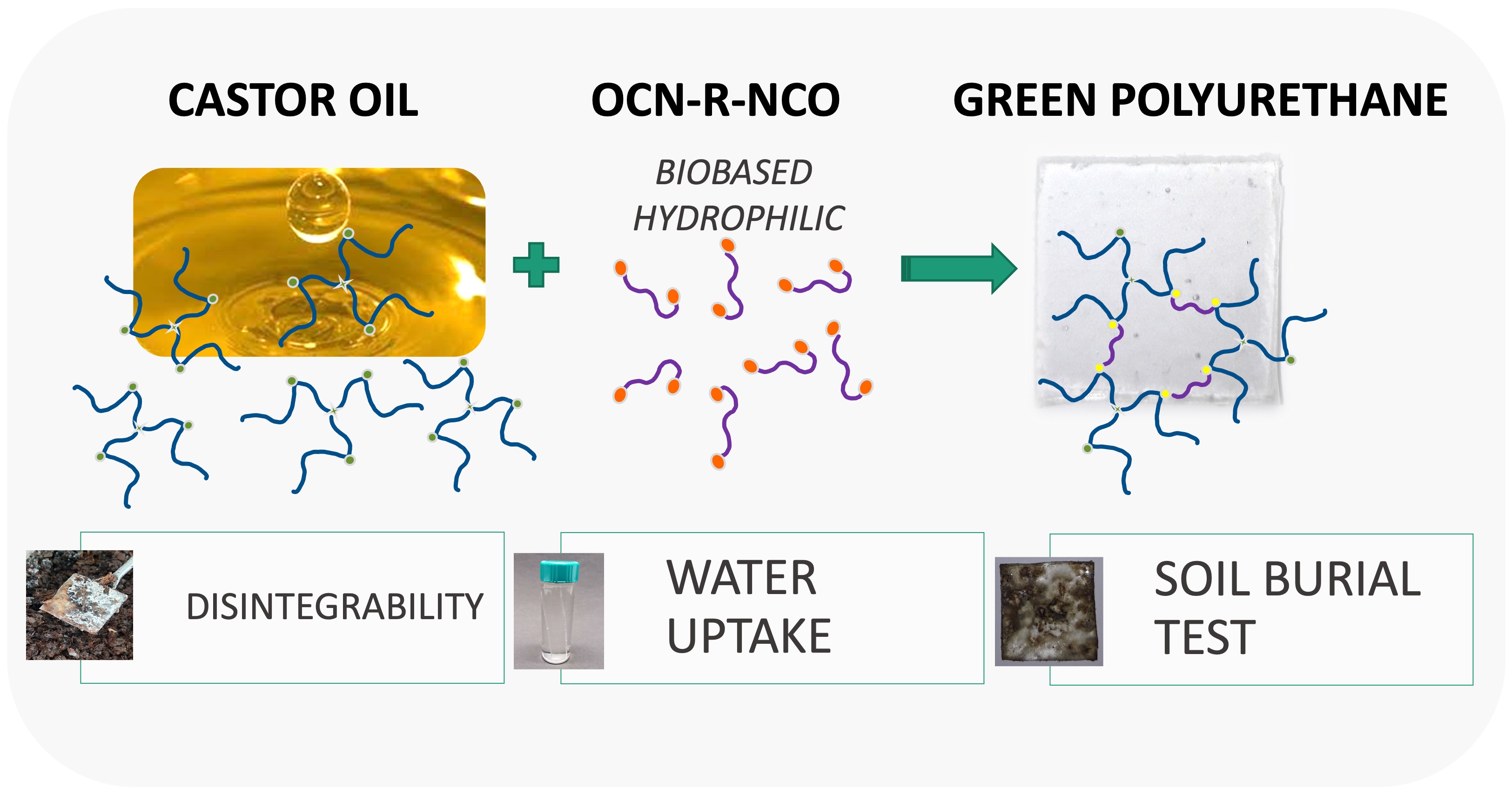
64) Full Recycling and Re-Use of Bio-Based Epoxy Thermosets: Chemical and Thermomechanical Characterization of the Recycled Matrices
S.Dattilo, G.Cicala, P.M.Riccobene, C.Puglisi, L.Saitta
Polymers
14(22),
4828
- 2022
DOI:
https://doi.org/10.3390/polym14224828
High performances of thermosets deriving from their covalent intermolecular cross-link bonds result in their low recyclability hindering the full exploitation of a truly circular approach for cured thermosets. In this experimental work, the recyclability of a bio-based fully recyclable epoxy resin using a mild chemical recycling process was demonstrated. The recycled polymer obtained was fully characterized to ascertain its structure and properties. MALDI (Matrix-Assisted Laser Desorption/Ionization), GPC (Gel Permeation Chromatography) and NMR (Nuclear Magnetic Resonance) spectroscopy to determine the chemical structure of the recycled polymer were used. The thermomechanical properties of the cured virgin network and of the recycled product obtained were measured by DSC (Differential Scanning Calorimetry) and DMA (Dynamic Mechanical Analysis). Thermogravimetric analysis of the recycled polymer was also performed. The recycled polymer was transformed into a polyurethane by reacting it with an isocyanate. The synthetized polyurethane obtained therefrom was thoroughly characterized by thermogravimetric analysis. This approach proved the possibility to up-scale the recycled product making it available for novel applications exploiting its re-use.
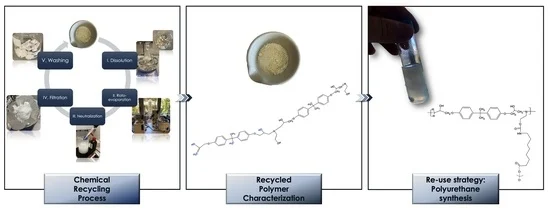
65) Single and dual polymeric sponges for emerging pollutants removal
C.Zagni, S.Dattilo, T.Mecca, C.Gugliuzzo, A.Scamporrino, V.Privitera, R.Puglisi, S.Carroccio
European Polymer journal
179
- 2022
DOI:
https://doi.org/10.1016/j.eurpolymj.2022.111556
A platform of polymeric cryogels based on methacrylic acid (C-mA) meglumine (C-megl), lysine (C-lys), and 2-hydroxy ethyl methacrylate (C-ph), as well as a combination thereof having both negatively and positively charged moieties, have been synthesized and used to efficiently remove emerging contaminants from water. Their peculiar properties in sequestering antibiotics (Levofloxacin, Ampicillin, Doxycycline), anti-inflammatory (Piroxicam), antifungal (Fluconazole), anti-parasite (Moxidectin), pesticides (2,4D) and dyes (Thymol blue, Methylene Violet) were tested taking into account their ionic nature in solution. The adsorption experiments performed in batches at different pH and pollutant concentrations have demonstrated the outstanding ability of these macroporous soft systems in complexing molecules by the instauration of various binding forces, also in the presence of inorganic species such as arsenic (as arseniate). In addition, it was demonstrated as the novel dual-material,
ad-hoc synthesized by using opposite charge cryogels, can simultaneously remove antagonist dyes in a single and fast cycle. Besides, a quasi-total release of the target molecules was achieved by changing pH, allowing the regeneration of the macroporous sponges for multiple re-uses without losing their performance. The latter peculiar feature may be adopted for drug delivery applications since the release can be modulated and programmed by a specific pH stimulus.

66) Polymer aging affects the bioavailability of microplastics-associated contaminants in sea urchin embryos
M.V.Di Natale, S.Carroccio, S.Dattilo, M.Cocca, A.Nicosia, M.Torri, C.D.Bennici, M.Musco, T.Masullo, S.Russo, A.Mazzola, A.Cuttitta
Chemosphere
309(1)
- 2022
DOI:
https://doi.org/10.1016/j.chemosphere.2022.136720
Microplastics (MP
s) in the marine environment undergo complex weathering factors that can affect their ability to interact with different coexisting environmental contaminants (termed here co-contaminants). In this study, the influence of artificially aging using UV on the sorption of a complex mixture of co-contaminants onto MP
s was investigated in order to provide meaningful hypotheses on their individual and combined toxicities on sea urchin embryos. A mixture of artificially aged MP
s (PS particles and PA microfibers) combined with 2,2
',4,4
'-tetrabromodiphenyl ether (BDE-47), or Cd or Cu, both alone and in a mix, were used to expose embryos of
Paracentrotus lividus. The effects of polymer aging on co-contaminants bioavailability were assessed by measuring changes in the transcriptional profile of genes involved in oxidative-stress response and skeletogenic and endo-mesodermal specification. Changes in the sorption ability of MP
s to co-contaminants in the aqueous phase highlighted that aging did not affect the sorption of BDE-47 and Cd on MP
s, although a certain influence on Cu sorption was found. Despite no morphological effects in embryos at the gastrula stage after MP
s/contaminants combinatorial exposure emerged, the greatest influence of the aging process was mainly found for combined exposures which included BDE-47. Finally, the exposure to multiple contaminants generated transcriptional profiles poorly related to those activated by single contaminant, at times suggesting a mixture-dependent different aging influence. These results open new scenarios on the controversial role of vector of co-contaminants for MP
s, especially when complex and different types of mixtures were considered.
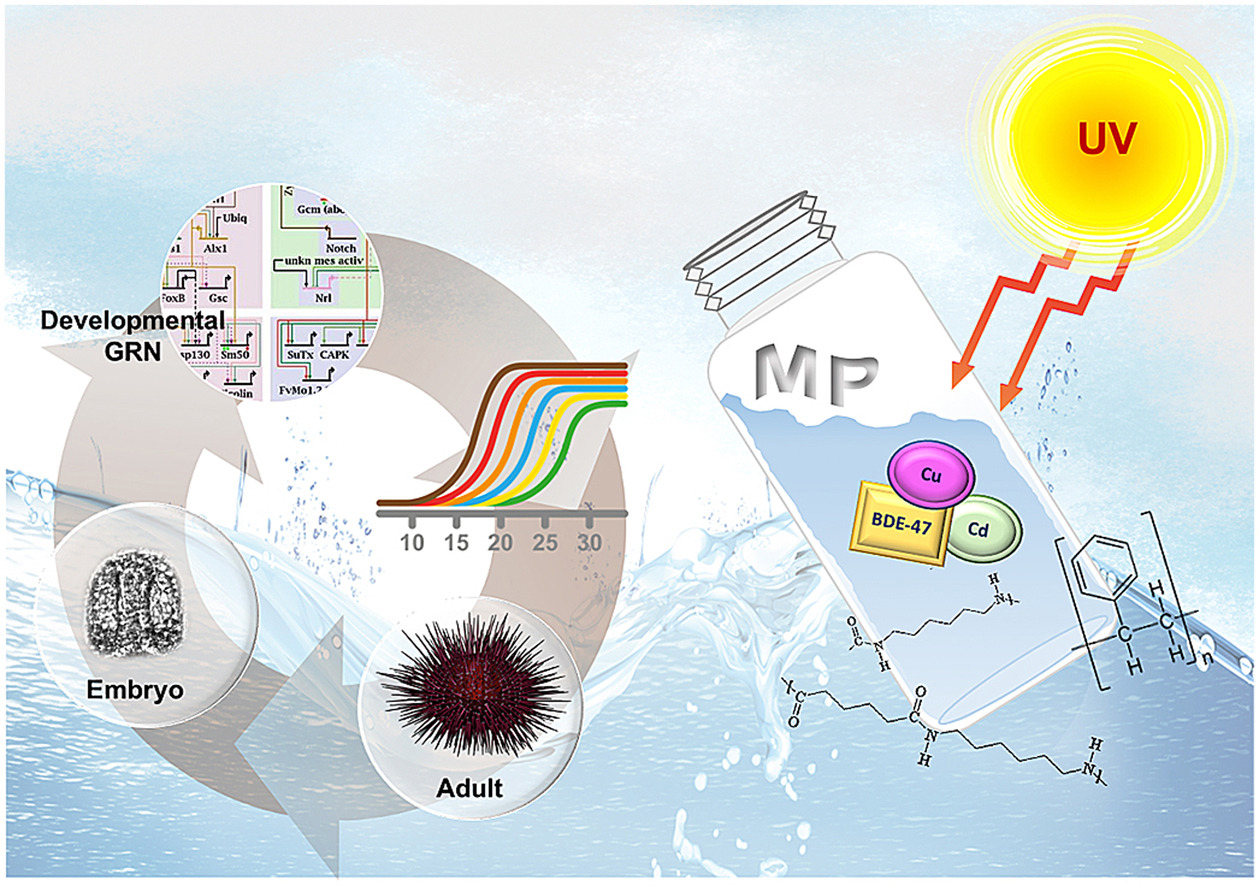
67) Phenotypic and genetic spectrum of ATP6V1A encephalopathy: a disorder of lysosomal homeostasis
R.Guerrini, D.Mei, K.Kerti-Szigeti, S.Pepe, M.Kay Koenig, G.Von Allmen, M.T Cho, K.McDonald, J.Baker, V.Bhambhani, Z.Powis, L.Rodan, R.Nabbout, G.Barcia, J.A.Rosenfeld, C.A.Bacino, C.Mignot, L.H.Power, C.J.Harris, D.Marjanovic, R.S.Møller, T.B.Hammer, The DDD Study, R.K.Filppula, P.Vieira, C.Hildebrandt, S.Sacharow, Undiagnosed Diseases Network, L.Maragliano, F.Benfenati, K.Lachlan, A.Benneche, F.Petit, J.M.De Sainte Agathe, B.Hallinan, Y.Si, I.M.Wentzensen, F.Zou, V.Narayanan, N.Matsumoto, A.Boncristiano, G.La Marca, M.Kato, K.Anderson, C.Barba, L.Sturiale, D.Garozzo, R.Bei, ATP6V1A collaborators, L.Masuelli, V.Conti, G.Novarino, A.Fassio
Brain
145(8),
2687-2703
- 2022
DOI:
https://doi.org/10.1093/brain/awac145
Vacuolar-type H+-ATPase (V-ATPase) is a multimeric complex present in a variety of cellular membranes that acts as an ATP-dependent proton pump and plays a key role in pH homeostasis and intracellular signalling pathways. In humans, 22 autosomal genes encode for a redundant set of subunits allowing the composition of diverse V-ATPase complexes with specific properties and expression. Sixteen subunits have been linked to human disease.
Here we describe 26 patients harbouring 20 distinct pathogenic de novo missense ATP6V1A variants, mainly clustering within the ATP synthase α/β
family-nucleotide-binding domain. At a mean age of 7 years (extremes: 6 weeks, youngest deceased patient to 22 years, oldest patient) clinical pictures included early lethal encephalopathies with rapidly progressive massive brain atrophy, severe developmental epileptic encephalopathies and static intellectual disability with epilepsy. The first clinical manifestation was early hypotonia, in 70%; 81% developed epilepsy, manifested as developmental epileptic encephalopathies in 58% of the cohort and with infantile spasms in 62%; 63% of developmental epileptic encephalopathies failed to achieve any developmental, communicative or motor skills. Less severe outcomes were observed in 23% of patients who, at a mean age of 10 years and 6 months, exhibited moderate intellectual disability, with independent walking and variable epilepsy. None of the patients developed communicative language. Microcephaly (38%) and amelogenesis imperfecta/enamel dysplasia (42%) were additional clinical features. Brain MRI demonstrated hypomyelination and generalized atrophy in 68%. Atrophy was progressive in all eight individuals undergoing repeated MRIs.
Fibroblasts of two patients with developmental epileptic encephalopathies showed decreased LAMP1 expression, Lysotracker staining and increased organelle pH, consistent with lysosomal impairment and loss of V-ATPase function. Fibroblasts of two patients with milder disease, exhibited a different phenotype with increased Lysotracker staining, decreased organelle pH and no significant modification in LAMP1 expression. Quantification of substrates for lysosomal enzymes in cellular extracts from four patients revealed discrete accumulation. Transmission electron microscopy of fibroblasts of four patients with variable severity and of induced pluripotent stem cell-derived neurons from two patients with developmental epileptic encephalopathies showed electron-dense inclusions, lipid droplets, osmiophilic material and lamellated membrane structures resembling phospholipids. Quantitative assessment in induced pluripotent stem cell-derived neurons identified significantly smaller lysosomes.
ATP6V1A-related encephalopathy represents a new paradigm among lysosomal disorders. It results from a dysfunctional endo-lysosomal membrane protein causing altered pH homeostasis. Its pathophysiology implies intracellular accumulation of substrates whose composition remains unclear, and a combination of developmental brain abnormalities and neurodegenerative changes established during prenatal and early postanal development, whose severity is variably determined by specific pathogenic variants.
68) CAMLG-CDG: a novel congenital disorder of glycosylation linked to defective membrane trafficking
M.P.Wilson, Z.Durin, Ö.Unal, B.G.Ng, T.Marrecau, L.Keldermans, E.Souche, D.Rymen, M.Gündüz, G.Köse, L.Sturiale, D.Garozzo, H.H.Freeze, J.Jaeken, F.Foulquier, G.Matthijs
Human molecular genetics
31(15),
2571-2581
- 2022
DOI:
https://doi.org/10.1093/hmg/ddac055
The transmembrane domain recognition complex (TRC) pathway is required for the insertion of C-terminal tail-anchored (TA) proteins into the lipid bilayer of specific intracellular organelles such as the endoplasmic reticulum (ER) membrane. In order to facilitate correct insertion, the recognition complex (consisting of BAG6, GET4 and UBL4A) must first bind to TA proteins and then to GET3 (TRC40, ASNA1), which chaperones the protein to the ER membrane. Subsequently, GET1 (WRB) and CAML form a receptor that enables integration of the TA protein within the lipid bilayer. We report an individual with the homozygous c.633 + 4A>G splice variant in CAMLG, encoding CAML. This variant leads to aberrant splicing and lack of functional protein in patient-derived fibroblasts. The patient displays a predominantly neurological phenotype with psychomotor disability, hypotonia, epilepsy and structural brain abnormalities. Biochemically, a combined O-linked and type II N-linked glycosylation defect was found. Mislocalization of syntaxin-5 in patient fibroblasts and in siCAMLG deleted Hela cells confirms this as a consistent cellular marker of TRC dysfunction. Interestingly, the level of the v-SNARE Bet1L is also drastically reduced in both of these models, indicating a fundamental role of the TRC complex in the assembly of Golgi SNARE complexes. It also points towards a possible mechanism behind the hyposialylation of N and O-glycans. This is the first reported patient with pathogenic variants in CAMLG. CAMLG-CDG is the third disorder, after GET4 and GET3 deficiencies, caused by pathogenic variants in a member of the TRC pathway, further expanding this novel group of disorders.
69) Influence of Calcium Carbonate Nanoparticles on the Soil Burial Degradation of Polybutyleneadipate-Co-Butylenetherephthalate Films
M.Rapisarda, M.Ch.Mistretta, M.Scopelliti, M.Leanza, F.P.La Mantia, P.Rizzarelli
Nanomaterials
12(13),
2275
- 2022
DOI:
https://doi.org/10.3390/nano12132275
A polybutyleneadipate-co-butylenetherephthalate (PBAT) sample, commercially known as Ecoflex®, was processed via melt extrusion with CaCO
3 nanoparticles coated with a hydrophobic coating. Blown films of PBAT and two composites with nanofiller (2% and 5%wt) were prepared and degradation tests in soil at 30 °C up to 180 days were carried out with weight loss measurements. Furthermore, biodegradation test according to ISO 14851 was carried out at 30 °C. The effect of CaCO
3 on soil burial degradation was assessed by surface wettability and SEM. ATR-FTIR and XPS analyses highlighted chemical modifications induced by soil degradation. CaCO
3 nanoparticles decreased surface wettability and discouraged the disintegration in soil. Interestingly, SEM images after soil degradation highlighted in the nanocomposite films selective zones of disintegration. XPS showed an increasing peak area C 1s ratio of C-O to C=O with degradation time. Moreover, after the soil burial test, carbonyl index determined by ATR-FTIR increased in both nanocomposites. In fact, the addition of CaCO
3 leads to a rise in the carbonyl zone due to the presence of the carbonate group. Remarkably, FTIR data after soil degradation showed an enrichment of the aromatic content, a preferential cleavage and erosion of the aliphatic moiety in PBAT films, amplified by the presence of the CaCO
3 nanofiller.
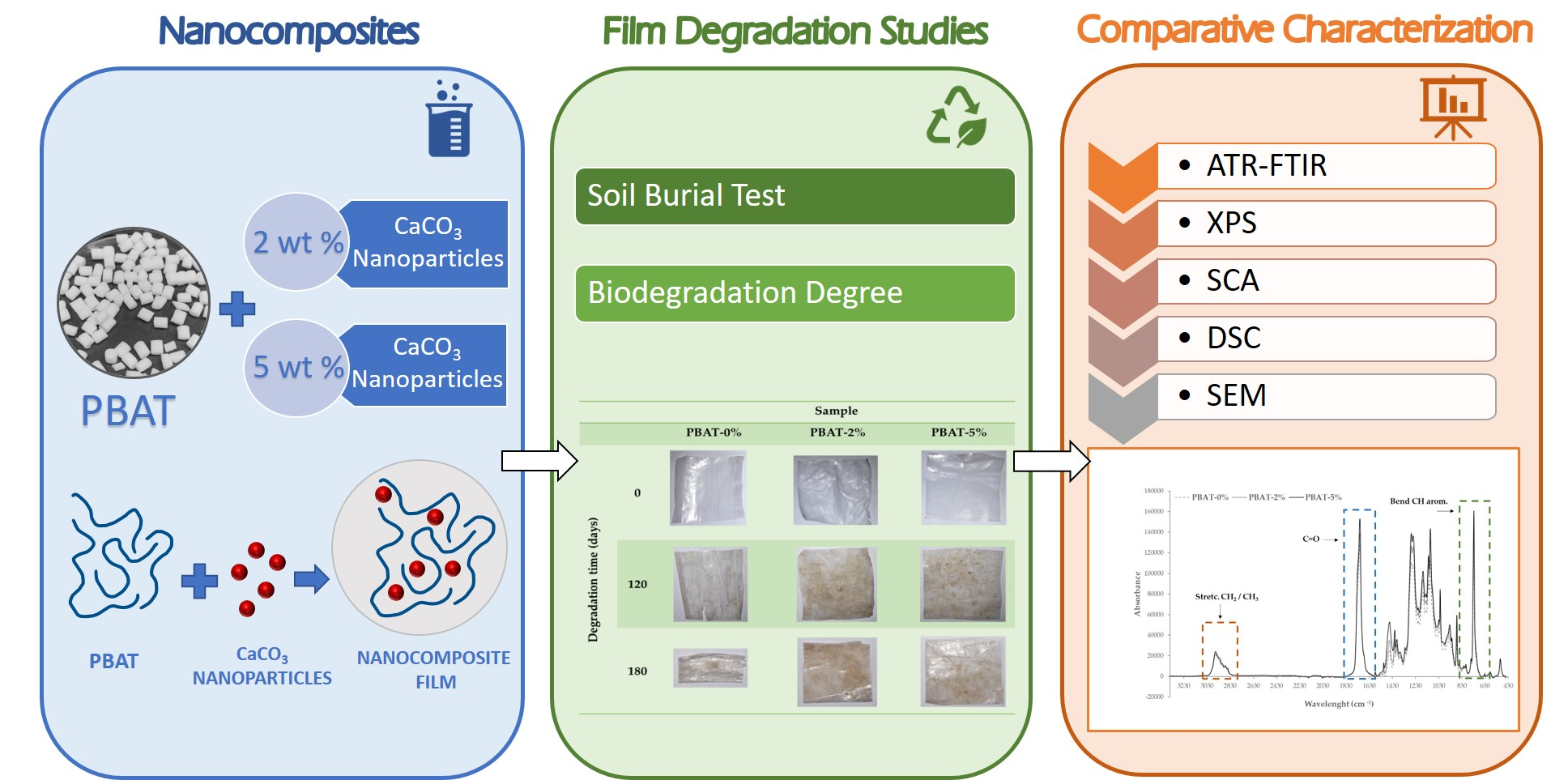
70) Recycled (Bio)Plastics and (Bio)Plastic Composites: A Trade Opportunity in a Green Future
E.Morici, S.Carroccio, E.Bruno, P.Scarfato, G.Filippone, N.Tz.Dintcheva
Polymers
14(10),
2038
- 2022
DOI:
https://doi.org/10.3390/polym14102038
Today’s world is at the point where almost everyone realizes the usefulness of going green. Due to so-called global warming, there is an urgent need to find solutions to help the Earth and move towards a green future. Many worldwide events are focusing on the global technologies in plastics, bioplastic production, the recycling industry, and waste management where the goal is to turn plastic waste into a trade opportunity among the industrialists and manufacturers. The present work aims to review the recycling process via analyzing the recycling of thermoplastic, thermoset polymers, biopolymers, and their complex composite systems, such as fiber-reinforced polymers and nanocomposites. Moreover, it will be highlighted how the frame of the waste management, increasing the materials specificity, cleanliness, and a low level of collected material contamination will increase the potential recycling of plastics and bioplastics-based materials. At the same time, to have a real and approachable trade opportunity in recycling, it needs to implement an integrated single market for secondary raw materials
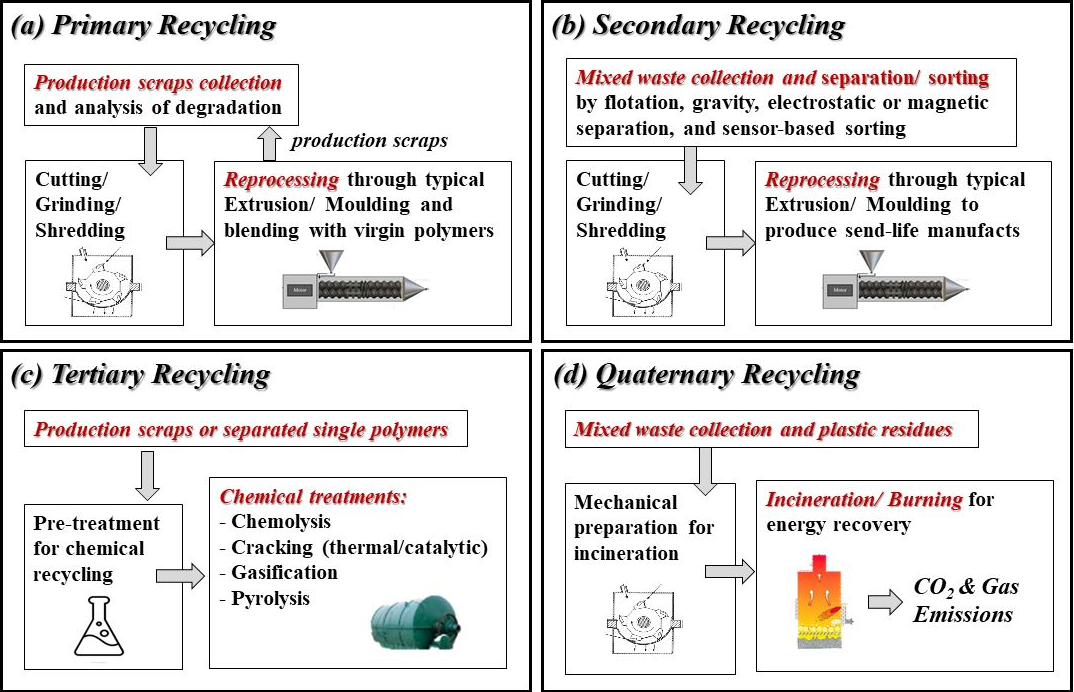
71) Sequencing Biodegradable and Potentially Biobased Polyesteramide of Sebacic Acid and 3-Amino-1-propanol by MALDI TOF-TOF Tandem Mass Spectrometry
P.Rizzarelli, S.La Carta, E.F.Mirabella, M.Rapisarda, G.Impallomeni
Polymers
14(8),
1500
- 2022
DOI:
https://doi.org/10.3390/polym14081500
Biodegradable and potentially biobased polyesteramide oligomers (PEA-Pro), obtained from melt condensation of sebacic acid and 3-amino-1-propanol, were characterized by nuclear magnetic resonance (NMR), matrix assisted laser desorption/ionization-time of flight/time of flight-mass spectrometry/mass spectrometry (MALDI-TOF/TOF-MS/MS), thermogravimetric analysis (TGA), and pyrolysis-gas chromatography/mass spectrometry (Py-GC/MS). NMR analysis showed the presence of hydroxyl and amino terminal groups as well as carboxylic groups of the sebacate moiety. Hydroxyl and carboxyl termination had the same abundance, while the amine termination was 2.7-times less frequent. Information regarding the fragmentation pathways and ester/amide bond sequences was obtained by MALDI-TOF/TOF-MS/MS analysis performed on sodiated adducts of cyclic species and linear oligomers. Different end groups did not influence the observed fragmentation. Three fragmentation pathways were recognized. The β-hydrogen-transfer rearrangement, which leads to the selective scission of the -O-CH2- bonds, was the main mechanism. Abundant product ions originating from -CH2-CH2- (β-γ) bond cleavage in the sebacate moiety and less abundant ions formed by -O-CO- cleavages were also detected. TGA showed a major weight loss (74%) at 381 °C and a second degradation step (22% weight loss) at 447 °C. Py-GC/MS performed in the temperature range of 350-400 °C displayed partial similarity between the degradation products and the main fragments detected in the MALDI-TOF/TOF-MS/MS experiments. Degradation products derived from amide bonds were related to the formation of CN groups, in agreement with the literature.
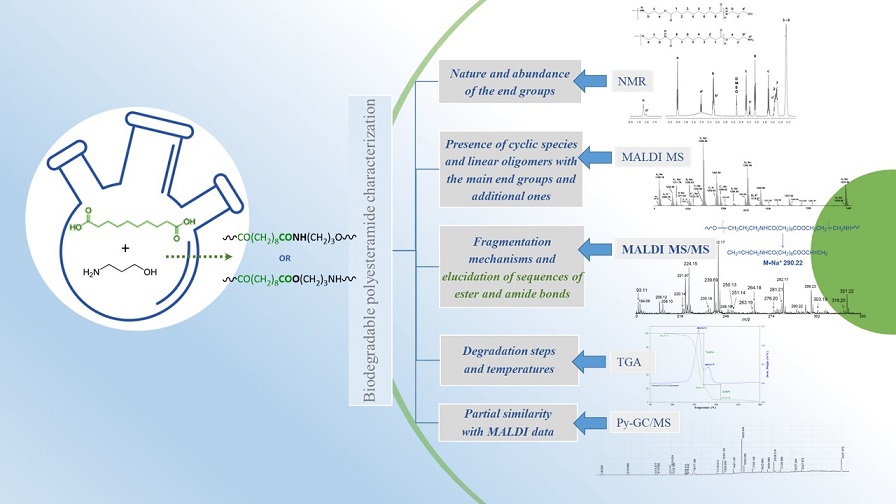
72) Superparamagnetic Iron Oxide Nanoparticle Nanodevices Based on Fe3O4 Coated by Megluminic Ligands for the Adsorption of Metal Anions from Water
S.Scurti, S.Dattilo, D.Gintsburg, L.Vigliotti, A.Winkler, S.Carroccio, D.Caretti
ACS Omega
- 2022
DOI:
https://doi.org/10.1021/acsomega.2c00558
The uptake ability toward arsenic(V), chromium(VI), and boron(III) ions of ad hoc functionalized magnetic nanostructured devices has been investigated. To this purpose, ligands based on meglumine have been synthesized and used to coat magnetite nanoparticles (Fe
3O
4) obtained by the co-precipitation methodology. The as-prepared hybrid material was characterized by infrared spectroscopy (IR), X-ray diffraction, thermogravimetric analysis, and scanning electron microscopy combined with energy-dispersive X-ray analysis. Moreover, its magnetic hysteresis properties were measured to evaluate its magnetic properties, and the adsorption kinetics and isothermal models were applied to discern between the different adsorption phenomena. Specifically, the better fitting was observed by the Langmuir isotherm model for all metal ions tested, highlighting a higher uptake in arsenic (28.2 mg/g), chromium (12.3 mg/g), and boron (23.7 mg/g) sorption values if compared with other magnetic nanostructured materials. After adsorption, an external magnetic stimulus can be used to efficiently remove nanomaterials from the water. Finally the nanomaterial can be reused up to five cycles and regenerated for another three cycles.
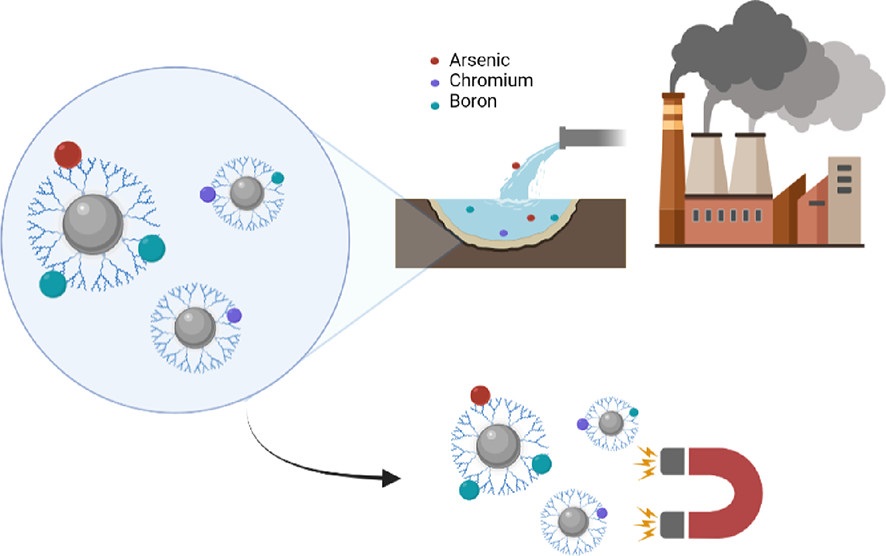
73) Spontaneous polymerization of benzofulvene derivatives bearing complexed or un-complexed pyridine rings
M.Paolino, M.Saletti, A.Reale, V.Razzano, G.Giuliani, A.Donati, C.Bonechi, G.Giorgi, A.Atrei, M.Mauro, A.Scamporrino, F.Samperi, E.Fois, G.Tabacchi, C.Botta, A.Cappelli
European Polymer Journal
169,
111137
- 2022
DOI:
https://doi.org/10.1016/j.eurpolymj.2022.111137
Benzofulvene derivatives bearing complexed and un-complexed pyridine rings are designed and synthesized to assess the effects on the spontaneous solid-state polymerization of the presence in position 6 of the 3-phenylbenzofulvene moiety of bulky substituents capable of establishing metallophilic interactions. Both the benzofulvene monomers are found to polymerize spontaneously upon solvent removal under reduced pressure in the apparent absence of catalysts or initiators. The resulting polybenzofulvene derivatives are characterized by NMR spectroscopy, MALDI-TOF mass spectrometry, and in photophysical studies.
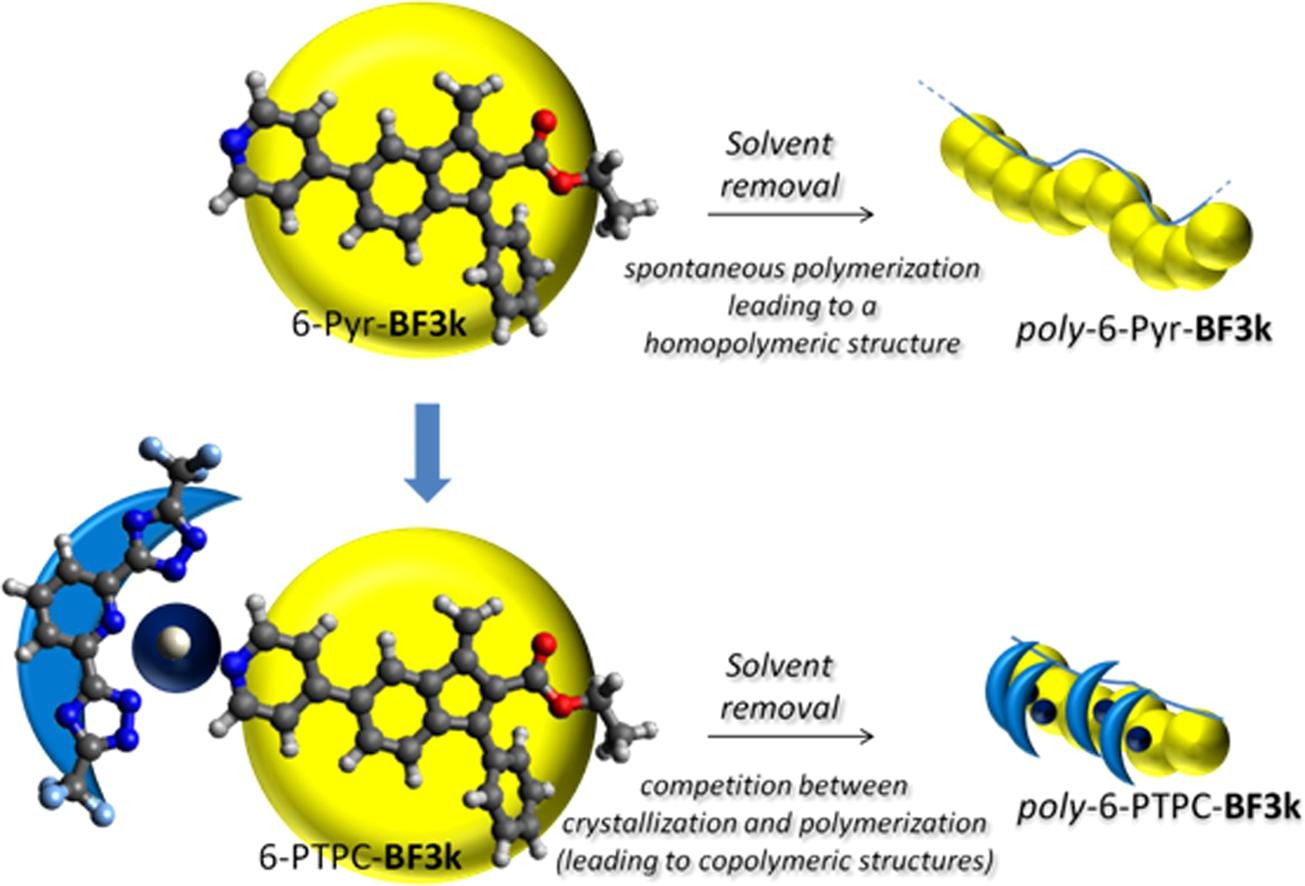
74) Carbazole-Pyridazine copolymers and their rhenium complexes: Effect of the molecular structure on the electronic properties
S.Zappia, L.Veronese, A.Fornic, S.Dattilo, F.Samperi, J.Dagare, T.M.Brown, M.Panigati, S.Destri
European Polymer Journal
168,
111095
- 2022
DOI:
https://doi.org/10.1016/j.eurpolymj.2022.111095
Two new push-pull copolymers, poly[
N-(9-heptadecanyl)carbazole-2,7-diyl-
alt-phthalazine- 5,8-diyl] (
P1) and poly[
N-(9-heptadecanyl)carbazole-2,7-diyl-
alt-thieno[3,4-d]pyridazine- 5,7-diyl]
(P2), were synthetized by means of a Suzuki polycondensation. The molecular characterization with
1H NMR and MALDI-MS showed enchainment defects in the polymer backbones depending on the synthetic conditions (catalyst and temperature). Both carbazole-carbazole and diazine-diazine homocoupling defects occurred, particularly in the case of
P2. For
P1, instead, almost homocoupling-free material was obtained. Exploiting the metal coordination capability of the pyridazine ring, corresponding dinuclear rhenium-based metallopolymers,
ReP1 and
ReP2, were also synthetized. All materials were investigated with experimental techniques (UV-vis spectroscopy, photoluminescence, cyclic voltammetry) and corroborated by theoretical studies (DFT and TD-DFT), including a qualitative evaluation of the effects of backbone defects on the electronic properties of the polymers. They were also tested in organic photovoltaic (OPV) devices. The wide energy gaps (E
g) accompanied with a low absorption coefficient for the band in the visible range reduced the harvesting capability of the copolymers. These drawbacks were partially overcome in the metallopolymers. The low device performance was mainly attributable to the low solubility of the metallopolymers in the organic solvents.
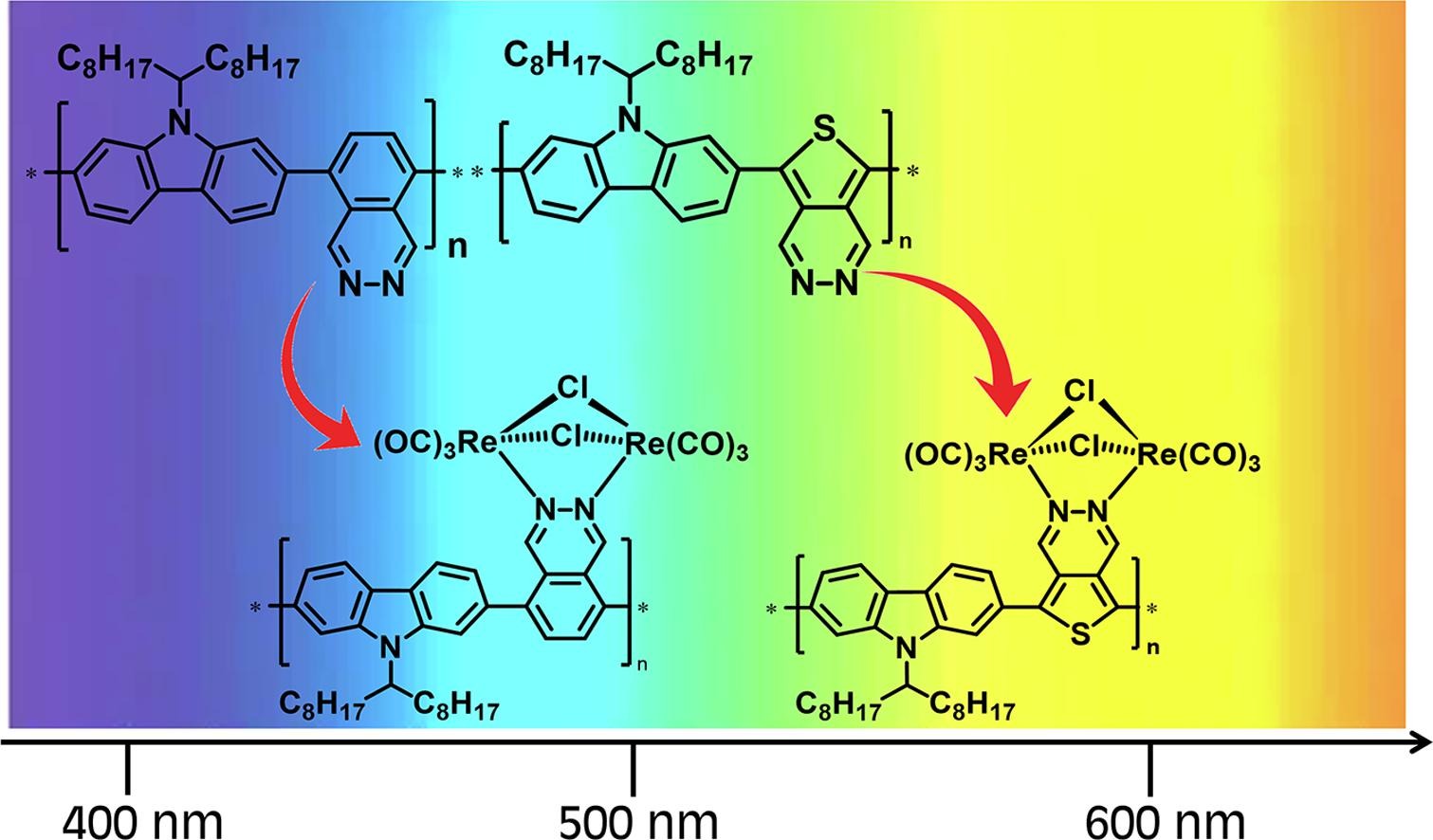
75) COG6-CDG: Novel variants and novel malformation
L.Cirnigliaro, P.Bianchi, L.Sturiale, D.Garozzo, G.Mangili, L.Keldermans, R.Rizzo, G.Matthijs, A.Fiumara, J.Jaeken, R.Barone
Birth Defects Research
114(5-6),
165-174
- 2022
DOI:
https://doi.org/10.1002/bdr2.1981
Background
Deficiency of Conserved Oligomeric Golgi (COG) subunits (COG1?8) is characterized by both N- and O-protein glycosylation defects associated with destabilization and mislocalization of Golgi glycosylation machinery components (COG-CDG). Patients with COG defects present with neurological and multisystem involvement and possible malformation occurrence. Eighteen patients with COG6-CDG (COG6 mutations) were reported to date. We describe a patient with COG6-CDG with novel variants and a novel clinical feature namely a congenital recto-vaginal fistula.
Methods
In-depth serum N- and O-glycosylation structural analyses were conducted by MALDI-TOF mass spectrometry. COG6 variants were identified by a gene panel and confirmed by Sanger sequencing.
Results
This female newborn presented with facial dysmorphism, distal arthrogryposis and recurrent stool discharges per vaginam. A double-contrast barium-enema X-ray study revealed a dehiscence (approximately 5 mm) at the anterior wall of the rectal ampoule communicating with the vagina consistent with a recto-vaginal fistula. She had developmental delay, corpus callosum dysgenesis, liver and gastrointestinal involvement, hyperthermia episodes and early demise. Serum N- and O-glycosylation analyses pointed to a profound Golgi disarrangement. We identified two novel variants in COG6: a deletion of 1 bp mutation c.823delA creating a shift in the reading frame and a premature stop codon and a 3 bp deletion (c.1141_1143delCTC) producing an in-frame deletion of 1 amino acid.
Conclusion
The congenital recto-vaginal fistula is a rare type of anorectal malformation that, to our knowledge, has not been reported in patients with a COG6 defect nor in patients with other COG defects. This study broadens COG6-CDG genetic landscape and spectrum of malformations.
76) Characterization of VOCs and additives in Italian PET bottles and studies on potential functional aldehydes scavengers
S.Dattilo, C.Gugliuzzo, E.F.Mirabella, C.Puglisi, A.Scamporrino, D.Zampino, F.Samperi
European Food Research and Technology
248
- 2022
DOI:
https://doi.org/10.1007/s00217-022-03973-5
This study focused on characterization of Volatile Organic Compounds (VOCs) as contaminants and non-volatile additives in Italian PET bottles, also suggesting potential functional aldehydes scavengers. Several VOCs, such as acetic aldehyde (AA), butanal, 3-methyl butanal, 1,3-dioxolane, pentanal, hexanal, octanal, 5-hepten-2-one, nonanal, and decanal, were identified by Head Space-Gas Chromatography/Mass Spectrometry (HS-GC/MS) in the PET bottles used for the packaging of six Italian brands mineral waters. AA, 1,3-dioxolane, octanal, 5-hepten-2-one, nonanal, and decanal were the most abundant compounds identified. These contaminants were also identified in the PET-bottled mineral waters. Different experiments using bottle-grade PET pellets (Btlg-PET) and PET bottles’ fragments with and without the addition of epoxidized soybean oil (ESBO) or erucamide as lubricant/plasticizer additives, poly(m-xylene adipamide) (MXD6), and/or anthranilamide (2-aminobenzamide) as potential aldehydes scavengers were carried out. Mostly VOCs observed in the PET bottles analysed were identified in a neat ESBO sample. The presence of the ESBO additive in the PET-bottle fragments was also observed by matrix-assisted laser desorption/ionization time of flight mass spectrometry analysis (MALDI?TOF MS). The ESBO sub-products were not observed in the virgin btlg-PET pellets analysed by both HS-GCρMS and MALDI?TOF MS. These results suggest that the VOCs come from an ESBO additive probably loaded during the blow-moulding processes used for the manufacturing of PET bottles. Further studies established that MXD6 (1%w), an efficient oxygen scavenger, could be also used as AA scavenger even in the presence of the commonly used anthranilamide.
77) Impact of nanoparticles on the environmental sustainability of polymer nanocomposites based on bioplastics or recycled plastics - A review of life-cycle assessment studies
S.Carroccio, P.Scarfato, E.Bruno, P.Aprea, N.TzDintcheva, G.Filippone
Journal of Cleaner Production
335,
130322
- 2022
DOI:
https://doi.org/10.1016/j.jclepro.2021.130322
Adding nanoparticles to a host polymer can lead to performance improvements that can be twice as beneficial to the environment: first, sustainable nanocomposites based on bioplastics or recycled plastics could replace ubiquitous petroleum-based polymers; second, substantial plastic saving could be achieved by profiting from the superior specific properties of the nanocomposites. Nevertheless, the inherent environmental burden of nanoparticles can compromise the expected benefits. Here we address the controversial issue of the environmental sustainability of "green" polymer nanocomposites based on bioplastics and recycled plastics. A critical review of life-cycle assessment studies regarding nanocomposites and their individual constituents is presented. Nanoparticles have a remarkable environmental impact despite their typically low content. Except for organo-clays and graphene, the production of common nanofillers (nanocellulose, titanium dioxide, silver and, above all, carbon nanotubes) emits relevant amounts of greenhouse gases and requires high energy, nullifying the advantages of using green polymer matrices. Reaching high performance becomes hence crucial to make polymer nanocomposites truly sustainable through material saving. For this purpose, increasing the content of nanoparticles or functionalizing them to enhance their dispersion in the host polymer can unexpectedly entail environmental benefits.
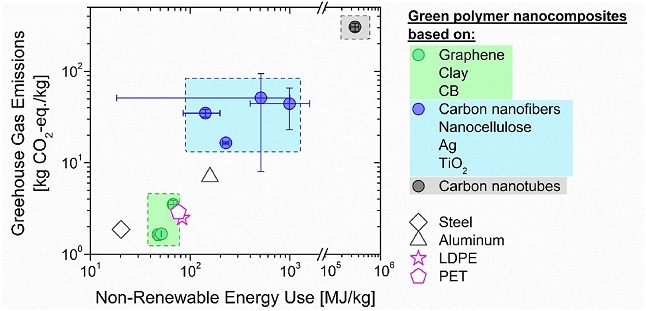
78) SLC35A2-CDG: Novel variant and review
D.Quelhas, J.Correia, J.Jaeken, L.Azevedo, M.Lopes-Marques, A.Bandeira, L.Keldermans, G.Matthijs, L.Sturiale. E.Martins
Molecular Genetics and Metabolism Reports
26,
100717
- 2021
DOI:
https://doi.org/10.1016/j.ymgmr.2021.100717
SLC35A2 encodes the X-linked transporter that carries uridine diphosphate (UDP)-galactose from the cytosol to the lumen of the Golgi apparatus and the endoplasmic reticulum. Pathogenic variants have been associated to a congenital disorder of glycosylation (CDG) with epileptic encephalopathy as a predominant feature. Among the sixty five patients described so far, a strong gender bias is observed as only seven patients are males. This work is a review and reports a SLC35A2-CDG in a male without epilepsy and with growth deficiency associated with decreased serum IGF1, minor neurological involvement, minor facial dysmorphism, and camptodactyly of fingers and toes. Sequence analysis revealed a hemizygosity for a novel de novo variant: c.233A > G (p.Lys78Arg) in SLC35A2. Further analysis of SLC35A2 sequence by comparing both orthologous and paralogous positions, revealed that not only the variant found in this study, but also most of the reported mutated positions are conserved in SLC35A2 orthologous, and many even in the paralogous SLC35A1 and SLC35A3. This is strong evidence that replacements at these positions will have a critical pathological effect and may also explain the gender bias observed among SLC35A2-CDG patients.
79) Smart nanocomposites of chitosan/alginate nanoparticles loaded with copper oxide as alternative nanofertilizers
M.Leonardi, G.M.Caruso, S.Carroccio, S.Boninelli, G.Curcuruto, M.Zimbone, M.Allegra, B.Torrisi, F.Ferlito, M.Miritello
Environmental Science: Nano
8(1),
174-187
- 2021
DOI:
https://doi.org/10.1039/D0EN00797H
In order to best nutrient use efficiency, as required by the increasing food demand for the future global population, in this work an innovative hybrid nanocomposite was designed as an alternative nanoscale fertilizer. An environmentally friendly chemical preparation based on polyelectrolyte complexation was used. A chitosan and sodium alginate complex was selected as a biodegradable shell to release the nanoscale nutrient, CuO nanoparticles. By optimizing the synthesis conditions,
i.e. pH and polymer/cross-linker ratio, good stability and accurate size control of the resulting nanocomposites were achieved. The morphology features were evaluated using scanning and transmission electron microscopy, and chemical characterization was performed using X-ray diffraction, thermogravimetric analysis, Fourier-transform infrared spectroscopy, dynamic light scattering and inductively coupled plasma optical emission spectrometry. All the collected data confirmed spontaneous polymeric aggregation in nanostructures of sperical shape, having a mean diameter of about 300 nm, as well as CuO encapsulation inside the polymeric coating. Moreover, the role of the biopolymer shell in the significant slowing of copper release from the hybrid nanocomposite was reported. Finally, the nanocomposite efficacy in seeding and germination was evaluated on
Fortunella margarita Swingle seeds. The tests demonstrated the benefits in the seedling growth together with a synergic effect in developing both the epigean and hypogean parts. The obtained results indicated that the proposed hybrid nanocomposite could be a potential alternative to realize a smart delivery nanofertilizer using an eco-sustainable method.
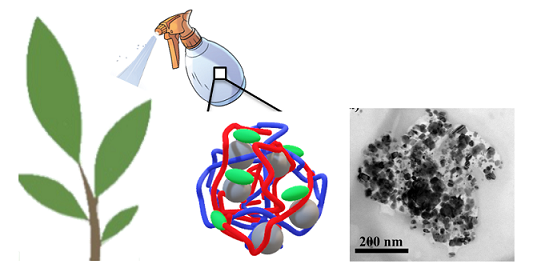
80) SLC37A4-CDG: Second patient
M.P.Wilson, D.Quelhas, E.Leão-Teles, L.Sturiale, D.Rymen, L.Keldermans, V.Race, E.Souche, E.Rodrigues, T.Campos, E.Van Schaftingen, F.Foulquier, D.Garozzo, G.Matthijs, J.Jaeken
JIMD Reports
58,
122-128
- 2021
DOI:
https://doi.org/10.1002/jmd2.12195
Recently, a disorder caused by the heterozygous de novo c.1267C>T (p.R423*) substitution in SLC37A4 has been described. This causes mislocalization of the glucose-6-phosphate transporter to the Golgi leading to a congenital disorder of glycosylation type II (SLC37A4-CDG). Only one patient has been reported showing liver disease that improved with age and mild dysmorphism. Here we report the second patient with a type II CDG caused by the same heterozygous de novo c.1267C>T (p.R423*) mutation thereby confirming the pathogenicity of this variant and expanding the clinical picture with type 1 diabetes, severe scoliosis, and membranoproliferative glomerulonephritis. Additional clinical and biochemical data provide further insight into the mechanism and prognosis of SLC37A4-CDG.
81) HILIC-UPLC-MS for high throughput and isomeric N-glycan separation and characterization in Congenital Disorders Glycosylation and human diseases
A.Messina, A.Palmigiano, F.Esposito, A.Fiumara, A.Bordugo, R.Barone, L.Sturiale, J.Jaeken, D.Garozzo
Glycoconjugate Journal
38(2),
201-211
- 2021
DOI:
https://doi.org/10.1007/s10719-020-09947-7
N-glycan analyses may serve uncovering disease-associated biomarkers, as well as for profiling distinctive changes supporting diagnosis of genetic disorders of glycan biosynthesis named congenital disorders of glycosylation (CDG). Strategies based on liquid chromatography (LC) preferentially coupled to electrospray ionization (ESI) - mass spectrometry (MS) have emerged as powerful analytical methods for N-glycan identification and characterization. To enhance detection sensitivity, glycans are commonly labelled with a functional tag prior to LC-MS analysis. Since most derivatization techniques are notoriously time-consuming, some commercial analytical kits have been developed to speed up N-deglycosylation and N-glycan labelling of glycoproteins of pharmaceutical and biological interest such as monoclonal antibodies (mAbs). We exploited the analytical capabilities of RapiFluor-MS (RFMS) to perform, by a slightly modified protocol, a detailed N-glycan characterization of total serum and single serum glycoproteins from specific patients with CDG (MAN1B1-CDG, ALG12-CDG, MOGS-CDG, TMEM199-CDG). This strategy, accomplished by Hydrophilic Interaction Chromatography (HILIC)-UPLC-ESI-MS separation of the RFMS derivatized N-glycans, allowed us to uncover structural details of patients serum released N-glycans, thus extending the current knowledge on glycan profiles in these individual glycosylation diseases. The applied methodology enabled to differentiate in some cases either structural isomers and isomers differing in the linkage type. All the here reported applications demonstrated that RFMS method, coupled to HILIC-UPLC-ESI-MS, represents a sensitive high throughput approach for serum N-glycome analysis and a valuable option for glycan detection and separation particularly for isomeric species.
82) Preparation, characterization, and antimicrobial activity of ferrocene-containing polymeric materials
D.Zampino, S.Pedotti, M.Ussia, S.Dattilo, M.Mancuso, R.Zaccone, A.Patti
Journal of Applied Polymer Science
- 2021
DOI:
https://doi.org/10.1002/app.49852
Ferrocenyl(benzyl) imidazole (FcIm) and two related methyl-imidazolium salts (FcMIm+I- and FcMIm+PF6-) were synthesized for their incorporation into plasticized PVC by solvent casting technique. The obtained materials were investigated for their thermal stability and, compared to pure polymer, films containing ionic ferrocene derivatives in 0.5% w/w loading were found slightly more stable. The pure ferrocene compounds showed antibacterial activity against Staphylococcus epidermis, but not against Escherichia coli, with a maximum for FcMIm+PF6- salt. After incorporation into PVC polymer, antibacterial activity against S. epidermis was observed (by disk diffusion test) only for PVC/FcMIm+PF6- (5% w/w) film, from which a release of 14.6% of the ferrocenilimidazolium cation in aqueous medium was measured after 24 hr.
83) Pollen viability and endophytic yeast species of Cistus creticus and C. monspeliensis
D.Zampino, A.Duro, S.Sciandrello, L.Parafati, C.Restuccia
Plant Biosystems - An International Journal Dealing with all Aspects of Plant Biology
- 2021
DOI:
https://doi.org/10.1080/11263504.2020.1753844
Cistus species are widespread in the Mediterranean basin, especially in places characterized by high temperatures and arid soils. Despite a rich literature concerning the biological and pharmacological properties of Cistus species, to our knowledge, there are only few reports on pollen viability and little is known about microbial endophytes within pollen grains. Pollen viability and germination of Cistus creticus L. and C. monspeliensis L., from two sites of Sicily (Italy) over two years (2016-2017), were determined by 2,3,5 triphenyl-tetrazolium chloride (TTC) staining and an in vitro germination test. Dominant microorganisms, flowing from pollen openings (colpora), were identified by molecular methods. Furthermore, for comparison, in 2017 microbial endophytes of C. eriocephalus Viv. from Serra S. Bruno (Calabria, Italy) were studied. The optimal medium composition for rapid in vitro germination was determined. Pollen viability was in the range of 79.8-90.0% for C. monspeliensis and 86.6-91.6% for C. creticus, while germination was 56.5?62.4% for C. monspeliensis and 50.1?58.8 for C. creticus. Statistical analysis by correlation coefficient showed a significant relationship between viability and germination, whereas significant differences (P<0.05) were observed between TTC staining and the in vitro germination test. Yeasts were the dominant microorganisms in all pollen samples and dominant species were identified.
84) Additive Manufacturing Processing of Plastics for Mass Production of Composites Tooling: Technical and Economic Analysis
G.Cicala, C.Tosto, G.Recca, A.Patti
Macromolecular Symposia
395(1),
2000256
- 2021
DOI:
https://doi.org/10.1002/masy.202000256
The present paper focuses on the use of several additive manufacturing (AM) techniques for tooling manufacturing for composite parts production. A geometry that prevents mandrel removal is selected and it is analyzed in a real industrial environment for composites production using autoclave molding. The use of two different AM mandrels is evaluated: fused deposition modeling and liquid crystal display. The results are analyzed in terms of composites part quality, processing time and final part cost.
85) Kinetic Study of the Thermal Dehydration of Fly Ash Filled Geopolymers
I.Blanco, G.Cicala, C.Tosto, G.Recca, G.Dal Poggetto, M.Catauro
Macromolecular Symposia
395(1),
2000225
- 2021
DOI:
https://doi.org/10.1002/masy.202000225
Metakaolin-based geopolymers at different percentage of fly ash (namely 25, 50, and 70% wt) are prepared by using recycled fly ash, aiming at reducing the amount of waste to be treated or disposed in landfills. The synthesized samples are subjected to the thermogravimetric analysis (TGA) to investigate the kinetics of dehydration process. To this purpose, TGA data are treated by the Kissinger method to calculate the apparent activation energy (Ea) of dehydration. The obtained kinetics parameters are discussed and compared with each other and with those obtained for the control geopolymer. A decrease in Ea values of the filled geopolymers is found, showing the effect of the fly ash in reducing the dehydration rate. A classification among the samples at different percentage of fly ash is also drawn up, showing the reaching of a plateau at percentage above the 50 wt%.
86) Extraction and characterisation of bioactive proteins from Pongamia pinnata and their conversion into bioproducts for food packaging applications
D.Nataraj, V.Guna, P.Battampara, N.G.Shivashankara, P.Rizzarelli, N.Reddy
Journal of Bioactive and Compatible Polymers
- 2021
DOI:
https://doi.org/10.1177/08839115211043280
In this research, proteins were obtained from Pongamia pinnata oil meal and subsequently converted into films and compression molded into various packaging products. Films with a maximum tensile strength of 1.9 MPa were obtained when 15% citric acid was used as the crosslinker. Minimum swelling of 120% was seen in 20% citric acid crosslinked film whereas the uncrosslinked films readily disintegrated in water. The protein films had excellent antioxidant properties with an IC50 value of 14.6 μg/ml compared to 26.9 μg/ml for the standard ascorbic acid. The pongamia protein-based bioproducts showed good activity against Bacillus cereus and Aspergillus niger. Unique properties, low cost, and large availability make pongamia proteins an ideal biopolymer for the development of green and sustainable materials and bioproducts.
87) Clinical and radiological correlates of activities of daily living in cerebellar atrophy caused by PMM2 mutations (PMM2-CDG)
F.Pettinato, G.Mostile, R.Battini, D.Martinelli, A.Madeo, E.Biamino, D.Frattini, D.Garozzo, S.Gasperini, R.Parini, F.Sirchia, G.Sortino, L.Sturiale, G.Matthijs, A.Morrone, M.Di Rocco, R.Rizzo, J.Jaeken, A.Fiumara, R.Barone
Cerebellum
20(4),
596-605
- 2021
DOI:
https://www.doi.org/10.1007/s12311-021-01242-x
We aimed to identify clinical, molecular and radiological correlates of activities of daily living (ADL) in patients with cerebellar atrophy caused by PMM2 mutations (PMM2-CDG), the most frequent congenital disorder of glycosylation. Twenty-six PMM2-CDG patients (12 males; mean age 13 ± 11.1 years) underwent a standardized assessment to measure ADL, ataxia (brief ataxia rating scale, BARS) and phenotype severity (Nijmegen CDG rating scale, NCRS). MRI biometry of the cerebellum and the brainstem were performed in 23 patients (11 males; aged 5 months-18 years) and 19 control subjects with equal gender and age distributions. The average total ADL score was 15.3 ± 8.5 (range 3-32 out of 36 indicating severe functional disability), representing variable functional outcome in PMM2-CDG patients. Total ADL scores were significantly correlated with NCRS (r2 = 0.55, p < 0.001) and BARS scores (r2 = 0.764; p < 0.001). Severe intellectual disability, peripheral neuropathy, and severe PMM2 variants were all significantly associated with worse functional outcome. Higher ADL scores were significantly associated with decreased diameters of cerebellar vermis (r2 = 0.347; p = 0.004), hemispheres (r2 = 0.436; p = 0.005), and brainstem, particularly the mid-pons (r2 = 0.64; p < 0.001) representing the major radiological predictor of functional disability score in multivariate regression analysis. We show that cerebellar syndrome severity, cognitive level, peripheral neuropathy, and genotype correlate with ADL used to quantify disease-related deficits in PMM2-CDG. Brainstem involvement should be regarded among functional outcome predictors in patients with cerebellar atrophy caused by PMM2-CDG.
88) EVA Films Loaded with Layered Double Hydroxide (LDH) Modified with Methacrylic Anion: Effect of the Nanohybrid Filler on the Photodegradation Phenomena
G.Gorrasi, G.Viscusi, G.Curcuruto, M.Cantarella, A.Di Mauro, P.Bernardo, G.Clarizia, A.Scamporrino, S.Carroccio
Polymers
13(15),
2525
- 2021
DOI:
https://doi.org/10.3390/polym13152525
The photo-oxidative studies of ethylene vinyl acetate copolymer (EVA) matrix, filled with Layered Double Hydroxide (LDH) modified with methacrylic anion (MA), were herein reported, together with gas permeation tests. The formulation of nano-hybrid LDHs was characterized using X-ray diffractometry (XRD) and thermogravimetric analysis (TGA), demonstrating the partial intercalation of the 30% of MA anion between the LDH’s galleries. The as-modified filler was introduced into an EVA matrix by mechanical milling, producing free-standing films subjected to accelerated aging. Fourier transform infrared spectroscopy (FT-IR) results suggested that the nanohybrid presence determined a stabilizing effect up to 45 days of UV irradiation, especially if compared to the EVA/LDH references for all formulated EVA hybrid nanocomposites. Conversely, the presence of nanohybrid in the matrix did not significantly change the thermal stability of EVA samples. The dispersion of modified MA-LDH in the EVA matrix produces defect-free samples in the whole range of investigated loadings. The samples show a slight decrease in gas permeability, coupled with a substantial stabilization of the original CO
2/O
2 selectivity, which also proves the integrity of the films after 30 days of UV irradiation.
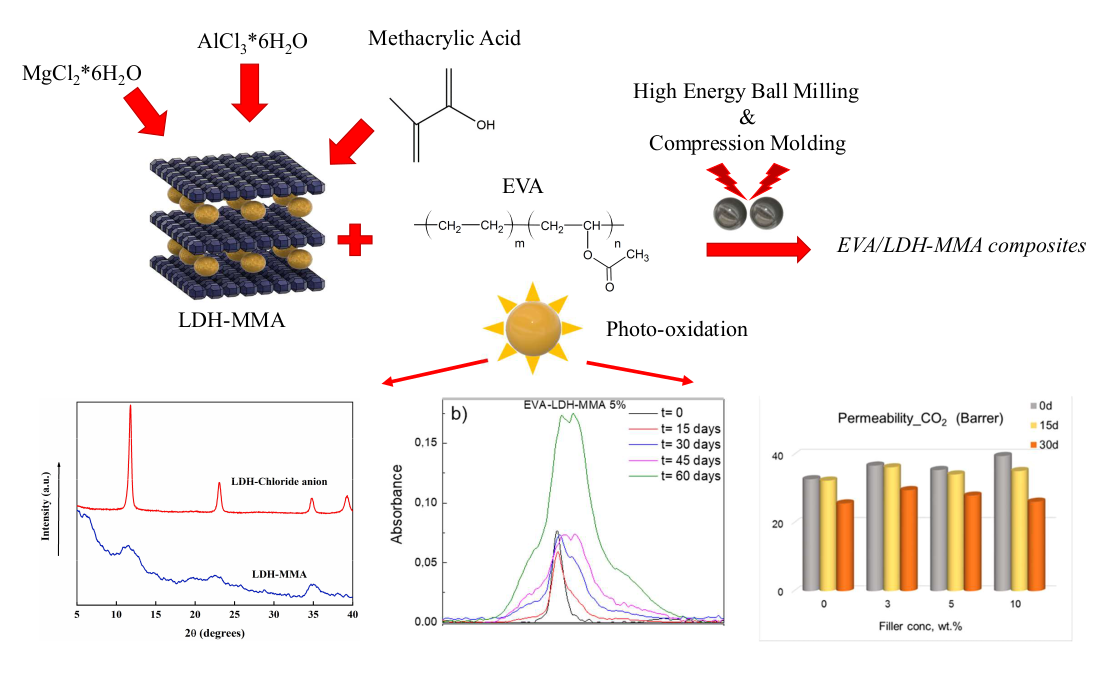
89) N-Glycomics of Human Erythrocytes
R.O.Bua, A.Messina, L.Sturiale, R.Barone, D.Garozzo, A.Palmigiano
International Journal of Molecular Sciences
22(15),
8063
- 2021
DOI:
https://doi.org/10.3390/ijms22158063
Glycosylation is a complex post-translational modification that conveys functional diversity to glycoconjugates. Cell surface glycosylation mediates several biological activities such as induction of the intracellular signaling pathway and pathogen recognition. Red blood cell (RBC) membrane N-glycans determine blood type and influence cell lifespan. Although several proteomic studies have been carried out, the glycosylation of RBC membrane proteins has not been systematically investigated. This work aims at exploring the human RBC N-glycome by high-sensitivity MALDI-MS techniques to outline a fingerprint of RBC N-glycans. To this purpose, the MALDI-TOF spectra of healthy subjects harboring different blood groups were acquired. Results showed the predominant occurrence of neutral and sialylated complex N-glycans with bisected N-acetylglucosamine and core- and/or antennary fucosylation. In the higher mass region, these species presented with multiple N-acetyllactosamine repeating units. Amongst the detected glycoforms, the presence of glycans bearing ABO(H) antigens allowed us to define a distinctive spectrum for each blood group. For the first time, advanced glycomic techniques have been applied to a comprehensive exploration of human RBC N-glycosylation, providing a new tool for the early detection of distinct glycome changes associated with disease conditions as well as for understanding the molecular recognition of pathogens.
90) Clinical, molecular and glycophenotype insights in SLC39A8-CDG
E.Bonaventura, R.Barone, L.Sturiale, R.Pasquariello, M.G.Alessandrì, A.M.Pinto, A.Renieri, C.Panteghini, B.Garavaglia, G.Cioni, R.Battini
Orphanet Journal of Rare Diseases
16(1),
307
- 2021
DOI:
https://www.doi.org/10.1186/s13023-021-01941-y
Background
SLC39A8, a gene located on chromosome 4q24, encodes for the manganese (Mn) transporter ZIP8 and its detrimental variants cause a type 2 congenital disorder of glycosylation (CDG). The common SLC39A8 missense variant A391T is associated with increased risk for multiple neurological and systemic disorders and with decreased serum Mn. Patients with SLC39A8-CDG present with different clinical and neuroradiological features linked to variable transferrin glycosylation profile. Galactose and Mn supplementation therapy results in the biochemical and clinical amelioration of treated patients.
Results
Here, we report clinical manifestations, neuroradiological features and glycophenotypes associated with novel SLC39A8 variants (c.1048G > A; p.Gly350Arg and c.131C > G; p.Ser44Trp) in two siblings of the same Italian family. Furthermore, we describe a third patient with overlapping clinical features harbouring the homozygous missense variant A391T. The clinical phenotype of the three patients was characterized by severe developmental disability, dystonic postural pattern and dyskinesia with a more severe progression of the disease in the two affected siblings. Neuroimaging showed a Leigh syndrome-like pattern involving the basal ganglia, thalami and white matter. In the two siblings, atrophic cerebral and cerebellum changes consistent with SLC39A8-CDG were detected as well. Serum transferrin isoelectric focusing (IEF) yielded variable results with slight increase of trisialotransferrin isoforms or even normal pattern. MALDI-MS showed the presence of hypogalactosylated transferrin N-glycans, spontaneously decreasing during the disease course, only in one affected sibling. Total serum N-glycome depicted a distinct pattern for the three patients, with increased levels of undergalactosylated and undersialylated precursors of fully sialylated biantennary glycans, including the monosialo-monogalacto-biantennary species A2G1S1.
Conclusions
Clinical, MRI and glycosylation features of patients are consistent with SLC39A8-CDG. We document two novel variants associated with Leigh syndrome-like disease presentation of SLC39A8-CDG. We show, for the first time, a severe neurological phenotype overlapping with that described for SLC39A8-CDG in association with the homozygous A391T missense variant. We observed a spontaneous amelioration of transferrin N-glycome, highlighting the efficacy of MS-based serum glycomics as auxiliary tool for the diagnosis and clinical management of therapy response in patients with SLC39A8-CDG. Further studies are needed to analyse more in depth the influence of SLC39A8 variants, including the common missense variant, on the expression and function of ZIP8 protein, and their impact on clinical, biochemical and neuroradiological features.
91) Properties and Applications of Nanoparticles from Plant Proteins
N.Reddy, M.Rapisarda
Materials
14(13),
3607
- 2021
DOI:
https://doi.org/10.3390/ma14133607
Nanoparticles from plant proteins are preferred over carbohydrates and synthetic polymeric-based materials for food, medical and other applications. In addition to their large availability and relatively low cost, plant proteins offer higher possibilities for surface modifications and functionalizing various biomolecules for specific applications. Plant proteins also avoid the immunogenic responses associated with the use of animal proteins. However, the sources of plant proteins are very diverse, and proteins from each source have distinct structures, properties and processing requirements. While proteins from corn (zein) and wheat (gliadin) are soluble in aqueous ethanol, most other plant proteins are insoluble in aqueous conditions. Apart from zein and gliadin nanoparticles (which are relatively easy to prepare), soy proteins, wheat glutenin and proteins from several legumes have been made into nanoparticles. The extraction of soluble proteins, hydrolyzing with alkali and acids, conjugation with other biopolymers, and newer techniques such as microfluidization and electrospraying have been adopted to develop plant protein nanoparticles. Solid, hollow, and core-shell nanoparticles with varying sizes and physical and chemical properties have been developed. Most plant protein nanoparticles have been used as carriers for drugs and as biomolecules for controlled release applications and for stabilizing food emulsions. This review provides an overview of the approaches used to prepare nanoparticles from plant proteins, and their properties and potential applications. The review’s specific focus is on the preparation methods and applications, rather than the properties of the proteins, which have been reported in detail in other publications.
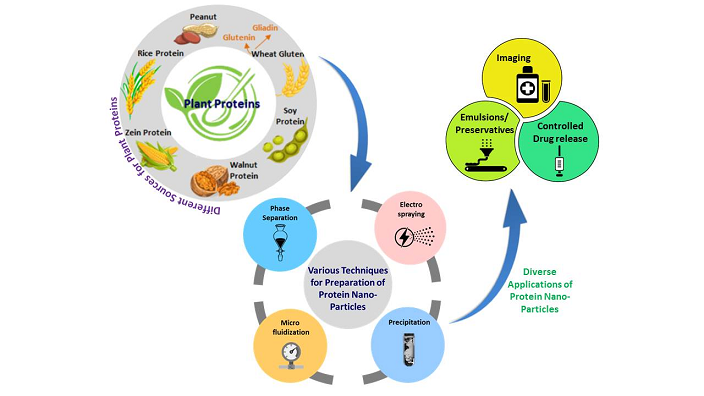
92) Synthesis and UV-light induced oligomerization of a benzofulvene-based neutral platinum(II) complex
M.Paolino, A.Reale, G.Magrini, V.Razzano, M.Saletti, G.Giuliani, A.Donati, F.Samperi, A.Scamporrino, M.Canetti, M.Mauro, F.Villafiorita-Monteleone, E.Foise, C.Botta, A.Cappelli
European Polymer Journal
165,
110597
- 2021
DOI:
https://doi.org/10.1016/j.eurpolymj.2021.110597
Neutral platinum(II) complex 2-PTPC-
BF3a was easily prepared from benzofulvene derivative 2-Pyr-
BF3a in order to evaluate the effects in the aggregation/polymerization behavior of a bulky substituent capable of establishing intermolecular metal-metal interactions in the close proximity of the putative polymerization center. Complex 2-PTPC-
BF3a was found to aggregate into an ordered crystalline solid-state without significant spontaneous polymerization, but the UV-light irradiation of its dispersions in chloroform produced corresponding oligomers, which were characterized by NMR spectroscopy and MALDI-TOF mass spectrometry. On the other hand, the UV-irradiation of the platinum complex in the solid-state produced different results probably depending on the aggregate architecture. Notably, the crystalline films deposited from THF solutions on quartz substrates showed weak emissions, which progressively increased upon irradiation with the formation of oligomers devoid of the aggregation-induced quenching sites that seemed to affect the emission of poly-2-PTPC-
BF3a. Finally, DFT calculations were performed on platinum complex 2-PTPC-
BF3a in the aim of rationalizing the observed photophysical features.
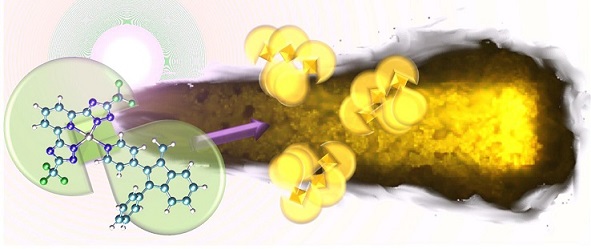
93) Influence of photo-oxidation on the performance and soil degradation of oxo- and biodegradable polymer-based items for agricultural applications
P.Rizzarelli, M.Rapisarda, L.Ascione, F.Degli Innocenti, F.P.La Mantia
Polymer Degradation and Stability
188
- 2021
DOI:
https://doi.org/10.1016/j.polymdegradstab.2021.109578
The examination of the aging behavior of polymers, blends, composites, items, etc. under different environmental conditions is a priority issue for assessing the possible applications and establishing the lifetime. In agriculture, plastic items (mulch films, irrigation tubes, etc.) are widely used and subjected to solar UV exposure that can induce photo-oxidation on macromolecular chains. Therefore, weathering under outdoor conditions and accelerated degradation tests are performed for simulating aging processes during the lifetime of materials and select appropriate stabilizers to be used. In the last decades, oxo- and biodegradable polymers have been investigated and used in agricultural items. The influence of photooxidation or outdoor weathering on their structures, performance and biodegradation behavior in soil has been evaluated. This review aims to provide an overview of the studies focused on the effects of photo-degradation processes on chemical-physical properties and degradation in soil of oxo- and biodegradable polymers or items designed for agricultural purpose, including an outline of the available standards. Additionally, a comparison between the behaviors induced by photo-oxidation of the two different families of degradable polymers used in agricultural plastic items is carried out.
94) Lipopolysaccharide from Gut-Associated Lymphoid-Tissue-Resident Alcaligenes faecalis: Complete Structure Determination and Chemical Synthesis of Its Lipid A
A.Shimoyama, F.Di Lorenzo, H.Yamaura, K.Mizote, A.Palmigiano, M.Pither, I.Speciale, T.Uto, S.Masui, L.Sturiale, D.Garozzo, K.Hosomi, N.Shibata, K.Kabayama, Y.Fujimoto, A.Silipo, J.Kunisawa, H.Kiyono, A.Molinaro, K.Fukase
Angewandte Chemie
60(18),
10023-10031
- 2021
DOI:
https://doi.org/10.1002/ange.202012374
Alcaligenes faecalis is the predominant Gram-negative bacterium inhabiting gut-associated lymphoid tissues, Peyer’s patches. We previously reported that an
A. faecalis lipopolysaccharide (LPS) acted as a weak agonist for Toll-like receptor 4 (TLR4)/myeloid differentiation factor-2 (MD-2) receptor as well as a potent inducer of IgA without excessive inflammation, thus suggesting that
A. faecalis LPS might be used as a safe adjuvant. In this study, we characterized the structure of both the lipooligosaccharide (LOS) and LPS from
A. faecalis. We synthesized three lipid A molecules with different degrees of acylation by an efficient route involving the simultaneous introduction of 1- and 4’-phosphates. Hexaacylated
A. faecalis lipid A showed moderate agonistic activity towards TLR4-mediated signaling and the ability to elicit a discrete interleukin-6 release in human cell lines and mice. It was thus found to be the active principle of the LOS/LPS and a promising vaccine adjuvant candidate.

95) Mass spectrometry glycophenotype characterization of ALG2-CDG in Argentinean patients with a new genetic variant in homozygosis
G.Magali Papazoglu, M.Cubilla, M.Pereyra, R.Dodelson de Kremer, B.Pérez, L.Sturiale, C.G.Asteggiano
Glycoconjugate Journal
38,
191-200
- 2021
DOI:
https://doi.org/10.1007/s10719-021-09976-w
Human ALG2 encodes an α 1,3mannosyltransferase that catalyzes the first steps in the synthesis of N-glycans in the endoplasmic reticulum. Variants in ALG2 cause a congenital disorder of glycosylation (CDG) known as ALG2-CDG. Up to date, nine ALG2-CDG patients have been reported worldwide. ALG2-CDG is a rare autosomal recessive inherited disorder characterized by neurological involvement, convulsive syndrome of unknown origin, axial hypotonia, and mental and motor regression. In this study, we used MALDI-TOF MS to define both total serum protein and transferrin (Tf) N-glycan phenotypes in three ALG2-CDG patients carrying a c.752G > T, p.Arg251Leu ALG2 missense variant in homozygous state, as determined by exome sequencing. Comparing it to control samples, we have observed Tf under-occupancy of glycosylation site(s) typical of a defective N-glycan assembly and the occurrence of oligomannose and hybrid type N-glycans. Moreover, we have observed a slight oligomannose accumulation in total serum glyco-profiles. The increased heterogeneity of serum N-glycome in the studied patients suggests a marginal disarrangement of the glycan processing in ALG2-CDG. Previous studies reported on slightly increased concentrations of abnormal serum N-glycans in CDG-I due to defects in the mannosylation steps of dolichol-linked oligosaccharide biosynthesis. This preliminary work aims at considering serum N-glycan accumulation of high mannosylated glycoforms, such as oligomannose and hybrid type N-glycans, as potential diagnostic signals for ALG2-CDG patients.
96) Innovative Polymeric Hybrid Nanocomposites for Application in Photocatalysis
M.Cantarella, G.Impellizzeri, A.Di Mauro, V.Privitera, S.Carroccio
Polymers
13(8),
1184
- 2021
DOI:
https://doi.org/10.3390/polym13081184
The immobilization of inorganic nanomaterials on polymeric substrates has been drawing a lot of attention in recent years owing to the extraordinary properties of the as-obtained materials. The hybrid materials, indeed, combine the benefits of the plastic matter such as flexibility, low-cost, mechanical stability and high durability, with them deriving from their inorganic counterparts. In particular, if the inorganic fillers are nanostructured photocatalysts, the originated hybrid systems will be able to utilize the energy delivered by light, catalysing chemical reactions in a sustainable pathway. Most importantly, since the nanofillers can be ad-hoc anchored to the macromolecular structure, their release in the environment will be prevented, thus overcoming one of the main restrictions that impedes their applications on a large scale. In this review, several typologies of hybrid photocatalytic nanomaterials, obtained by using both organic and inorganic semiconductors and realized with different synthetic protocols, were reported and discussed. In the first part of the manuscript, nanocomposites realized by simply blending the TiO
2 or ZnO nanomaterials in thermoplastic polymeric matrices are illustrated. Subsequently, the atomic layer deposition (ALD) technique is presented as an excellent method to formulate polymeric nanocomposites. Successively, some examples of polyporphyrins hybrid systems containing graphene, acting as photocatalysts under visible light irradiation, are discussed. Lastly, photocatalytic polymeric nanosponges, with extraordinary adsorption properties, are shown. All the described materials were deeply characterized and their photocatalytic abilities were evaluated by the degradation of several organic water pollutants such as dyes, phenol, pesticides, drugs, and personal care products. The antibacterial performance was also evaluated for selected systems. The relevance of the obtained results is widely overviewed, opening the route for the application of such multifunctional photocatalytic hybrid materials in wastewater remediation.
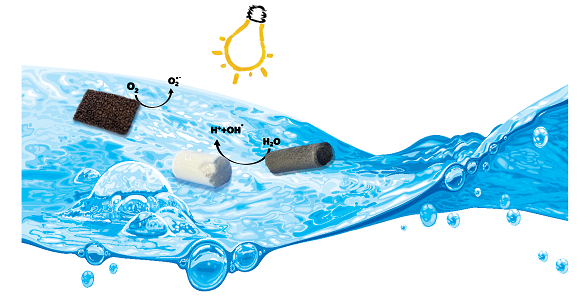
97) Aberrant sialylation in a patient with a HNF1α variant and liver adenomatosis
L.Sturiale, M.C.Nassogne, A.Palmigiano, A.Messina, I.Speciale, R.Artuso, G.Bertino, N.Revencu, X.Stephénne, C.De Castro, G.Matthijs, R.Barone, J.Jaeken, D.Garozzo
iScience
24(4),
102323
- 2021
DOI:
https://doi.org/10.1016/j.isci.2021.102323
Glycosylation is a fundamental post-translational modification of proteins that boosts their structural diversity providing subtle and specialized biological properties and functions. All those genetic diseases due to a defective glycan biosynthesis and attachment to the nascent glycoproteins fall within the wide area of congenital disorders of glycosylation (CDG), mostly causing multisystem involvement. In the present paper, we detailed the unique serum N-glycosylation of a CDG-candidate patient with an unexplained neurological phenotype and liver adenomatosis harboring a recurrent pathogenic
HNF1α variant. Serum transferrin isoelectric focusing showed a surprising N-glycosylation pattern consisting on hyposialylation, as well as remarkable hypersialylation. Mass spectrometry-based glycomic analyses of individual serum glycoproteins enabled to unveil hypersialylated complex N-glycans comprising up to two sialic acids per antenna. Further advanced MS analysis showed the additional sialic acid is bonded through an α2-6 linkage to the peripheral N-acetylglucosamine residue.
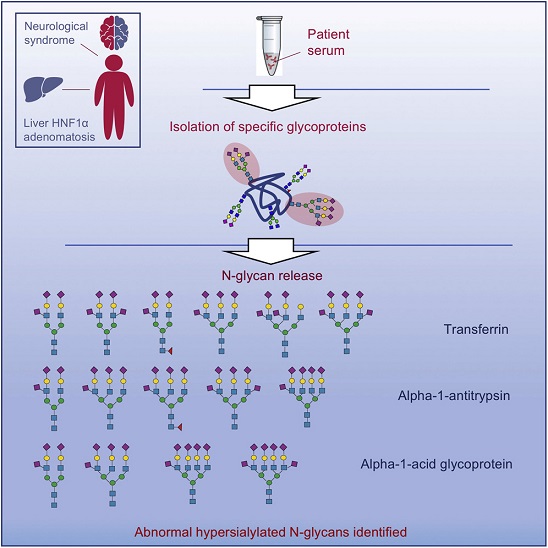
98) Mechanical, Wear and Thermal Behavior of Polyethylene Blended with Graphite Treated in Ball Milling
A.Visco, A.Grasso, G.Recca, D.Carbone, A.Pistone
Polymers
13(6),
975
- 2021
DOI:
https://doi.org/10.3390/polym13060975
Additive manufacturing, civil, and biomechanical applications are among the most important sectors, where the filler’s presence can significantly improve the quality of polymeric products blends. The high market demand of new low-cost material to be used as shock absorbers and mechanical joints arouses our curiosity to study a relatively common commercial polymer and filler. The possible improvement by blending high-density polyethylene (HDPE) and graphite was investigated for these sectors. To achieve this objective, we have prepared HDPE/graphite nanocomposites following mechanical treatment to understand which parameter provides the researched properties. As widely reported in the literature, milling treatment leads to the decrease of the particle size and the exfoliation of graphitic layers. Therefore, graphite has been previously treated with a ball mill for different times (1-16 h) to enhance its lubricating action. We checked an improvement in stiffness, yielding strength, thermal stability, and, in particularly, wear resistance that increased by 65% with respect to that of polyethylene (PE). A treatment time of eight hours in ball milling could be enough to give an appreciable improvement. The wear behavior of HDPE with treated graphite has not been deeply investigated so far, and it could be important because HDPE is considered a "carrier polymer" for different low-friction applications.
99) Mechanical Properties of Protective Coatings against Marine Fouling: A Review
A.Pistone, C.Scolaro, A.Visco
Polymers
13(2),
173
- 2021
DOI:
https://doi.org/10.3390/polym13020173
The accumulation of marine organisms on ship hulls, such as microorganisms, barnacles, and seaweeds, represents a global problem for maritime industries, with both economic and environmental costs. The use of biocide-containing paints poses a serious threat to marine ecosystems, affecting both target and non-target organisms driving science and technology towards non-biocidal solutions based on physico-chemical and materials properties of coatings. The review reports recent development of hydrophobic protective coatings in terms of mechanical properties, correlated with the wet ability features. The attention is focused mainly on coatings based on siloxane and epoxy resin due to the wide application fields of such systems in the marine industry. Polyurethane and other systems have been considered as well. These coatings for anti-fouling applications needs to be both long-term mechanically stable, perfectly adherent with the metallic/composite substrate, and capable to detach/destroy the fouling organism. Prospects should focus on developing even "greener" antifouling coatings solutions. These coatings should also be readily addressable to industrial scale-up for large-scale product distribution, possibly at a reasonable cost.
100) Mechanical Characterization of Nanocomposite Joints Based on Biomedical Grade Polyethylene under Cyclical Loads
A.Visco, C.Scolaro, A.Quattrocchi, R.Montanini
Polymers
12(11),
2681
- 2021
DOI:
https://doi.org/10.3390/polym12112681
Polymeric joints, made of biomedical polyethylene (UHMWPE) nanocomposite sheets, were welded with a diode laser. Since polyethylene does not absorb laser light, nanocomposites were prepared containing different percentages by weight of titanium dioxide as it is a laser absorbent. The joints were first analyzed with static mechanical tests to establish the best percentage weight content of filler that had the best mechanical response. Then, the nanocomposites containing 1 wt% titanium dioxide were selected (white color) to be subjected to fatigue tests. The experimental results were also compared with those obtained on UMMWPE with a different laser light absorbent nano filler (carbon, with greater laser absorbing power, gray in color), already studied by our research team. The results showed that the two types of joints had an appreciable resistance to fatigue, depending on the various loads imposed. Therefore, they can be chosen in different applications of UHMWPE, depending on the stresses imposed during their use.
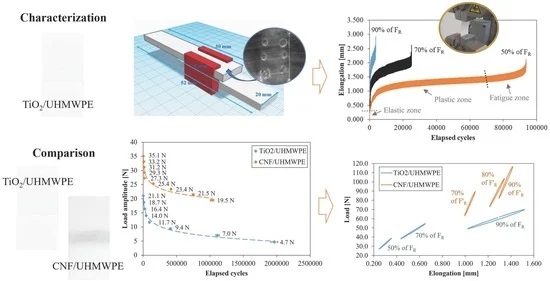
101) Polyurethane Foams Loaded with Carbon Nanofibers for Oil Spill Recovery: Mechanical Properties under Fatigue Conditions and Selective Absorption in Oil/Water Mixtures
A.Visco, A.Quattrocchi, D.Nocita, R.Montanini, A.Pistone
Nanomaterials
11(3),
735
- 2021
DOI:
https://doi.org/10.3390/nano11030735
Marine pollution due to spillage of hydrocarbons represents a well-known current environmental problem. In order to recover the otherwise wasted oils and to prevent pollution damage, polyurethane foams are considered suitable materials for their ability to separate oils from sea-water and for their reusability. In this work we studied polyurethane foams filled with carbon nanofibers, in varying amounts, aimed at enhancing the selectivity of the material towards the oils and at improving the mechanical durability of the foam. Polyurethane-based foams were experimentally characterized by morphological, surface, and mechanical analyses (optical microscopy observation, contact angle measurement, absorption test according to ASTM F726-99 standard and compression fatigue tests according to ISO 24999 standard). Results indicated an increase in hydrophobic behavior and a good oleophilic character of the composite sponges besides an improved selective absorption of the foam toward oils in mixed water/oil media. The optimal filler amount was found to be around 1 wt% for the homogeneous distribution inside the polymeric foam. Finally, the fatigue test results showed an improvement of the mechanical properties of the foam with the growing carbon filler amount.
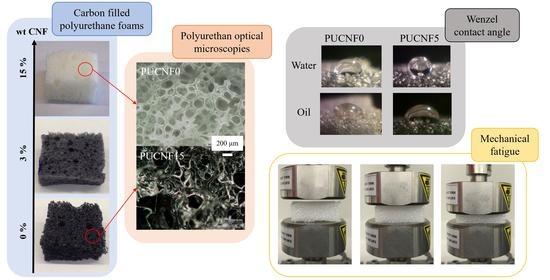
102) Tear N-glycomics in vernal and atopic keratoconjunctivitis
A.Messina, A.Palmigiano, C.Tosto, D.Romeo, L.Sturiale, D.Garozzo, A.Leonardi
Allergy
76(8),
2500-2509
- 2021
DOI:
https://doi.org/10.1111/all.14775
Purpose: Tear fluid
N-Glycome from patients affected with vernal (VKC) and atopic keratoconjunctivitis (AKC) was investigated to identify specific changes in tears and to recognize possible glyco-biomarkers.
Methods: The analysis of the
N-glycans was performed using matrix-assisted laser desorption ionization mass spectrometry on single tear samples. Tears from control normal subjects (CTRL), VKC and AKC patients were processed and treated with peptide
N-glycosidase F (PNGase F) to deglycosylate
N-glycoproteins. Released
N-glycans were purified, permethylated, and analyzed by matrix-assisted laser desorption/ionization-time of flight mass spectrometry and tandem mass spectrometry (MALDI-TOF MS and MALDI-TOF MS/MS).
Results: More than 150 complex
N-glycans, including highly fucosylated biantennary, triantennary, tetra-antennary, and bisecting species, were observed in our spectra. Three distinct patterns for CTRL, VKC, and AKC patients were identified in terms of relative intensities for some
N-glycans structures. Major variations involved bisecting and hyperfucosylated glycoforms.
The most intense ions were associated with species at
m/z 1907.0 (asialo, agalacto, bisected, biantennary structure-NGA2B) in CTRL MS profiles, at
m/z 2605.3 and 2966.5 in VKC, and at
m/z 2792.4 in AKC corresponding to a well-known biantennary, disialylated
N-glycan. Several peaks were associated with structures bearing one or two Lewis X epitopes. Structures were confirmed by MS/MS analysis. Quantitative differences among the three groups were statistically significant.
Conclusions: Tear MS profiles are rich in specific glycoforms, particularly those with a high fucosylation degree, indicating both core and peripheral decoration. Tear
N-glycome analysis provided important information for a better comprehension of VKC and AKC alterations at the molecular level.
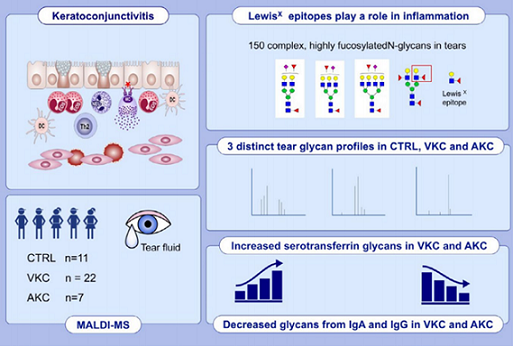
103) Thermo-mechanical, antimicrobial and biocompatible properties of PVC blends based on imidazolium ionic liquids
D.Zampino, M.Mancuso, R.Zaccone, T.Ferreri, A.Borzacchiello, S.Zeppetelli, S.Dattilo, M.Ussia, L.Ferreri, D.Carbone, G.Recca, C.Puglisi
Materials Science and Engineering: C
122,
111920
- 2021
DOI:
https://doi.org/10.1016/j.msec.2021.111920
The aim of this study was the development of antimicrobial polyvinylchloride (PVC) blends loaded with 0.1-10% (w/w) of the ILs 1-hexadecyl-3-methylimidazolium 1,3-dimethyl 5-sulfoisophthalate (HdmimDMSIP) and 1-octyloximethyl-3-methylimidazolium hexafluorophosphate (OOMmimPF6). The synthetized ILs were characterized by 1HNMR, MALDI-TOF, DSC and TGA. PVC/ILs films were obtained by solvent casting.Thermal and mechanical properties (tensile stress TS and elongation at break EB), morphology by SEM, surface wettability, antimicrobial activity, cytotoxicity and ILs release in sterile water from PVC/ILs film blends were determined. Results demonstrated that the presence of both ILs in PVC formulation slightly affected thermal and mechanical properties of blends. The loading of both ILs into PVC matrix made PVC/ILs films hydrophilic, especially at the highest concentration of HdmimDMSIP. The PVC/ILs blends displayed antibacterial activity up to ILs lowest concentrations (0.1-0.5%). The inhibition of Escherichia coli growth was lower than that showed toward Staphylococcus epidermidis. The addition of 10% ILs concentration resulted excessive as demonstrated by accumulation of ILs on film surfaces (SEM) and ILs high release from PVC/ILs blends during the first day of water immersion. Biocompatibility studies highlighted that the addition of low amounts of both ILs into PVC matrix is not cytotoxic for mouse fibroblast cells (L929), supporting their potential use for biomedical porposes.
 Top
Top



























































